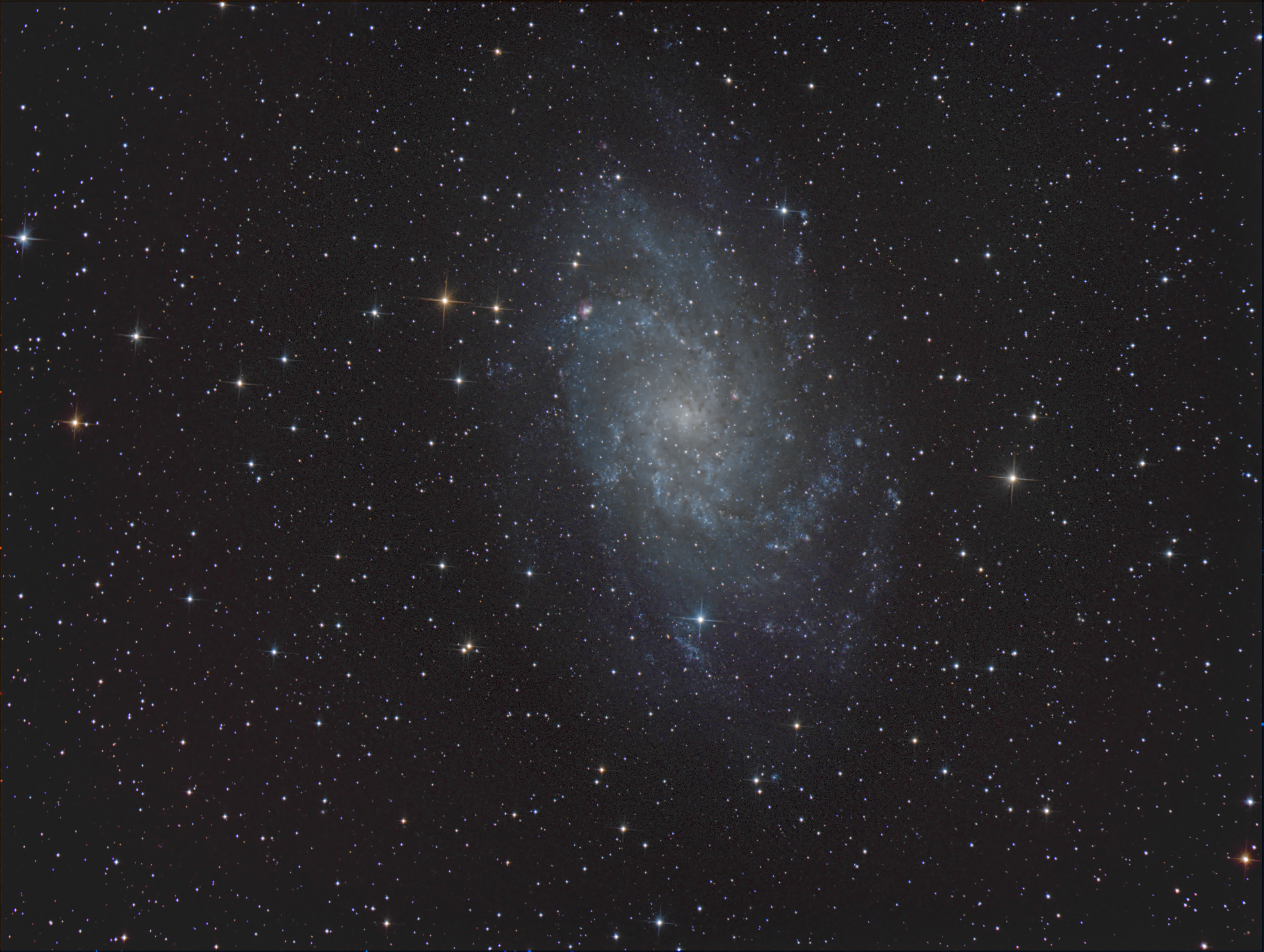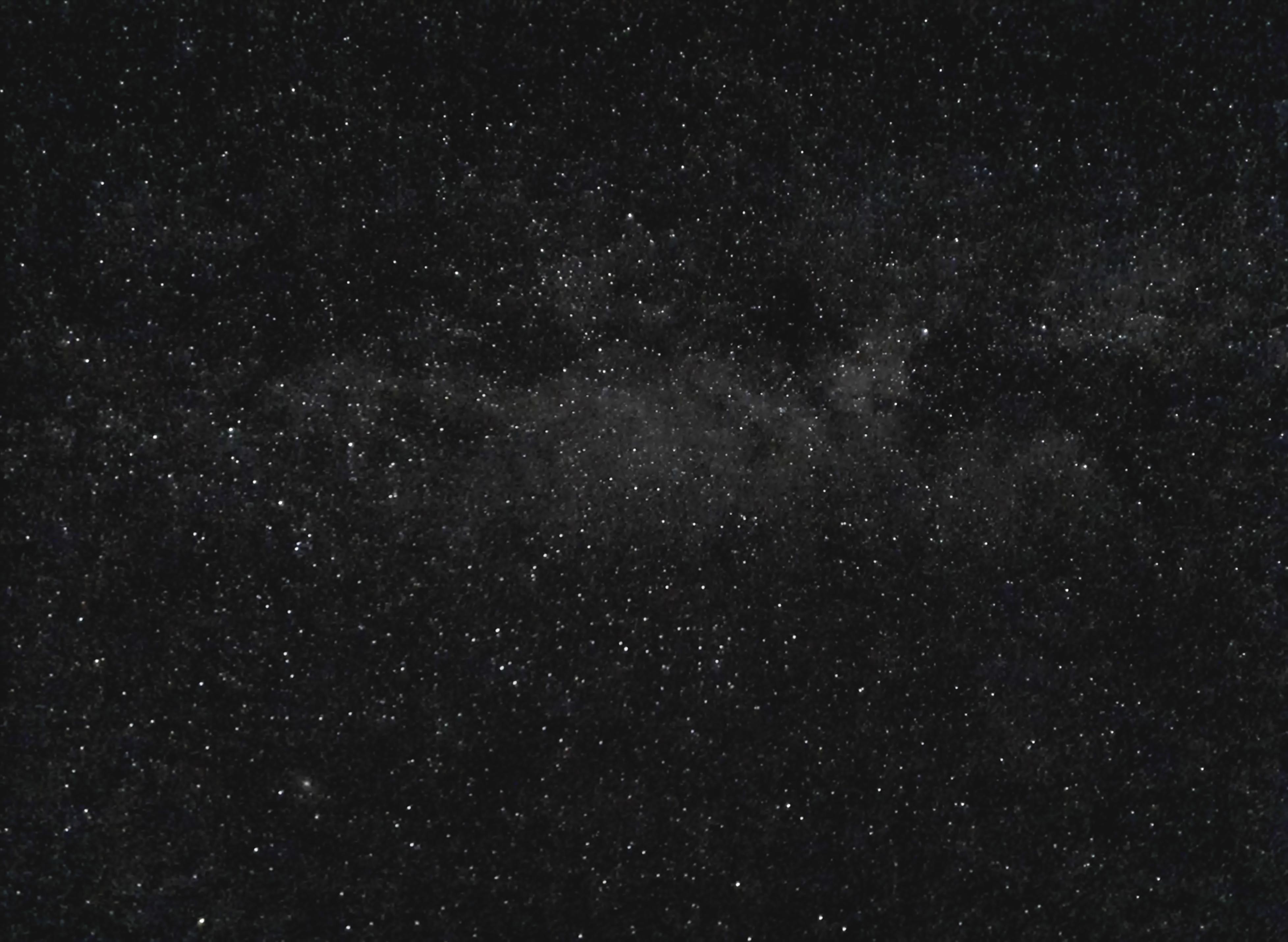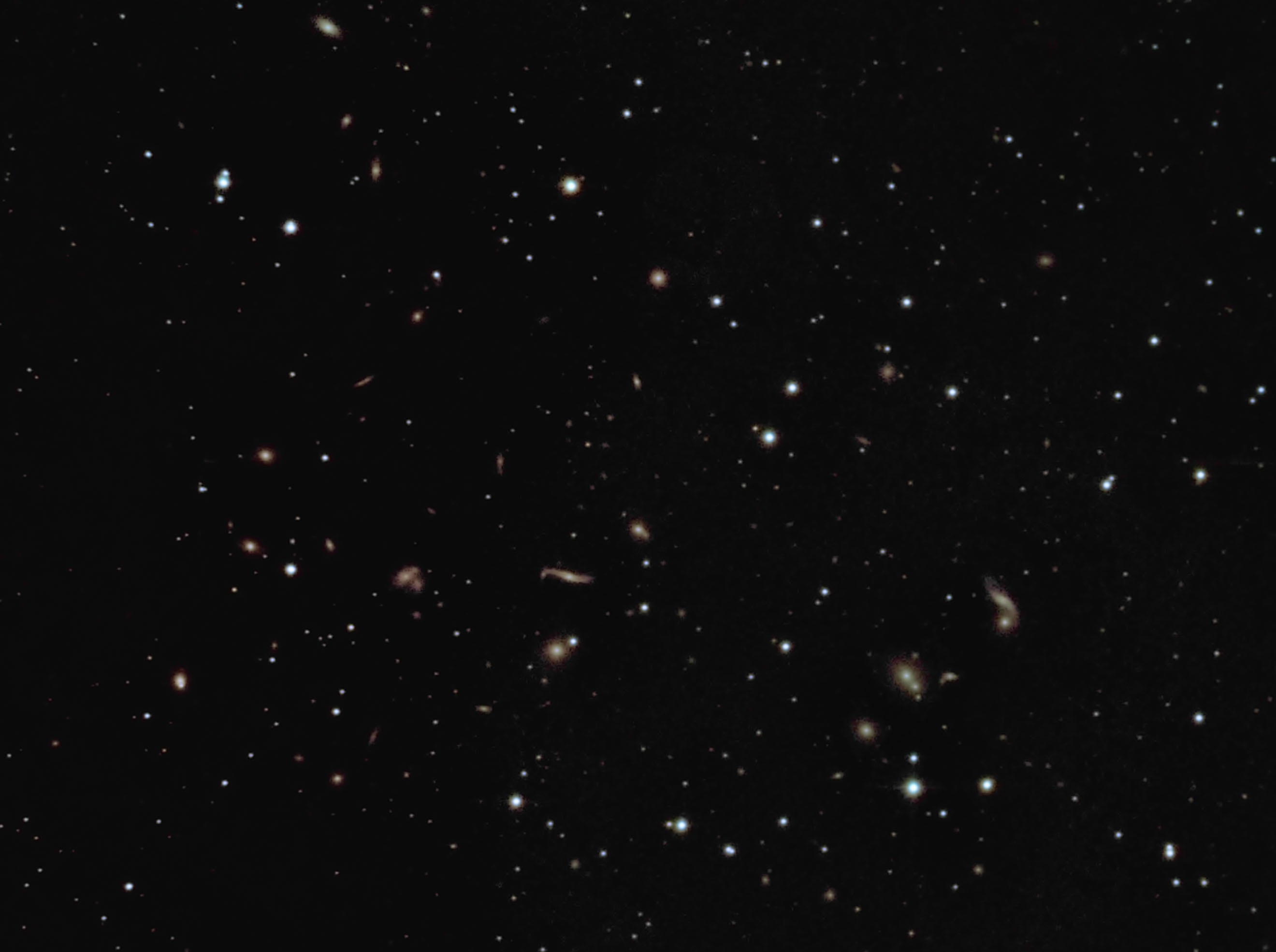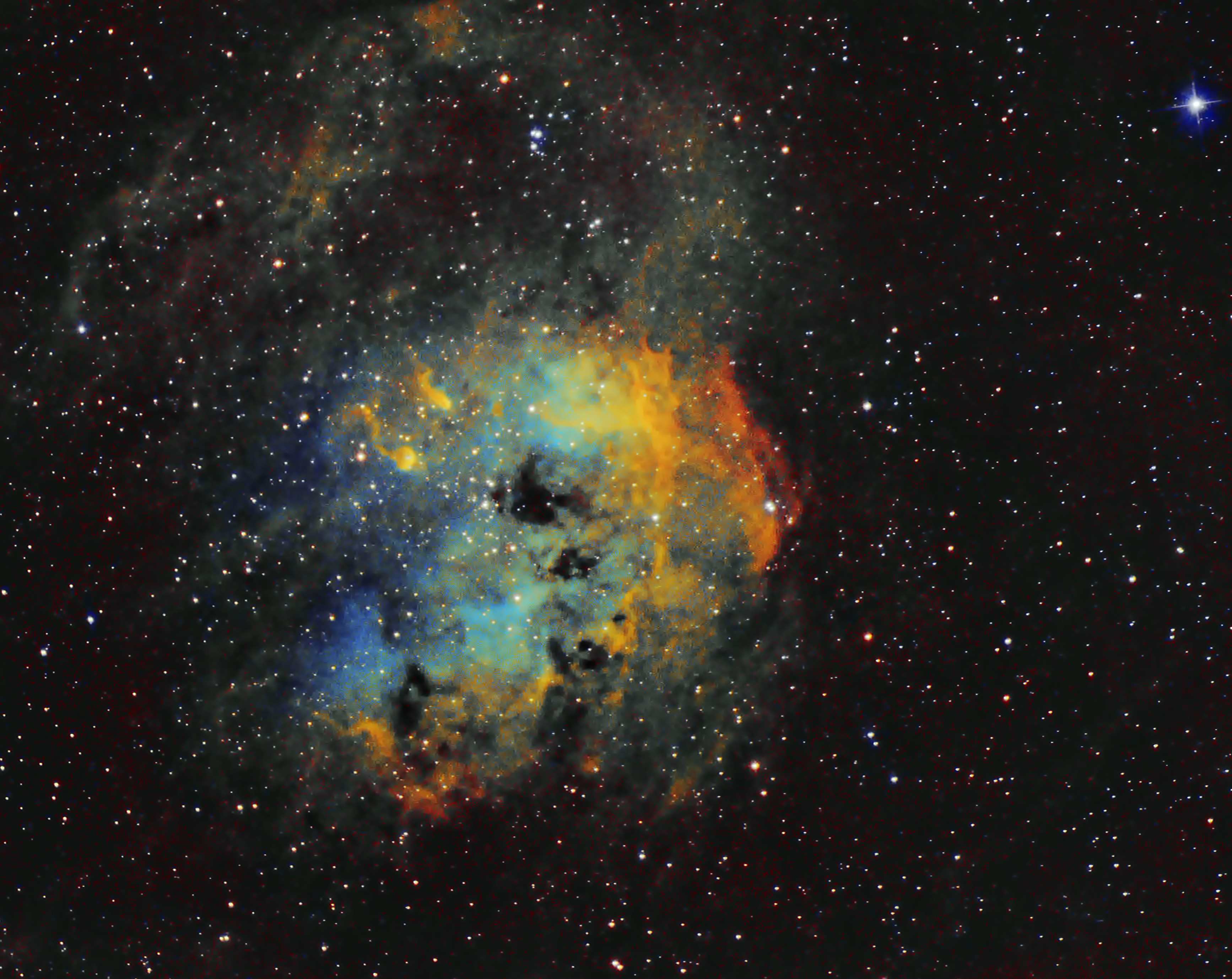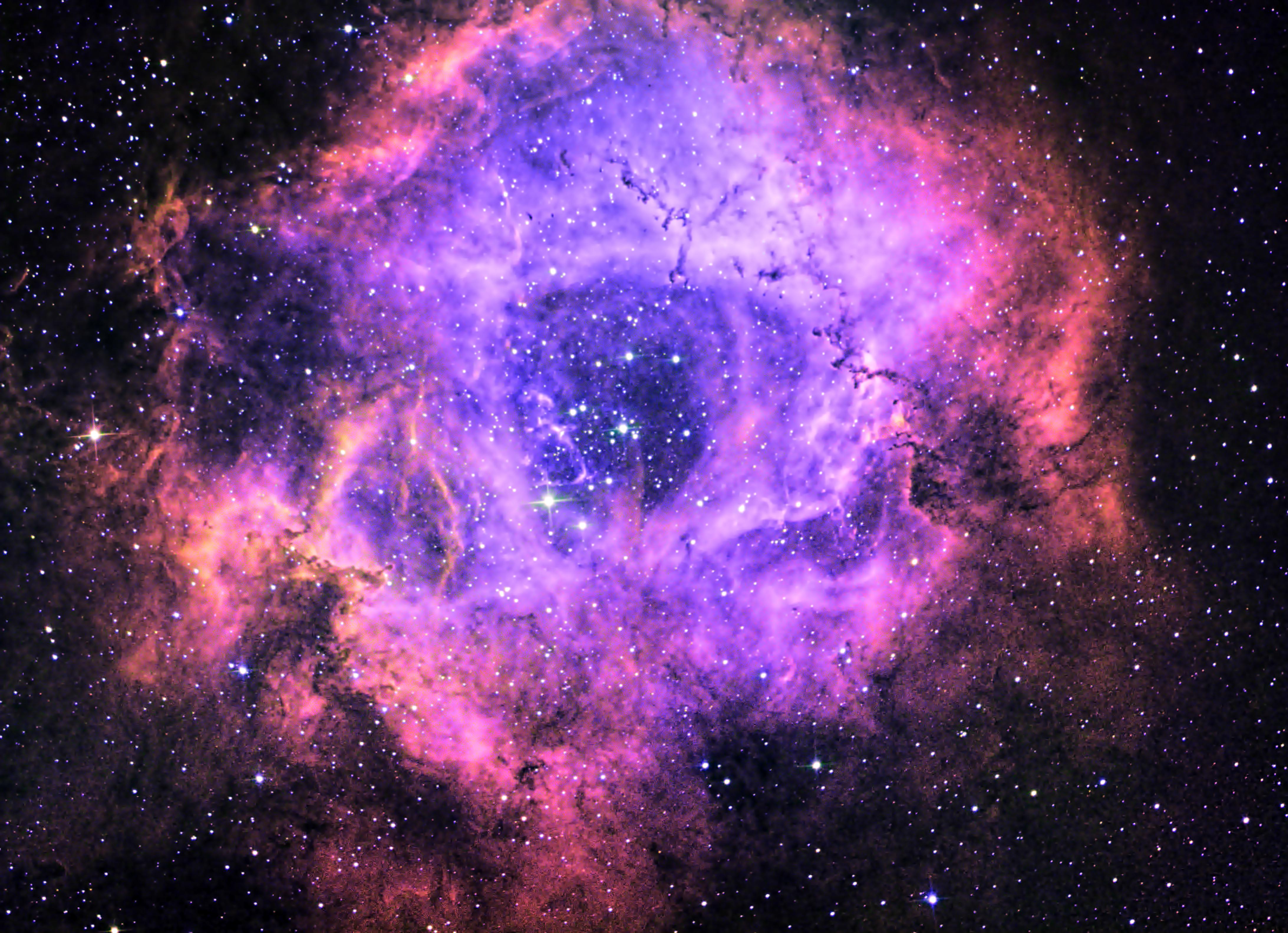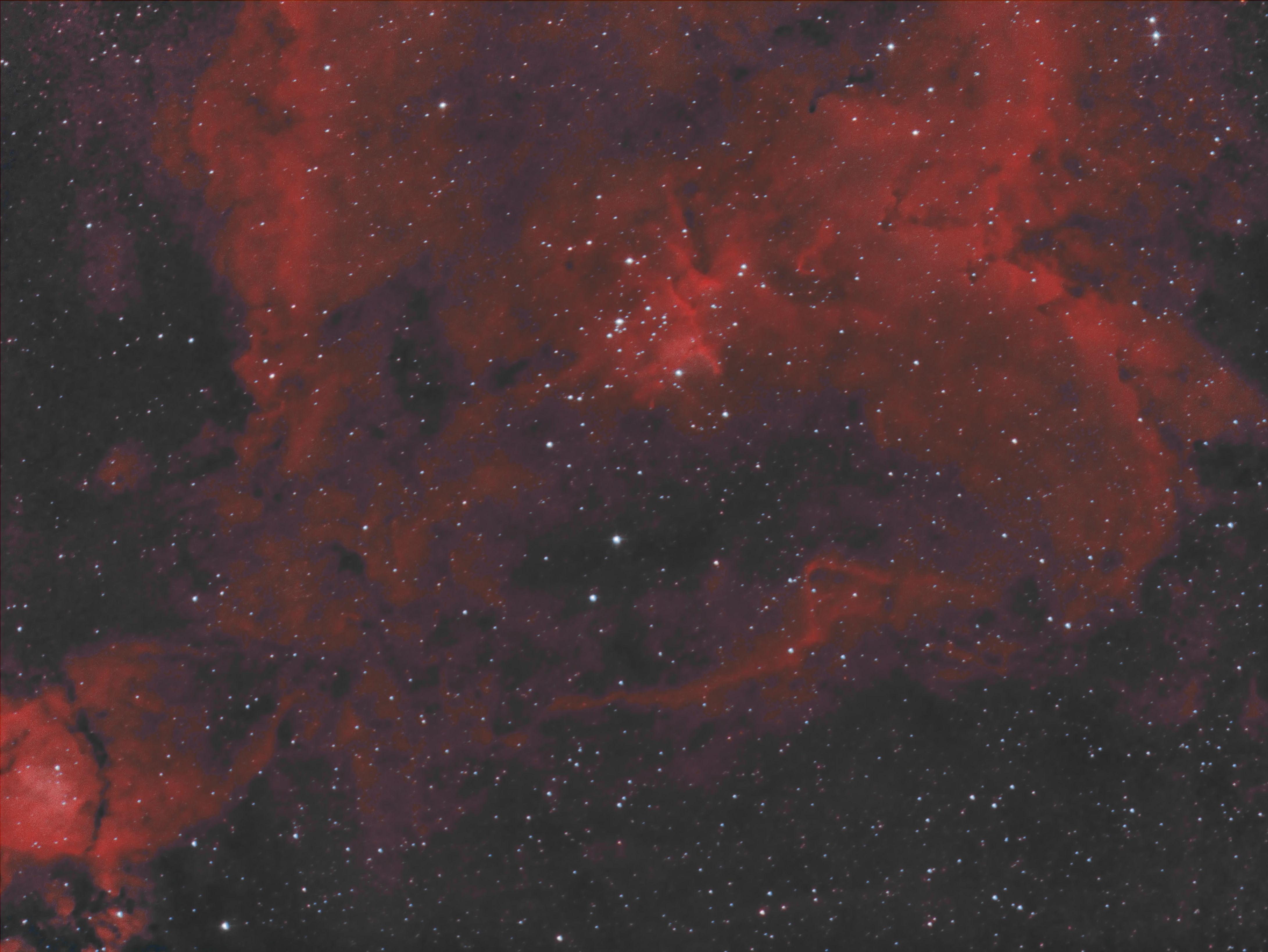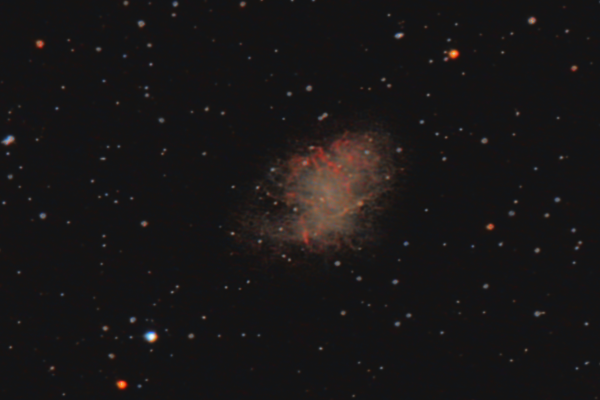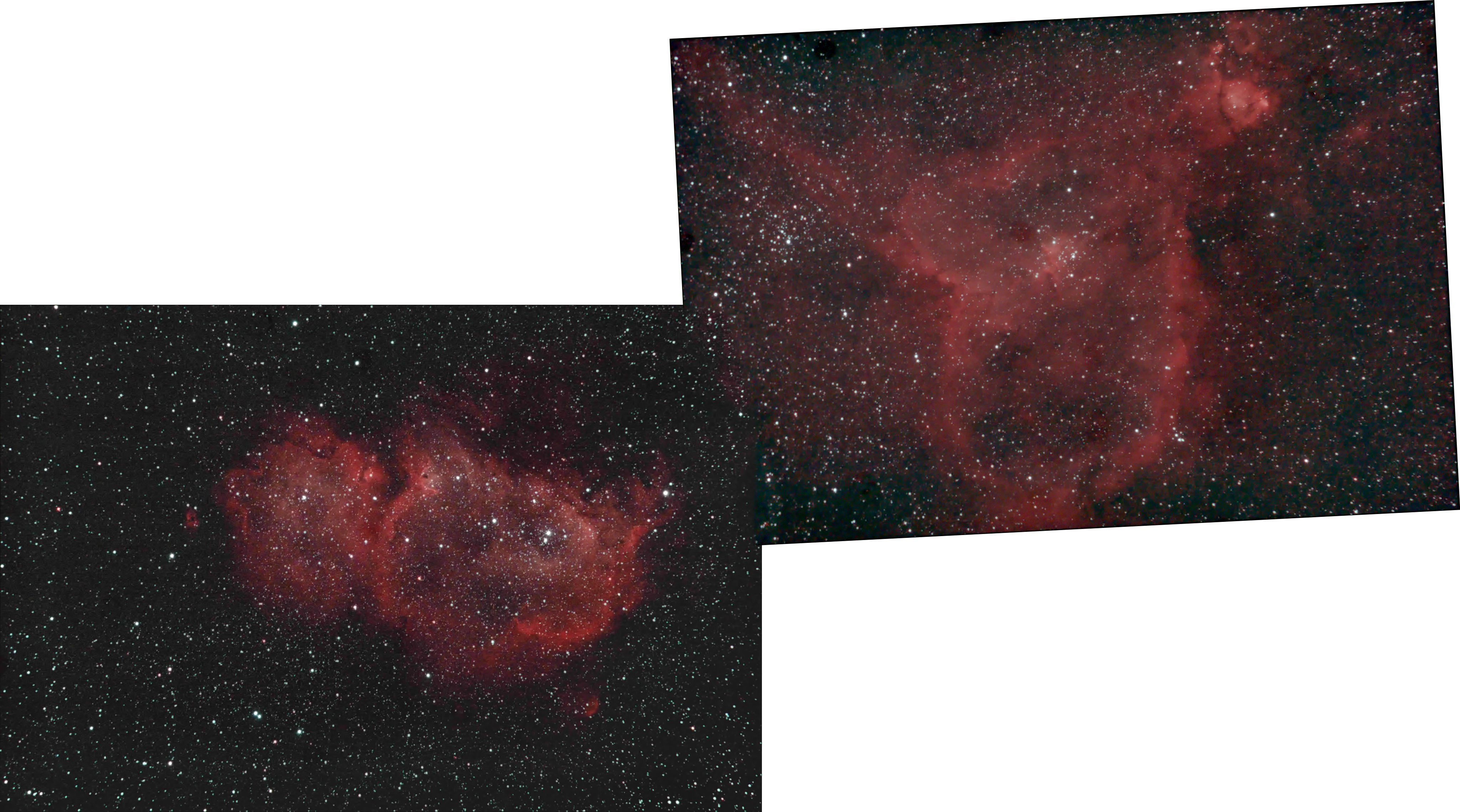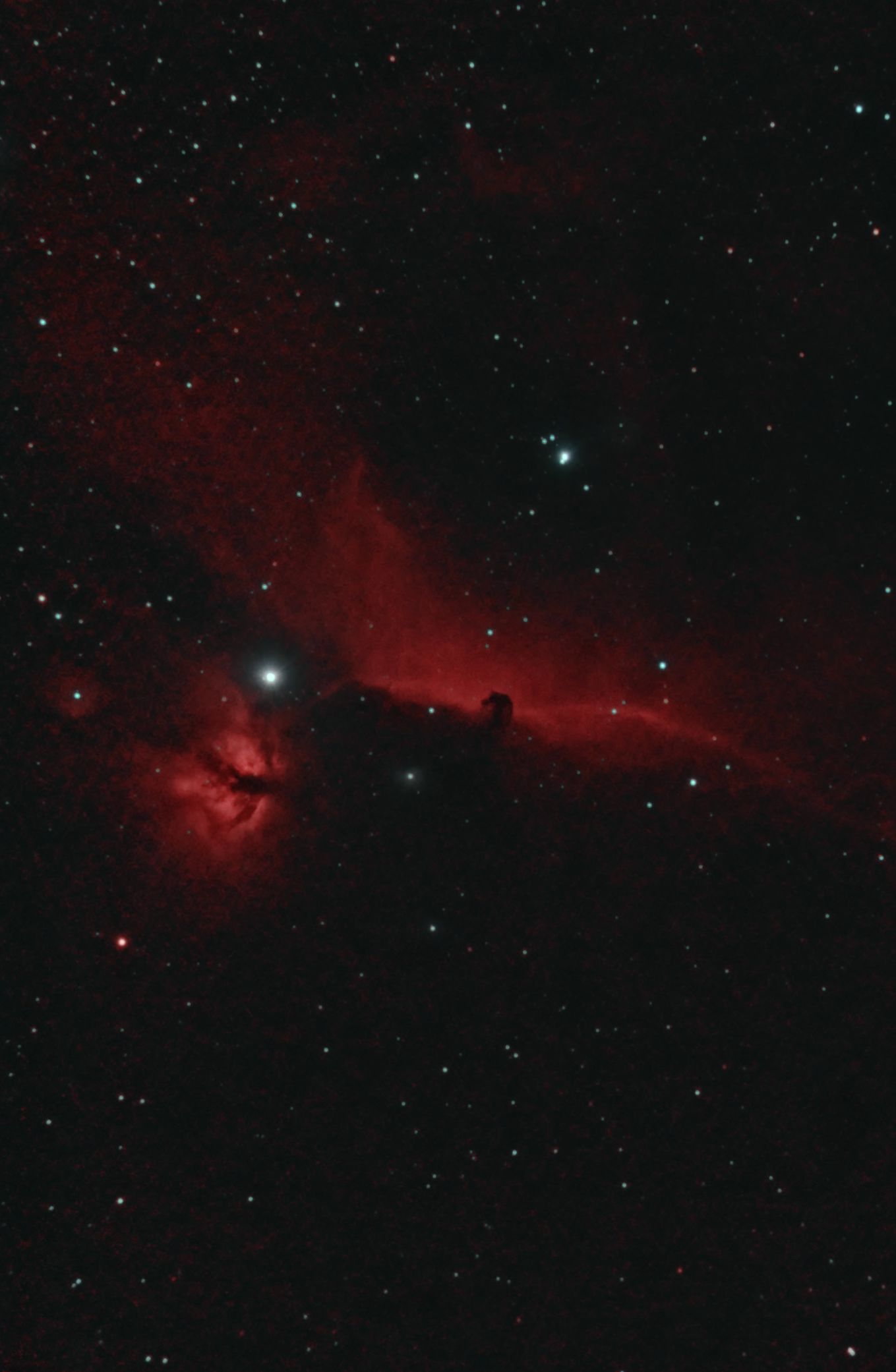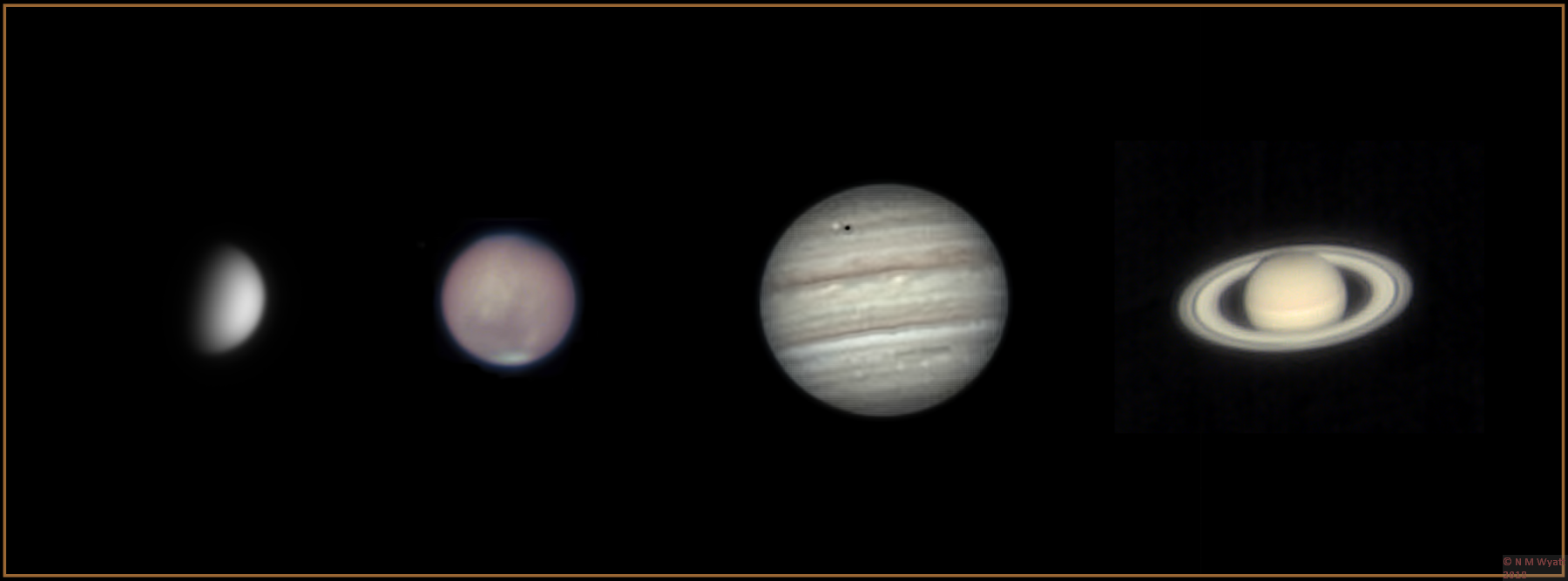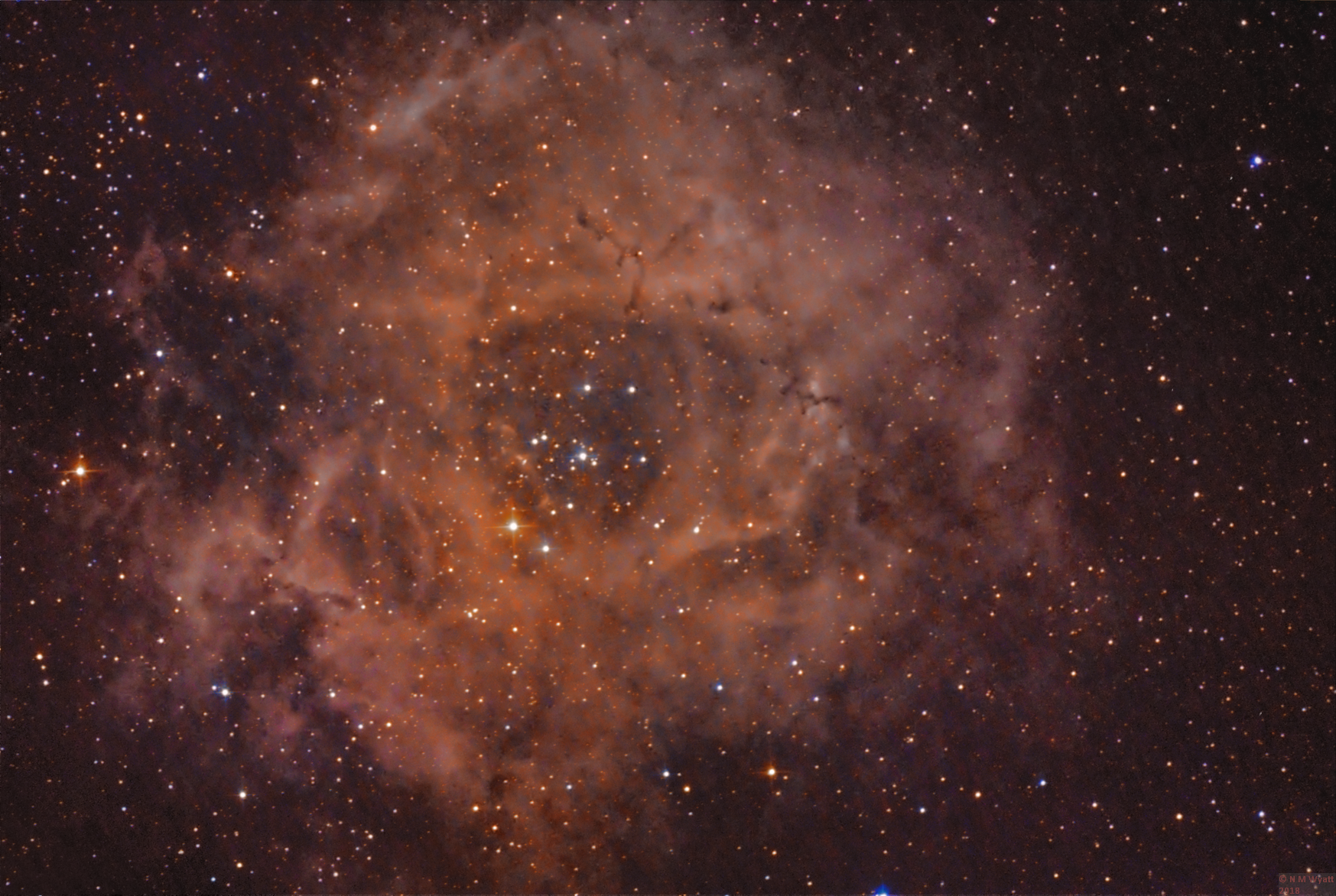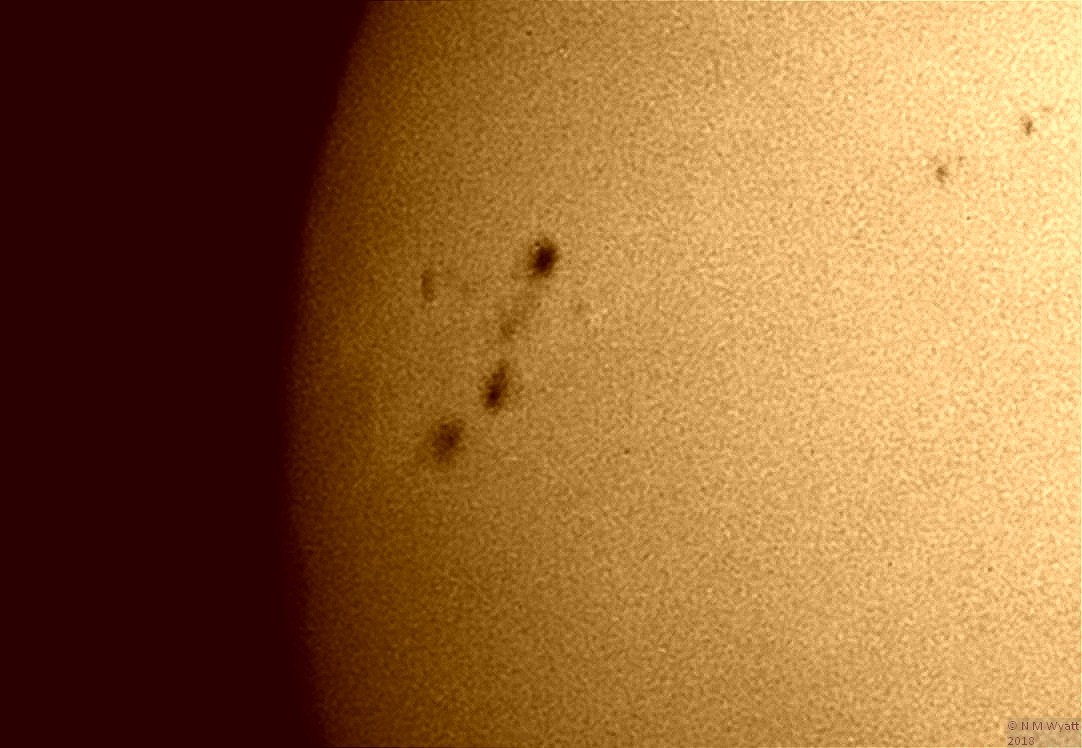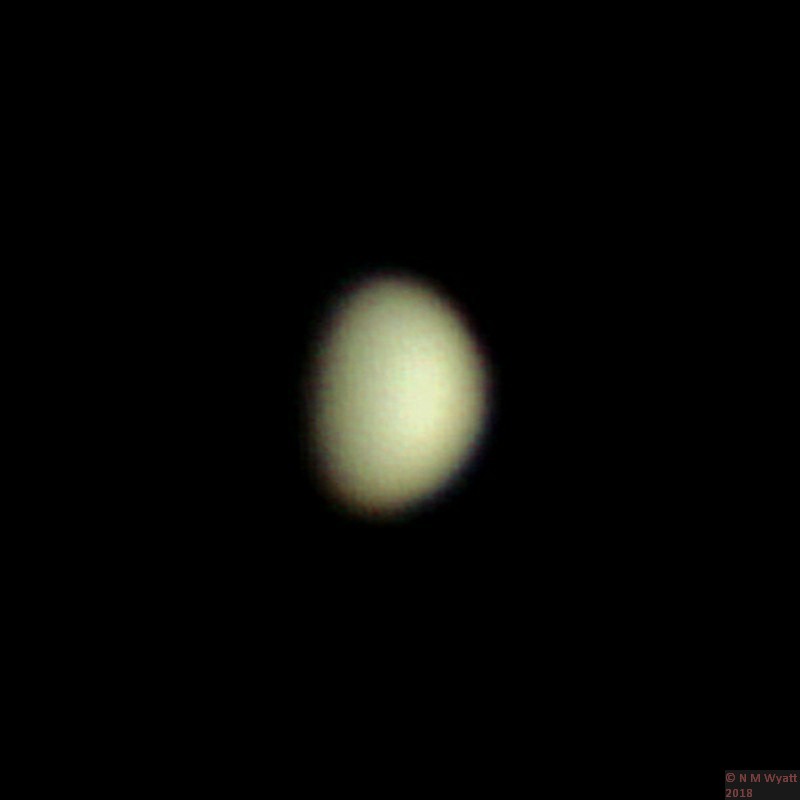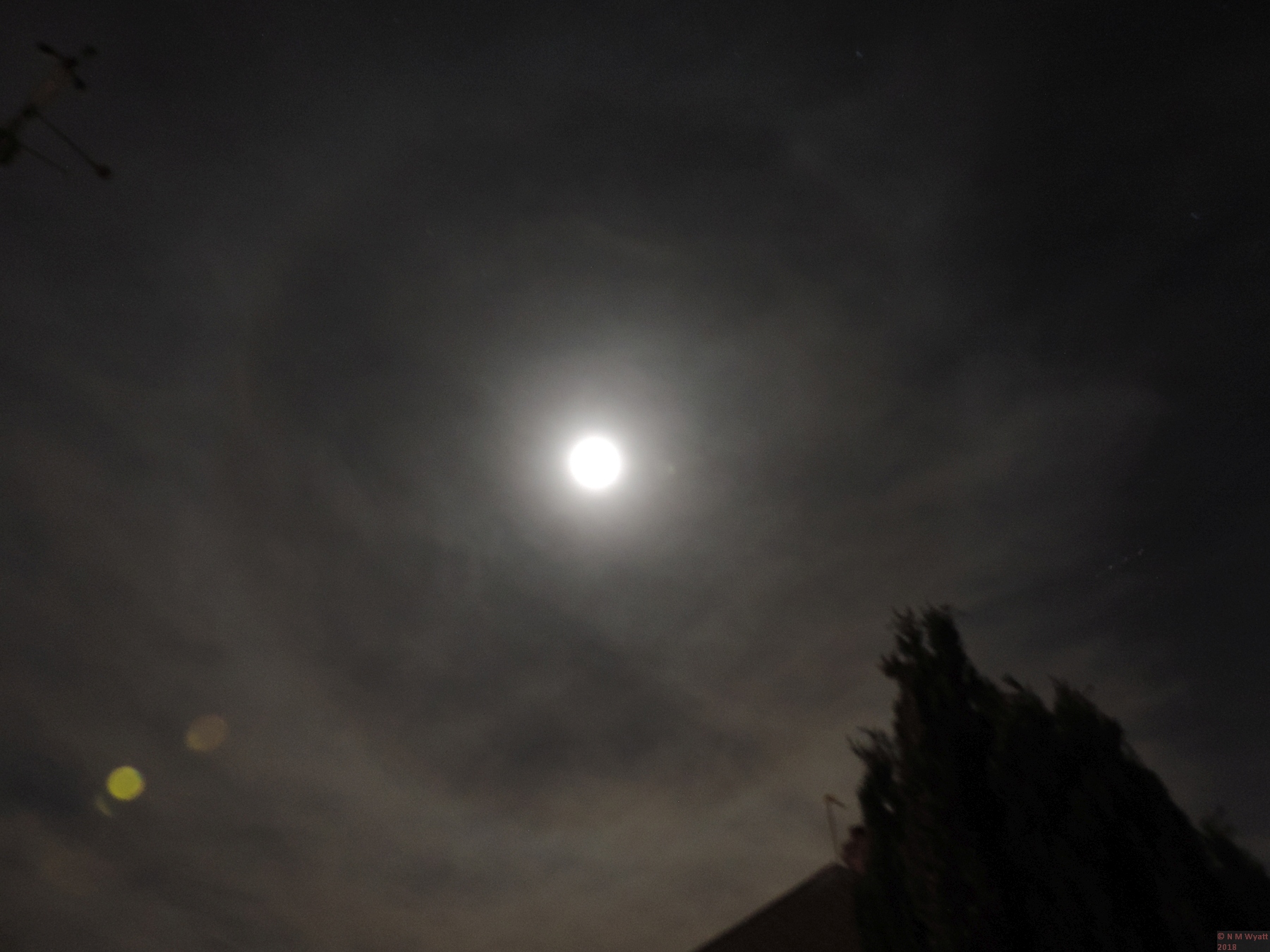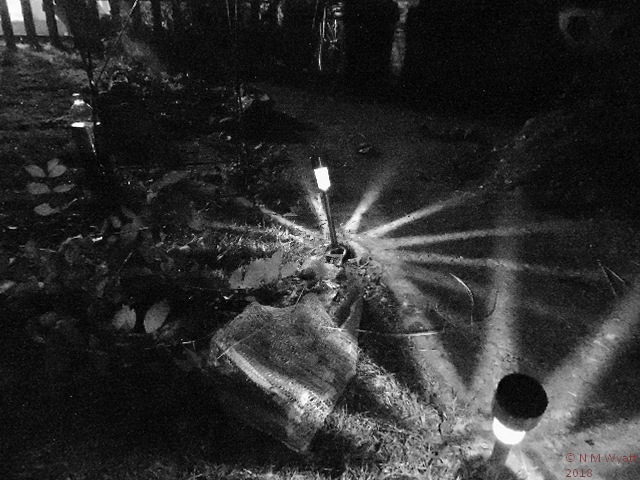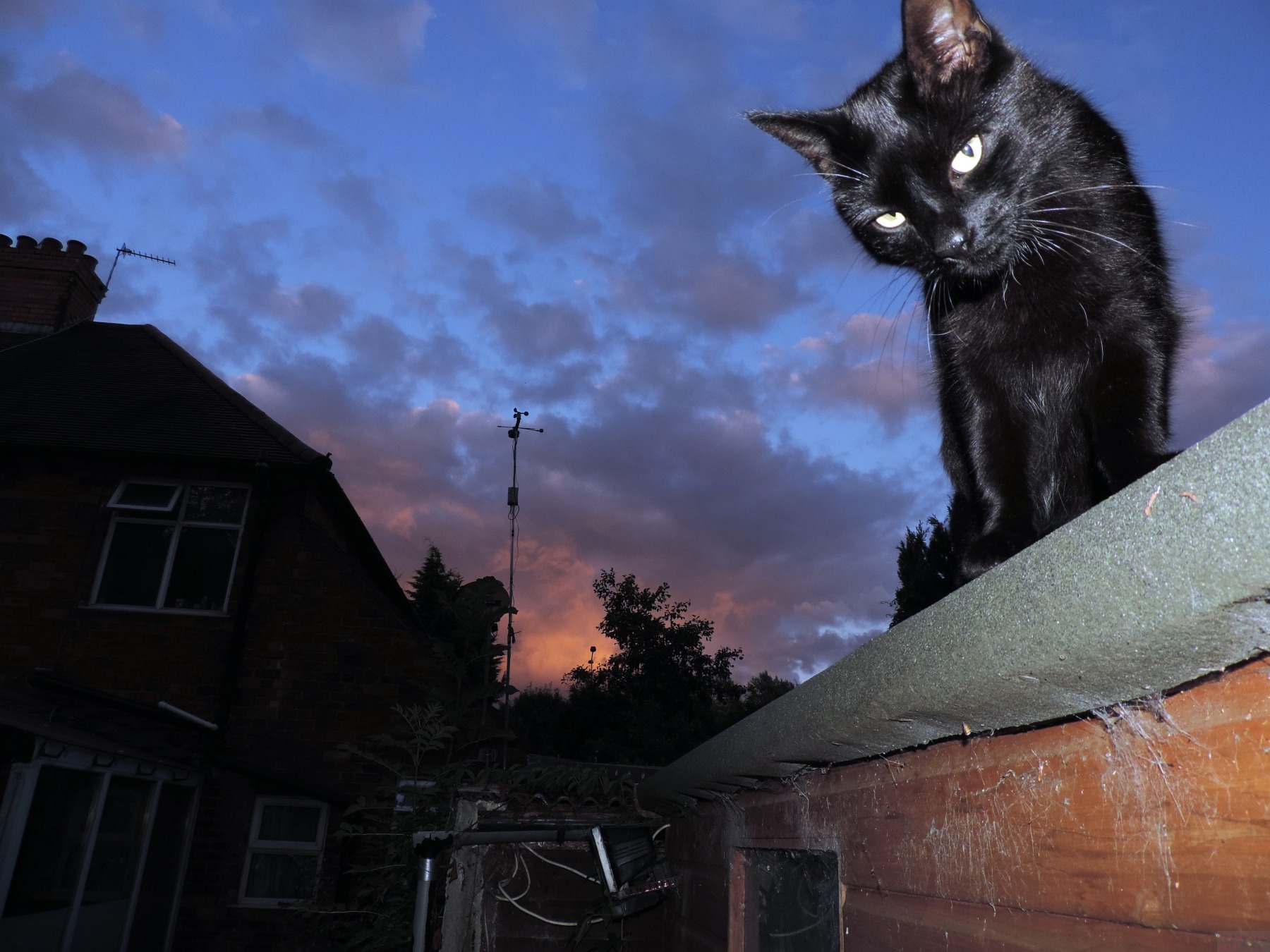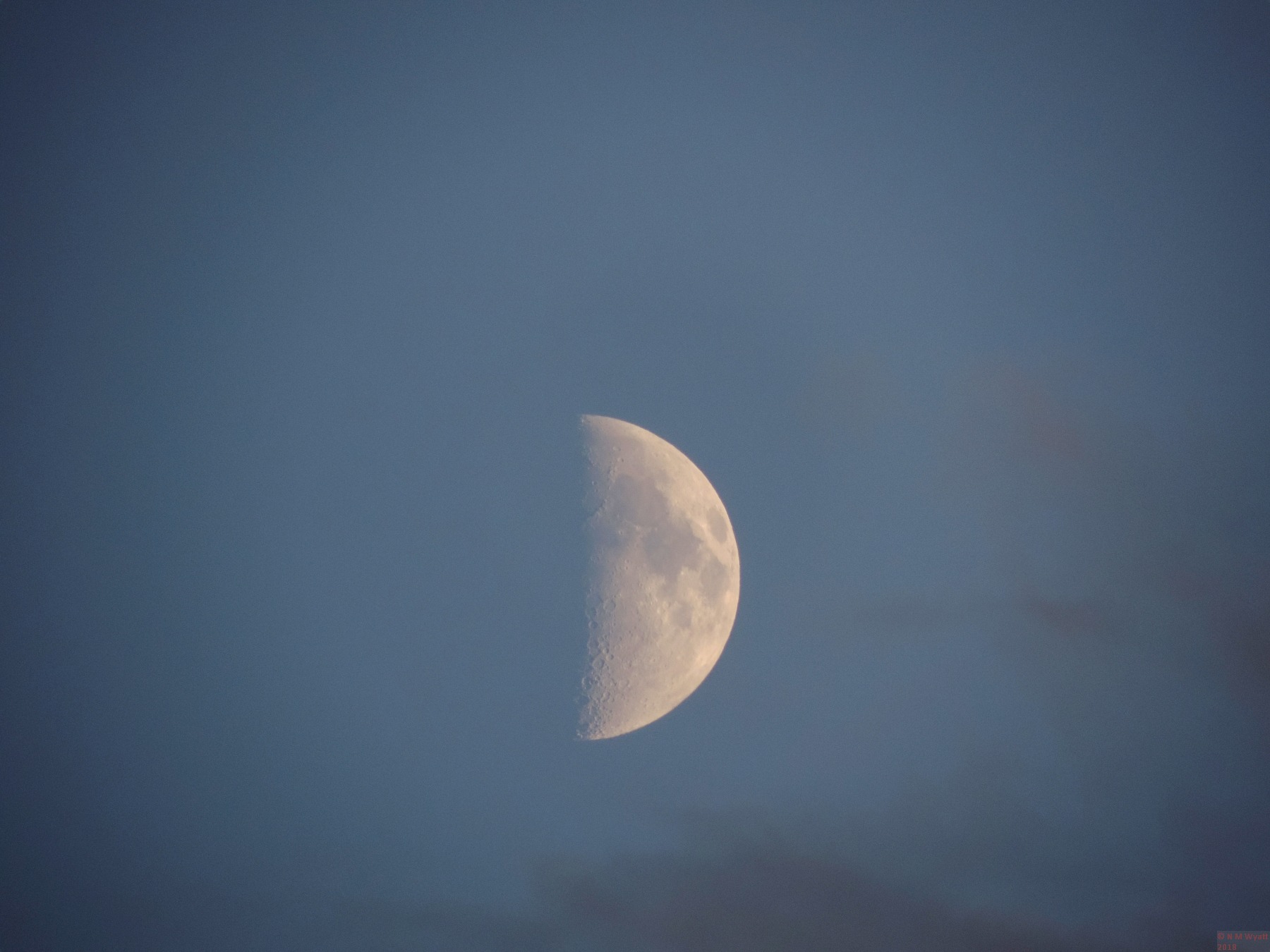If you find this website useful, please check out my books or visit my Amazon Author page. Or even Buy Me a Coffee!
Images of the Month
Images of the Month
Since around late 2015, each month I have put my favourite image from the previous month on the home page. I later went back and selected my best monthly images from 2014 and early 2015.
I hope you find it interesting to see how my imaging skills have improved over the years, as my equipment and experience have grown.
2021 : 2020 : 2019 : 2018 : 2017 : 2016 : 2015
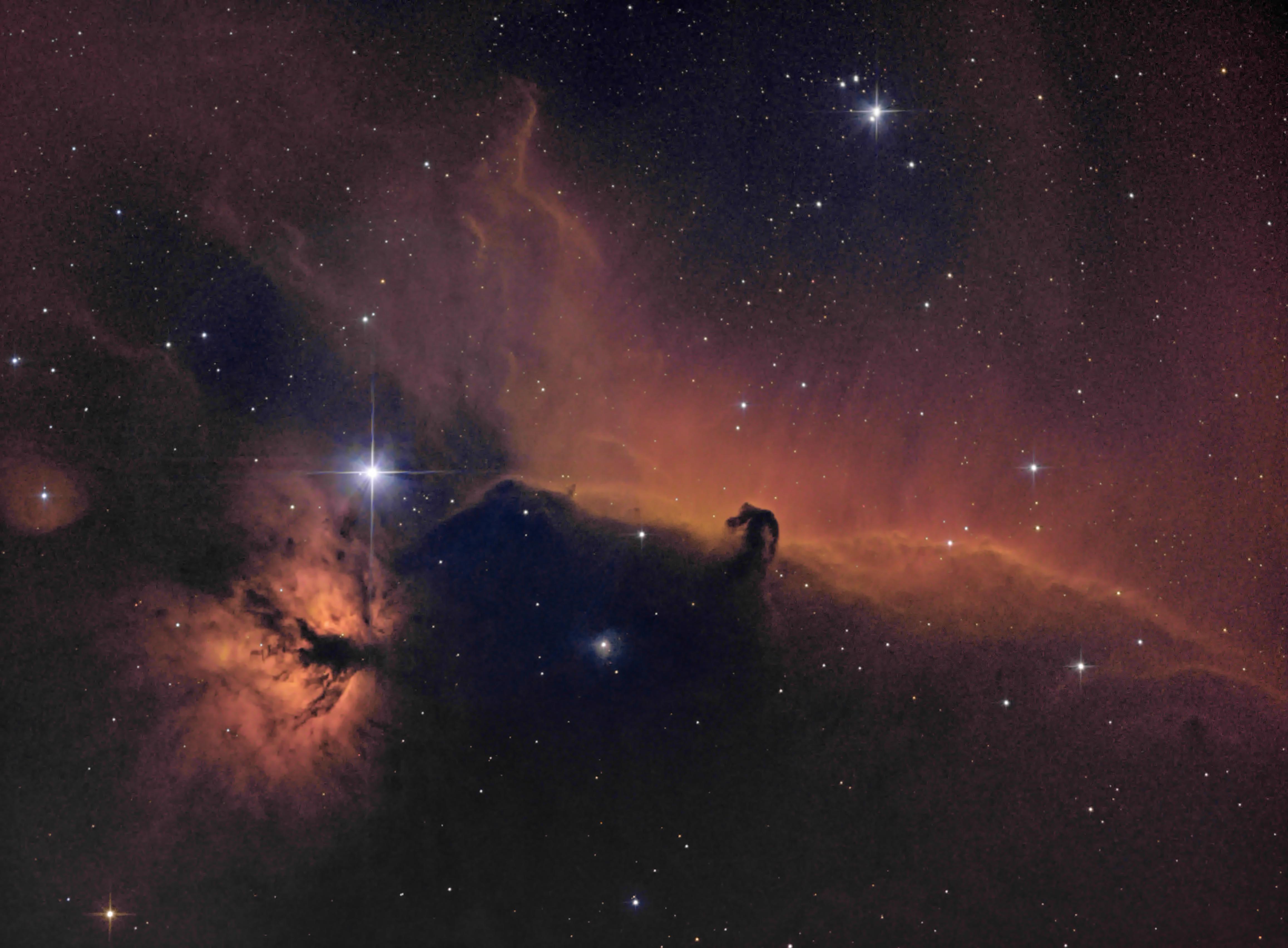
Here's the home of 2021's 'Image of the Month' pictures. Enjoy!
2021 : 2020 : 2019 : 2018 : 2017 : 2016 : 2015
Image of the Month for October 2021: The Threadgate Star Party.
Something a bit different this month, a selection of my images from a very special star party organised by a bunch of astro rebels - You know who you are folks! 😎
The Elephant's Trunk Nebula:
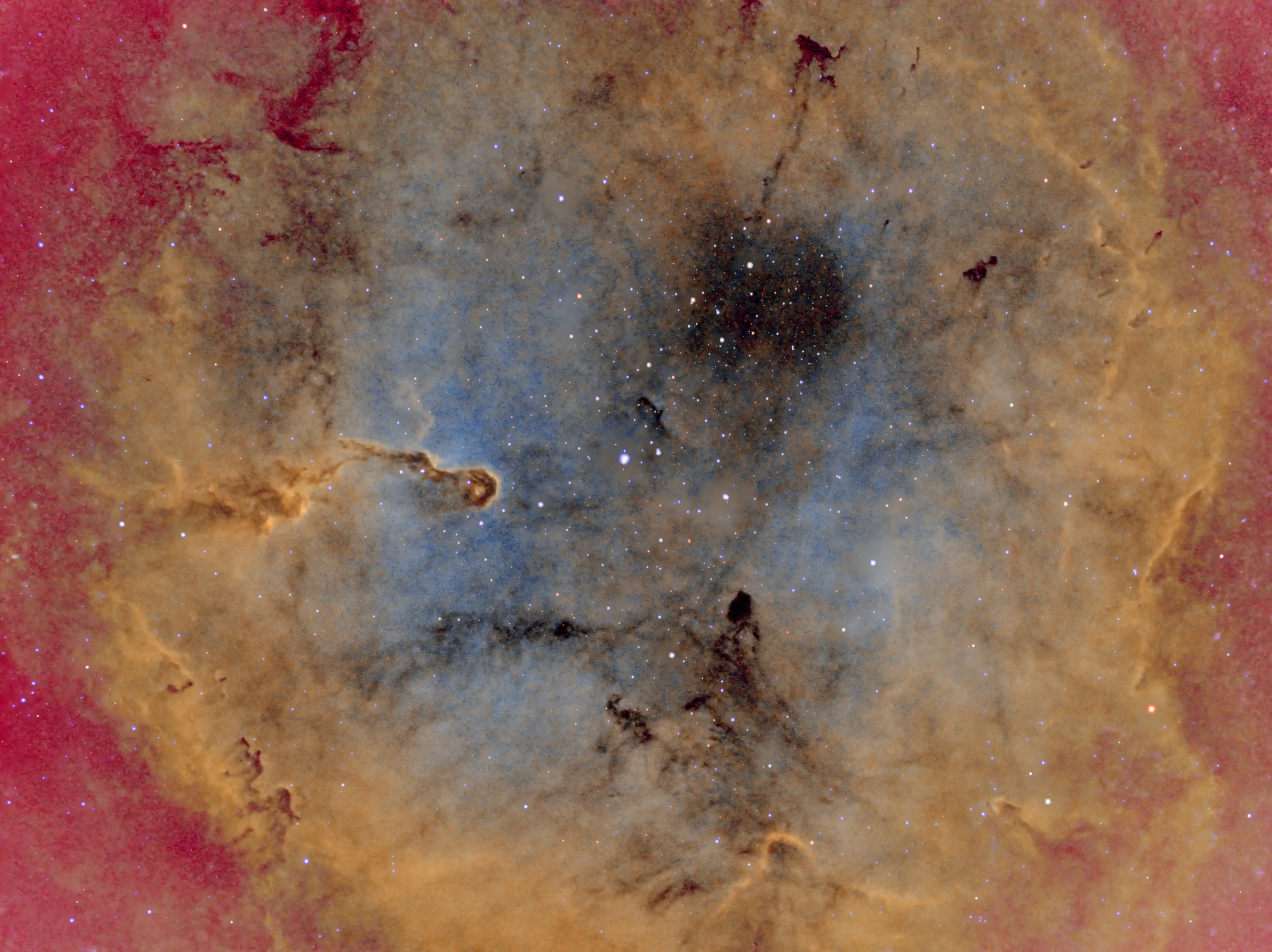
Sunspots:
Heart Nebula:
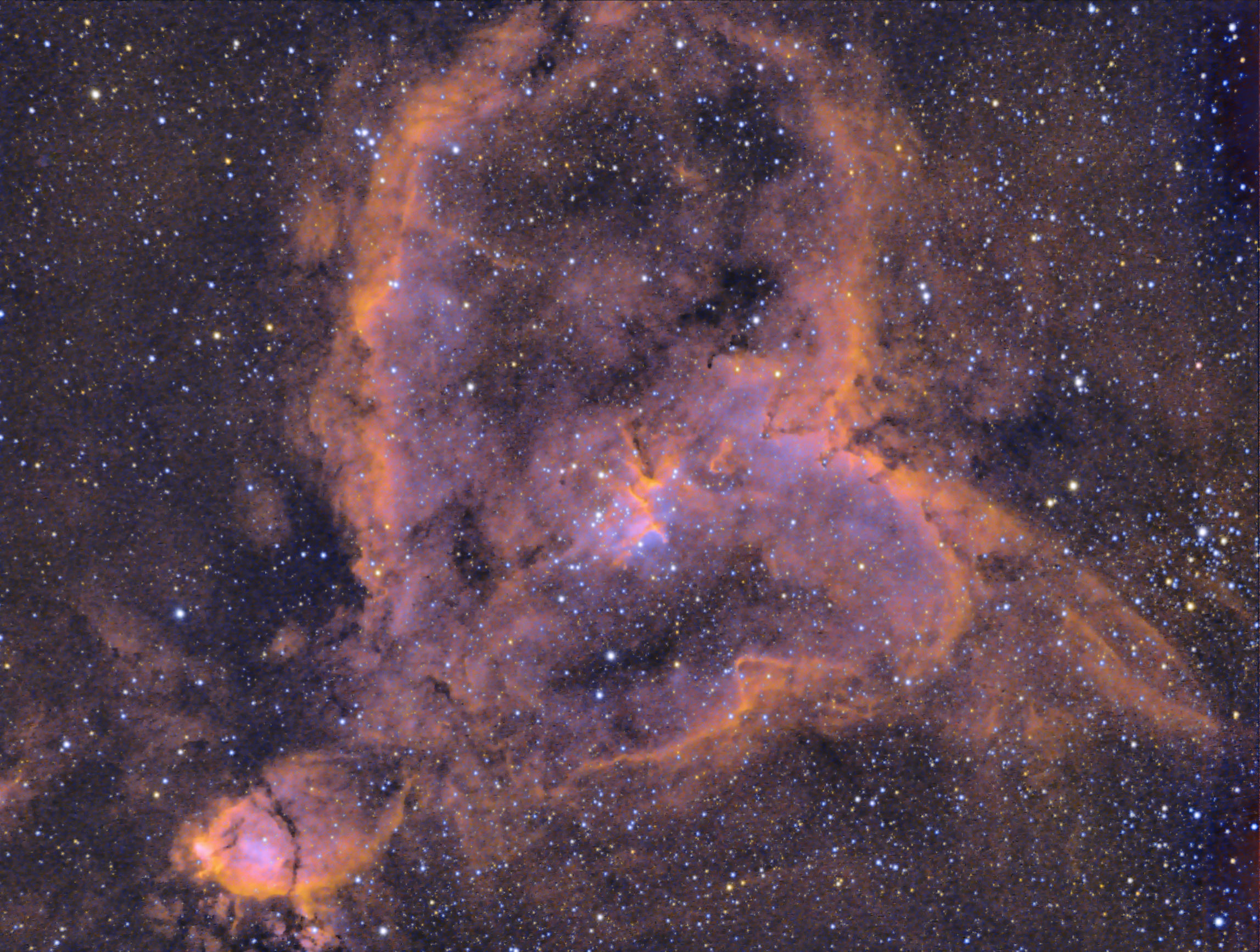
Bubble Nebula and Friends:
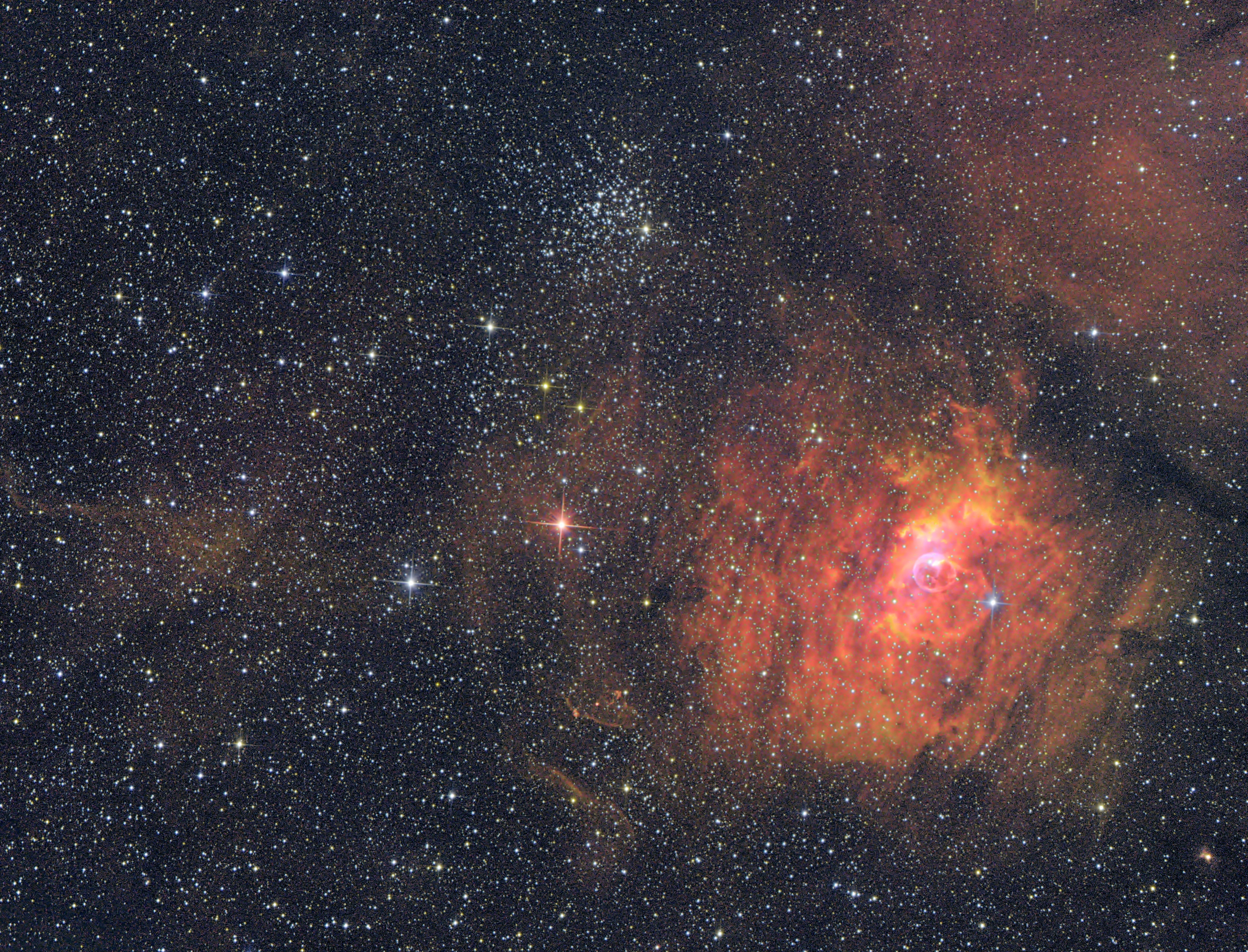
Triangulum Galaxy, M33:
Nightscape (single exposure with Samsung Galaxy A51):
The Milky Way (Single exposure with Samsung Galaxy A51):
Image of the Month for September 2021: Saturn and its four largest moons.
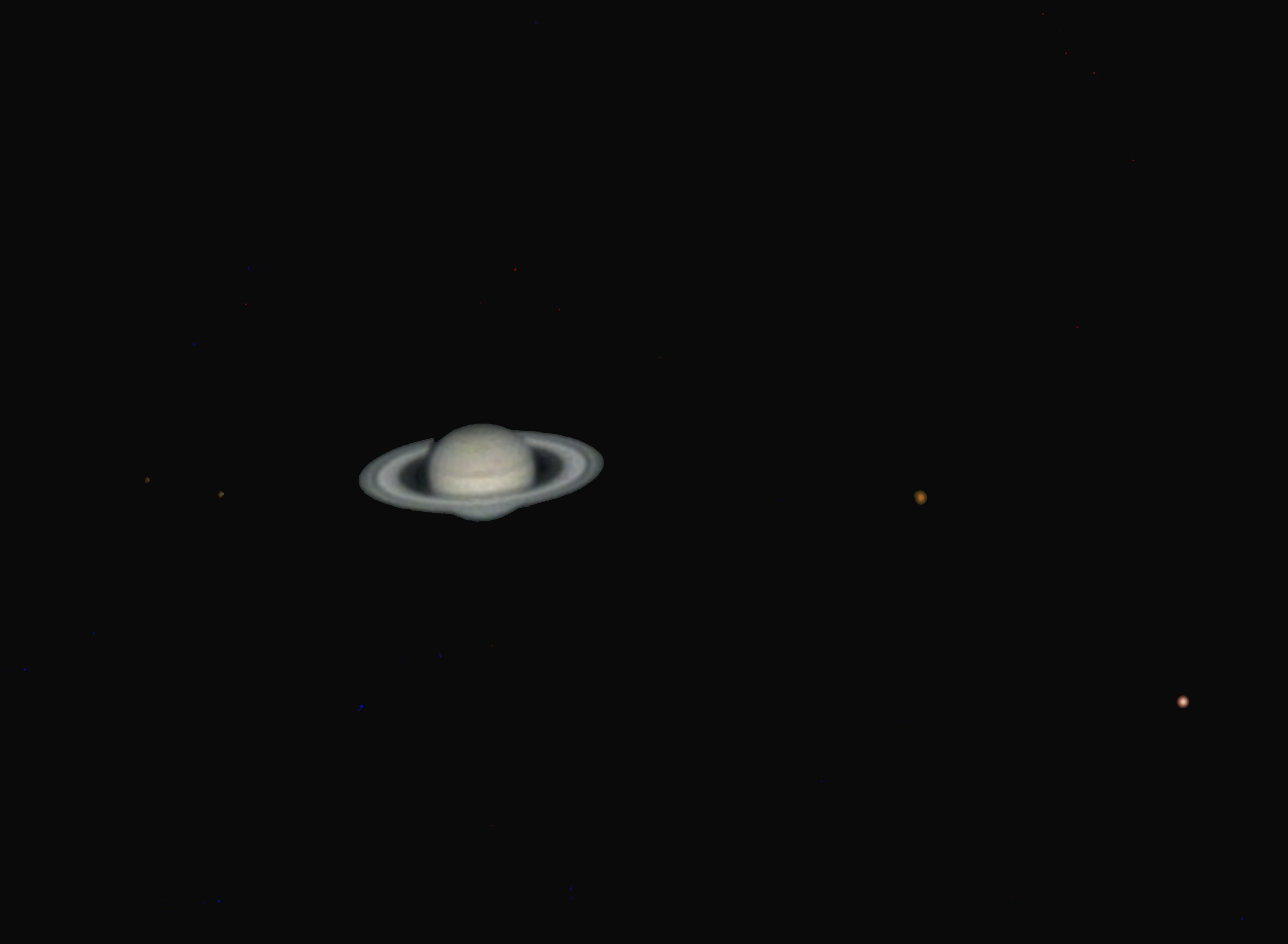
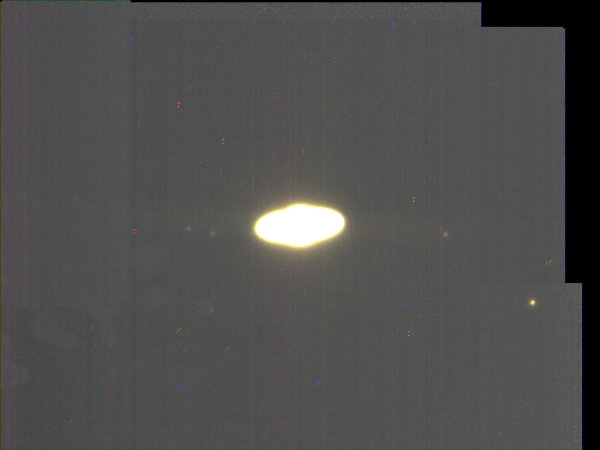
Image of the Month for August 2021: Eagle Nebula, M16 with the Pillars of Creation
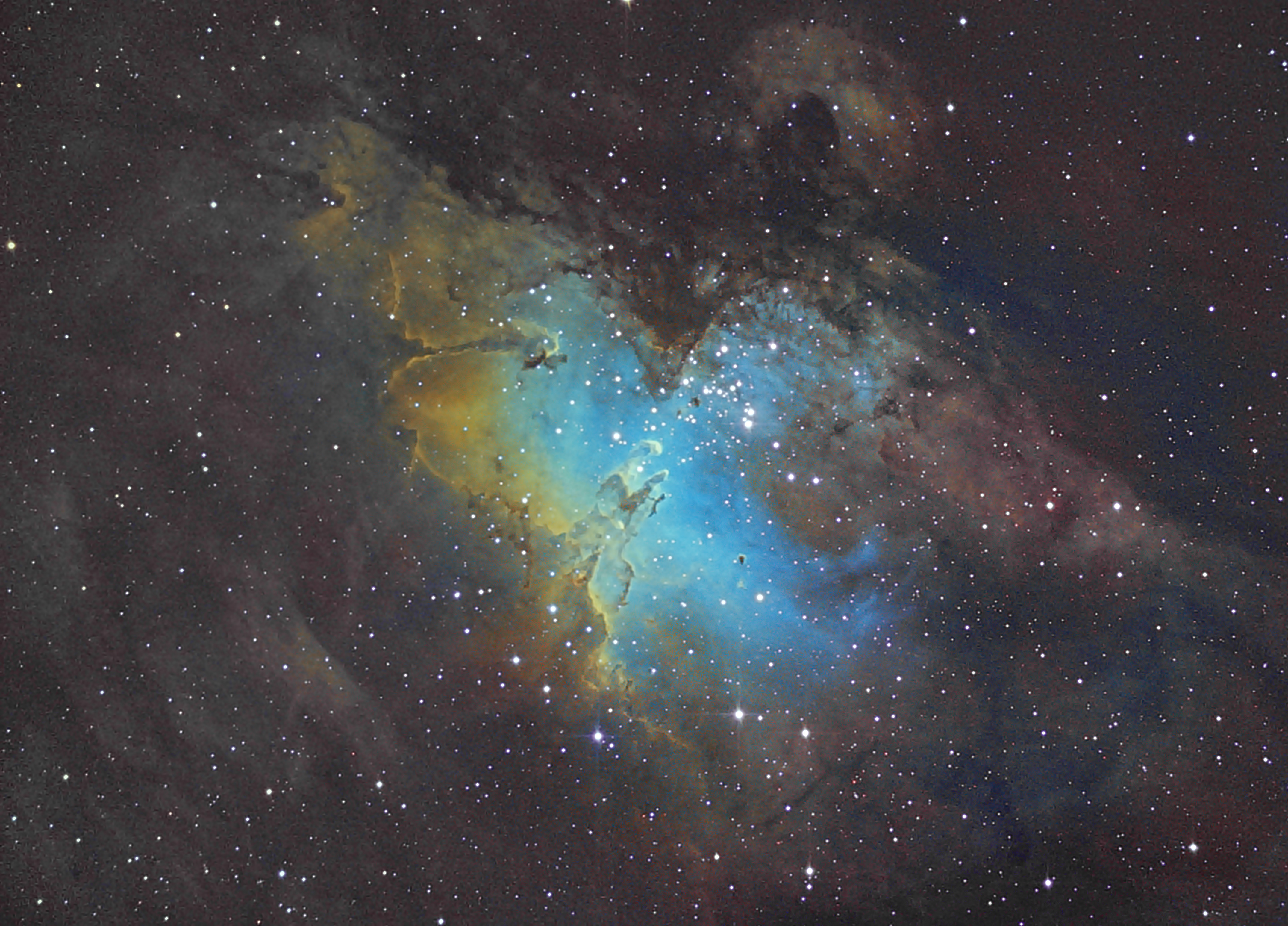
Image of the Month for July 2021: The Sadr Region Nebula
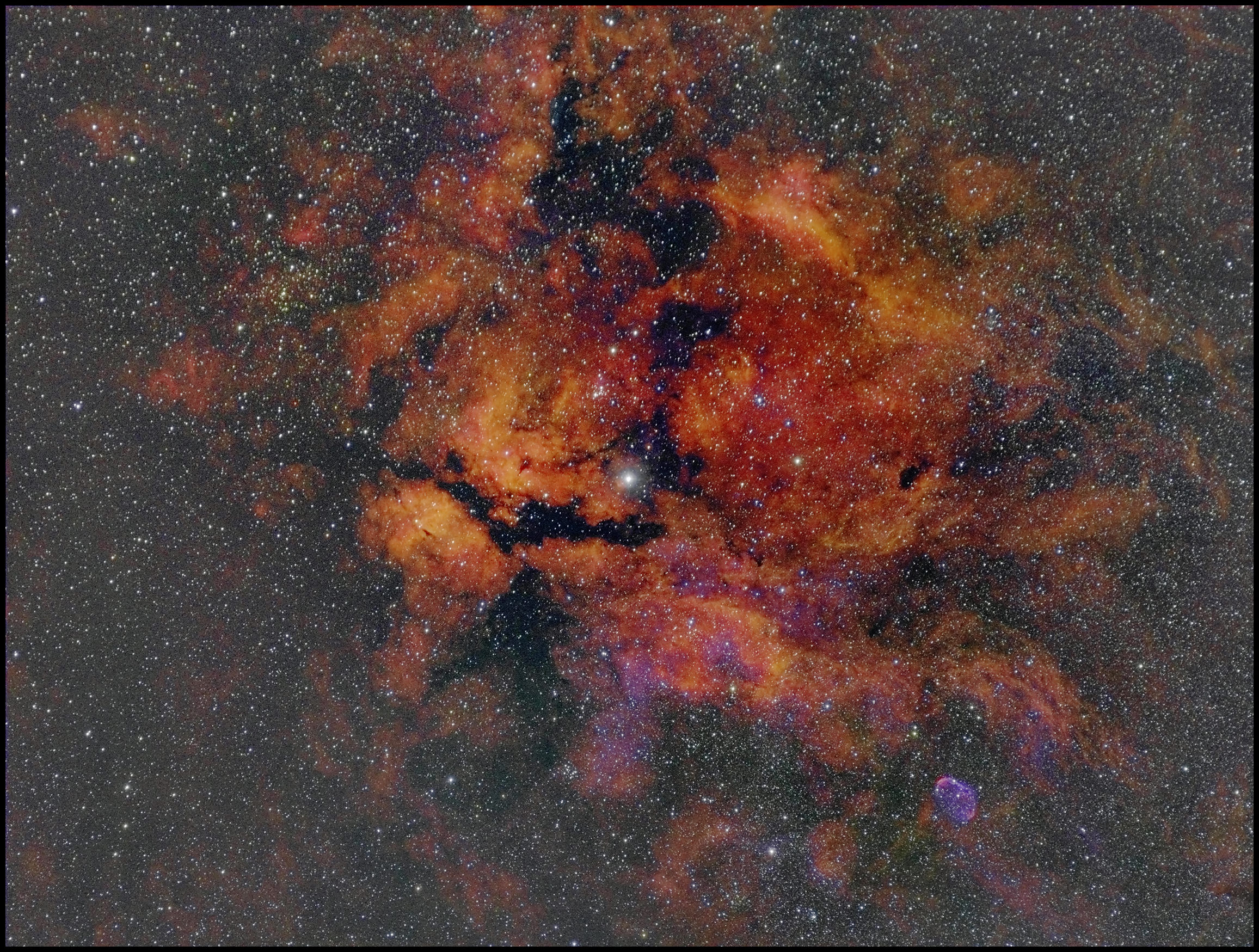
Image of the Month for June 2021: The Hercules Galaxy Cluster
Image of the Month for May 2021: The Tadpoles Nebula
Image of the Month for April 2021: The Cosmic Jellyfish, IC433

The Jellyfish Nebula, IC433 is a supernova remnant in the constellation of
Scientists think that the star which created the nebula is a rapidly spinning neutron star or pulsar numbered CXOU J061705.3+222127, or J0617 for short, which is a powerful x-ray source.
I stacked the image with Deep Sky Stacker then assigned the Sii,Ha,Oiii data (from ionised sulphur, hydrogen and oxygen)to RGB in that order, which gives the 'Hubble palette'. I used Photoshop CS2 to stretch details and adjust the colour palette (this is usually done so that the strong Ha signal appears yellow, rather than bright green).and then used Astra Image for fine-tuning and some gentle contrast enhancement.The oxygen rich areas are visible as a slight violet halo around the outer parts of the nebula.
Image of the Month for March 2021: Monkey Business
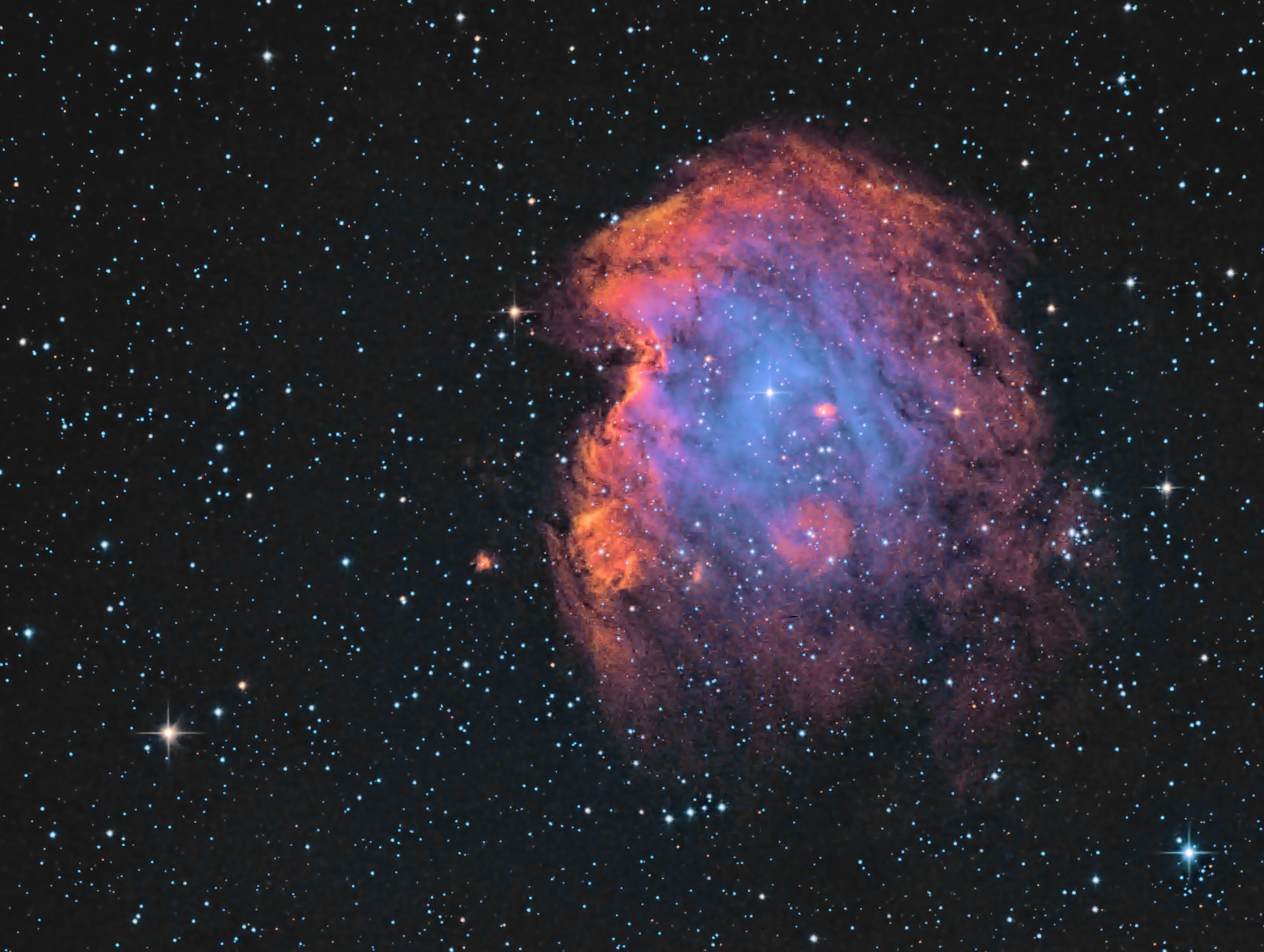
The Monkey Head Nebula, NGC2174 is a beautiful target with lots of fine details, especially around the edges.
The image was rotated and cropped to create a composition with some space for the 'monkey' to gaze into, perhaps remembering Ham the chimpanzee and the other primates that paved the way for humans into space.
I stacked the image with Deep Sky Stacker then assigned the HaSiiOiii data to RGB in that order, which gives more attractive colours and more natural stars than the 'Hubble palette'. I used Photoshop CS2 to stretch details and adjust the colour palette and then used Astra Image for fine-tuning and some gentle contrast enhancement.
Image of the Month for February 2021: The Flaming Star Nebula
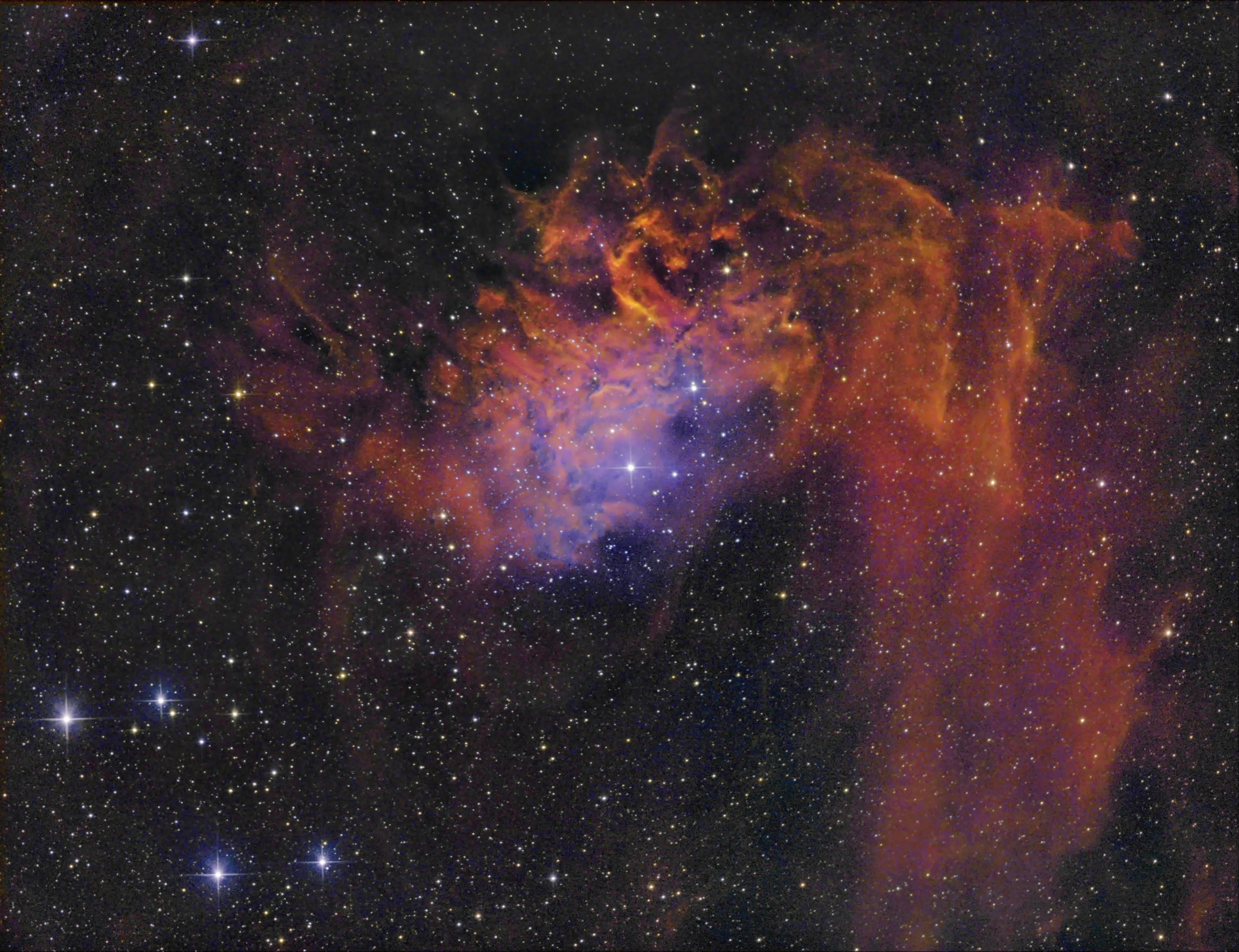
The Flaming Star nebula, also known as IC 405 surrounds the star AE Aurigae. Most of its colour comes from emission of Hydrogen and Sulphur light, highlighted in this narrowband image. The image has been updated to include the blue reflection component imaged in broadband blue light.
See past month's images
Image of the Month for January 2021: The Horsehead and Flame Nebulas

The Horsehead Nebula or Barnard 33 is a small dark nebula, whose fame arises from two things - fortuitously lying in front of a 'curtain' of ionised hydrogen gas and a remarkable resemblance to a horse's head. This image also shows the bright double star Alnitak (note the smaller companion star just left of the main star), and the bright Flame nebula (NGC 2024 or Sh2-277). Again the Flame nebula is the result of bright hydrogen behind a dark dust cloud. Smaller areas of blue reflection nebula where the dusty nebulas scatter starlight are also visible in the image. This image is a composite of three monochrome images filtered for the light of hydrogen alpha, sulphur ii and oxygen iii mapped in that order as red, green blue and then colour balanced.
Compare this image to the images for the month for December 2019, taken using a tri-band filter and colour camera or that for January 2016, taken with a colour camera and no filter.
- Details
- Category: Images of the Month
Here's the home of 2020's 'Image of the Month' pictures. Enjoy!
2021 : 2020 : 2019 : 2018 : 2017 : 2016 : 2015
Image of the Month for December 2020: The Pacman Nebula, NGC281
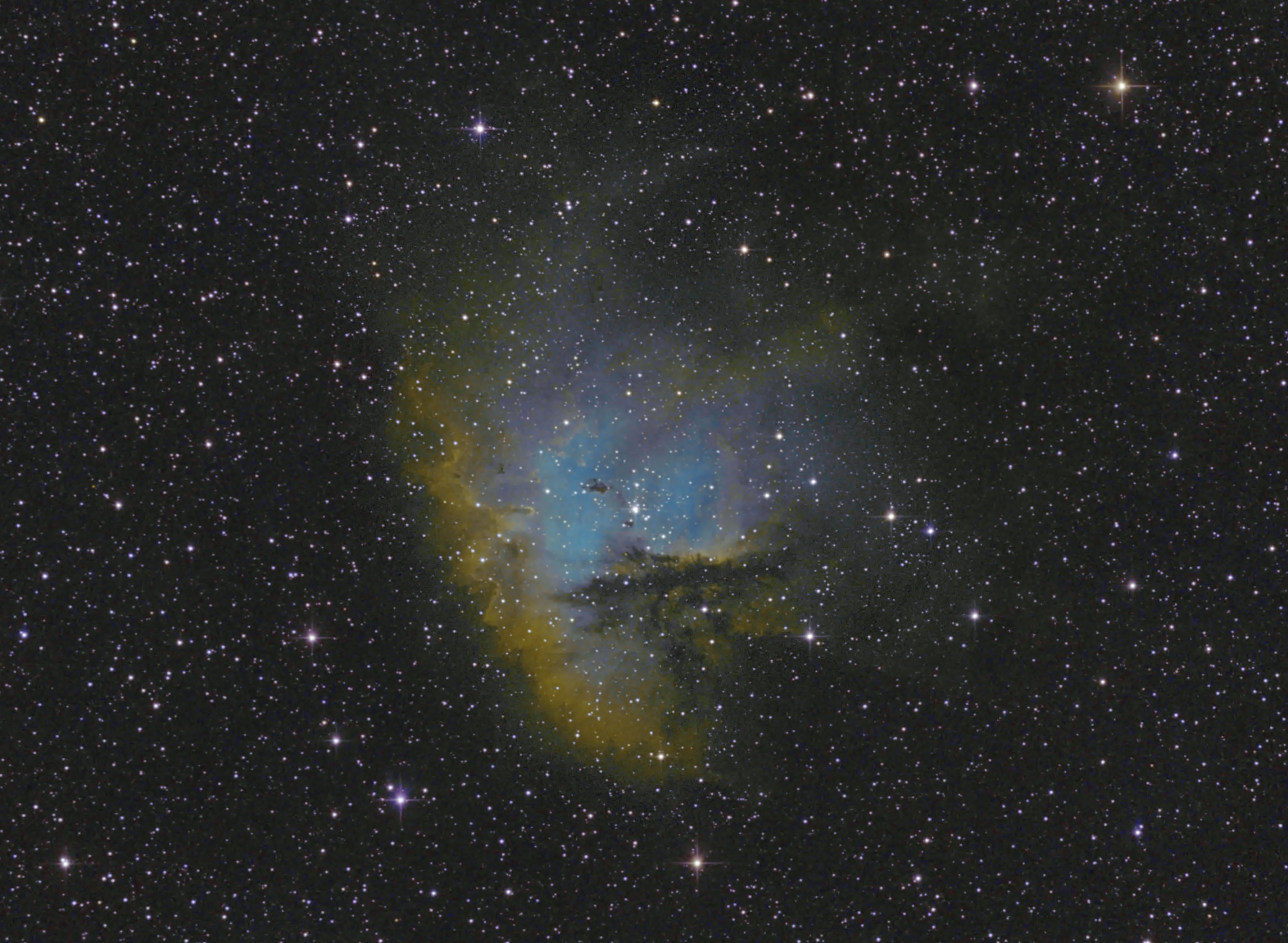
NGC281, known as the 'Pacman Nebula' because of its distinctive shape, is a relatively easy object to photograph in the constellation of Cassiopeia. Close to its centre is a cluster of young stars, and the small dark patches are 'Bok globules' where condensing dust is forming new stars. This image is taken using narrowband filters to select light from ionised hydrogen, oxygen and sulphur then processed using a modified version of the 'Hubble palette'.
Image of the Month for November 2020: Mars at Closest Approach
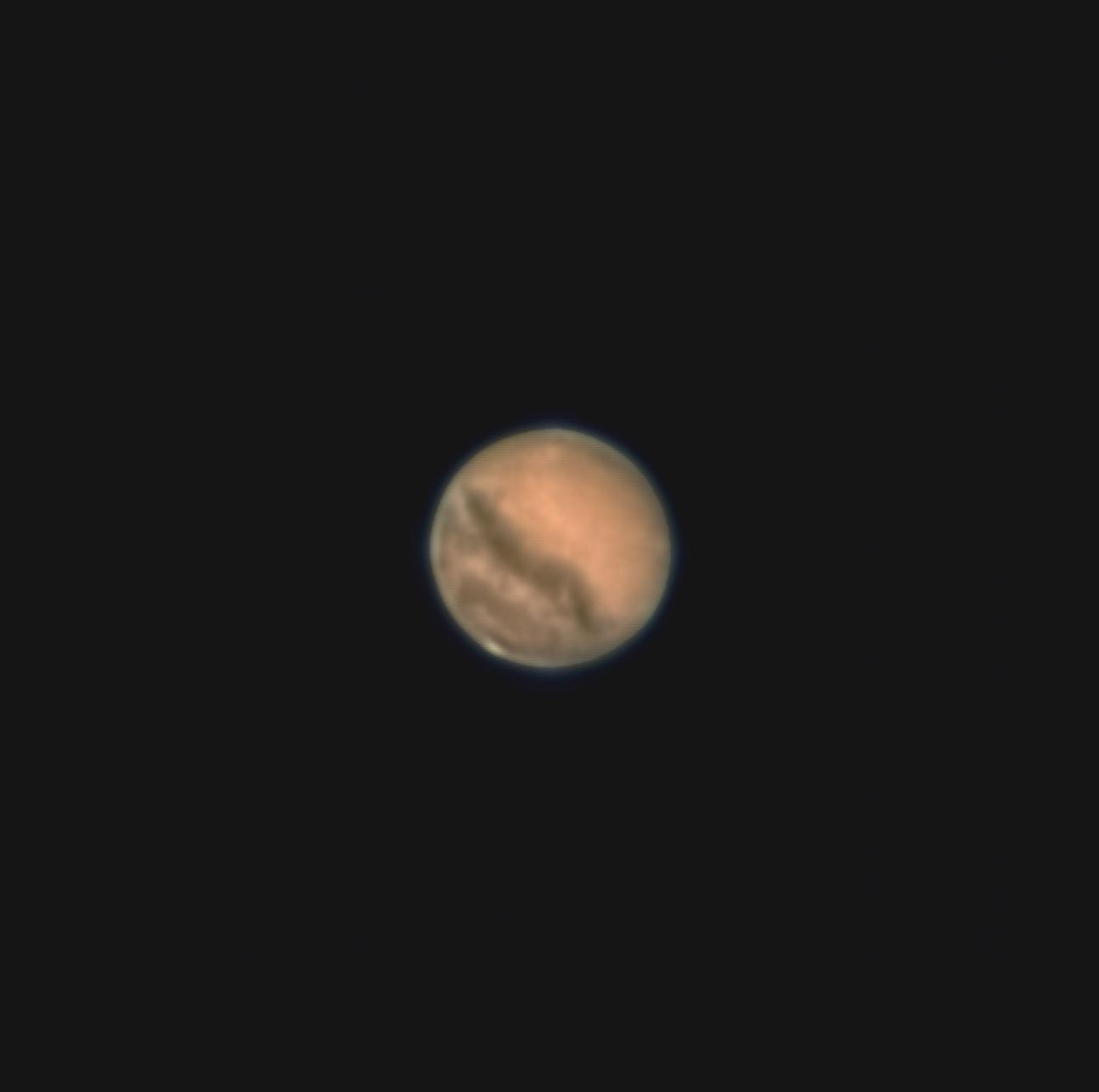
This image shows Mars within a day or two of its close approach to the Earth in 2020. Taken using a Skywatcher 150PL and ZWO ASI120MC with a 3x barlow on an HEQ5 mount.
Image of the Month for October 2020: Triplanetary

This composite image shows Mars, Jupiter and Saturn imaged on the night of 13 September 2020. The camera used was a ZWO ASI120MC fitted to a Skywatcher 150PL with an x3 barlow.
Image of the Month for September 2020: The Crescent Nebula in Narrowband
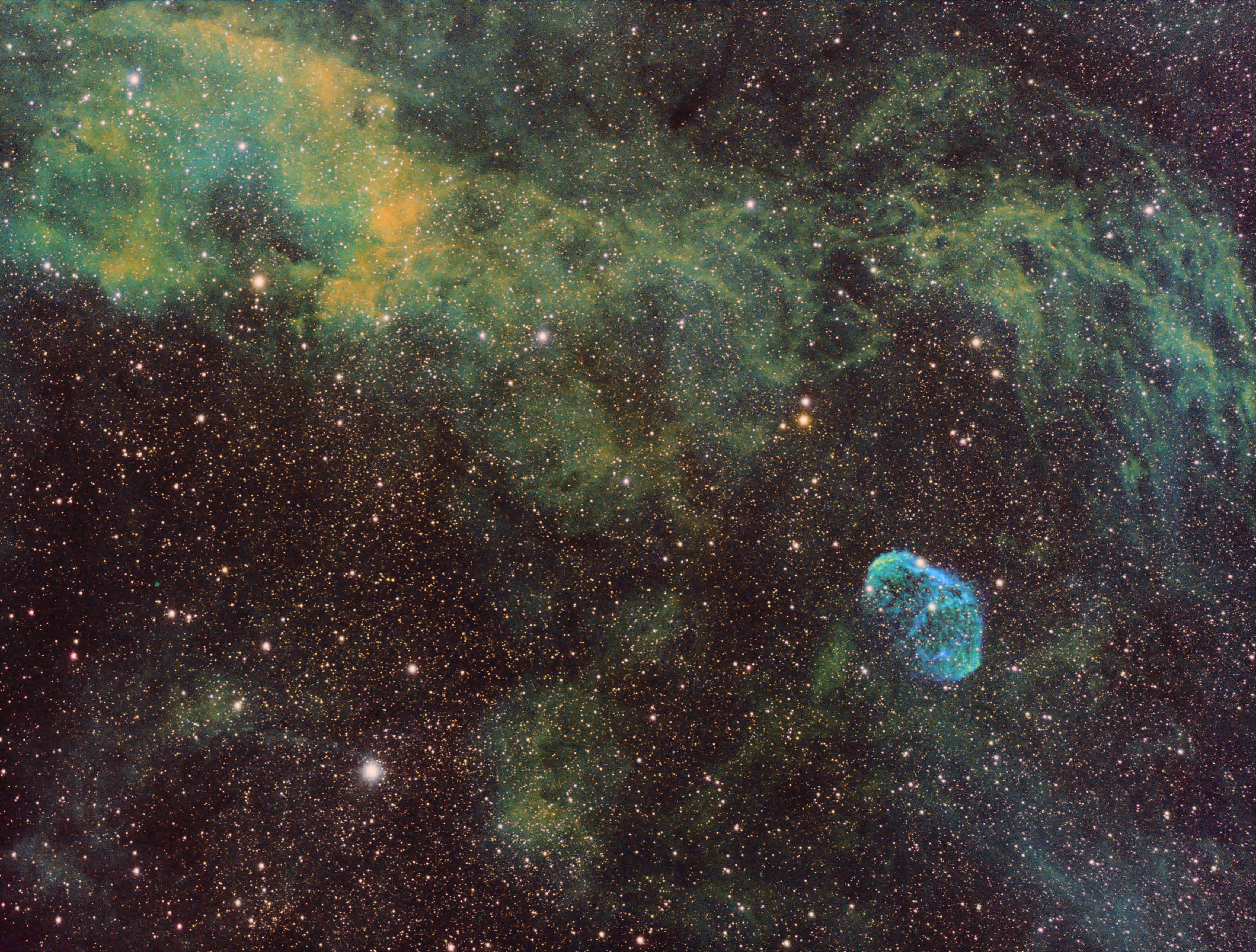
The Crescent nebula is a (literally) fantastic target for astrophotography, as it lies in front of swirling clouds of nebulosity in constellation of Cygnus. This narrowband image using data for sulphur, hydrogen and oxygen brings out even more complexity in this wonderful patch of sky. This image was taken using Baader 7nm filters and a ZWO ASI1600MM Pro camera.
Image of the Month for August 2020: The North America and Pelican Nebulas
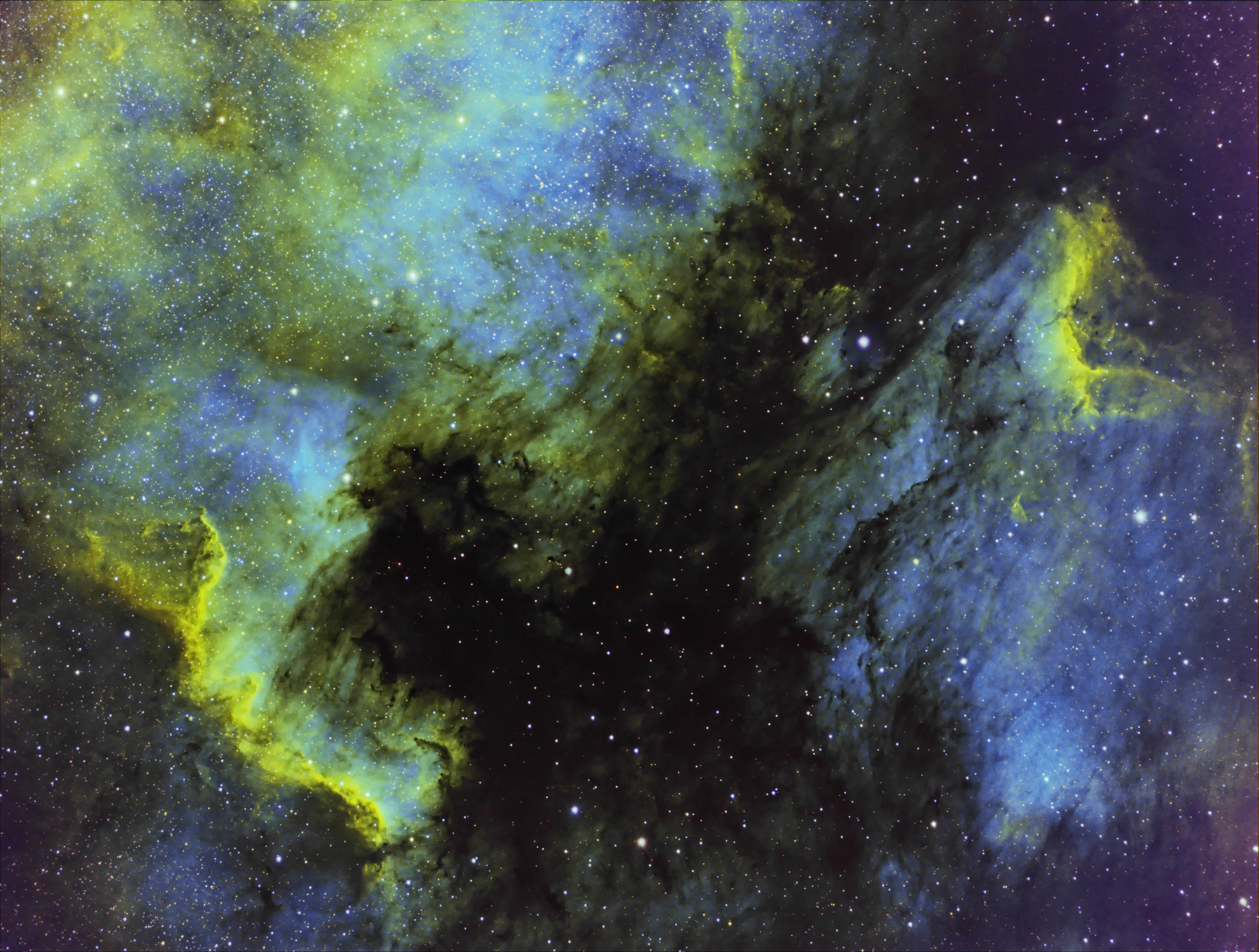
Few nebulas look as much like their namesakes as NGC7000 (left) and IC5070. This synthetic colour image comprises about 16 five-minute images each for hydrogen (Ha), sulphur, (Sii) and oxygen (Oiii) and processed using the 'Hubble Pallet'. Right click to see full details.
Image of the Month for July 2020: The Pillars of Creation
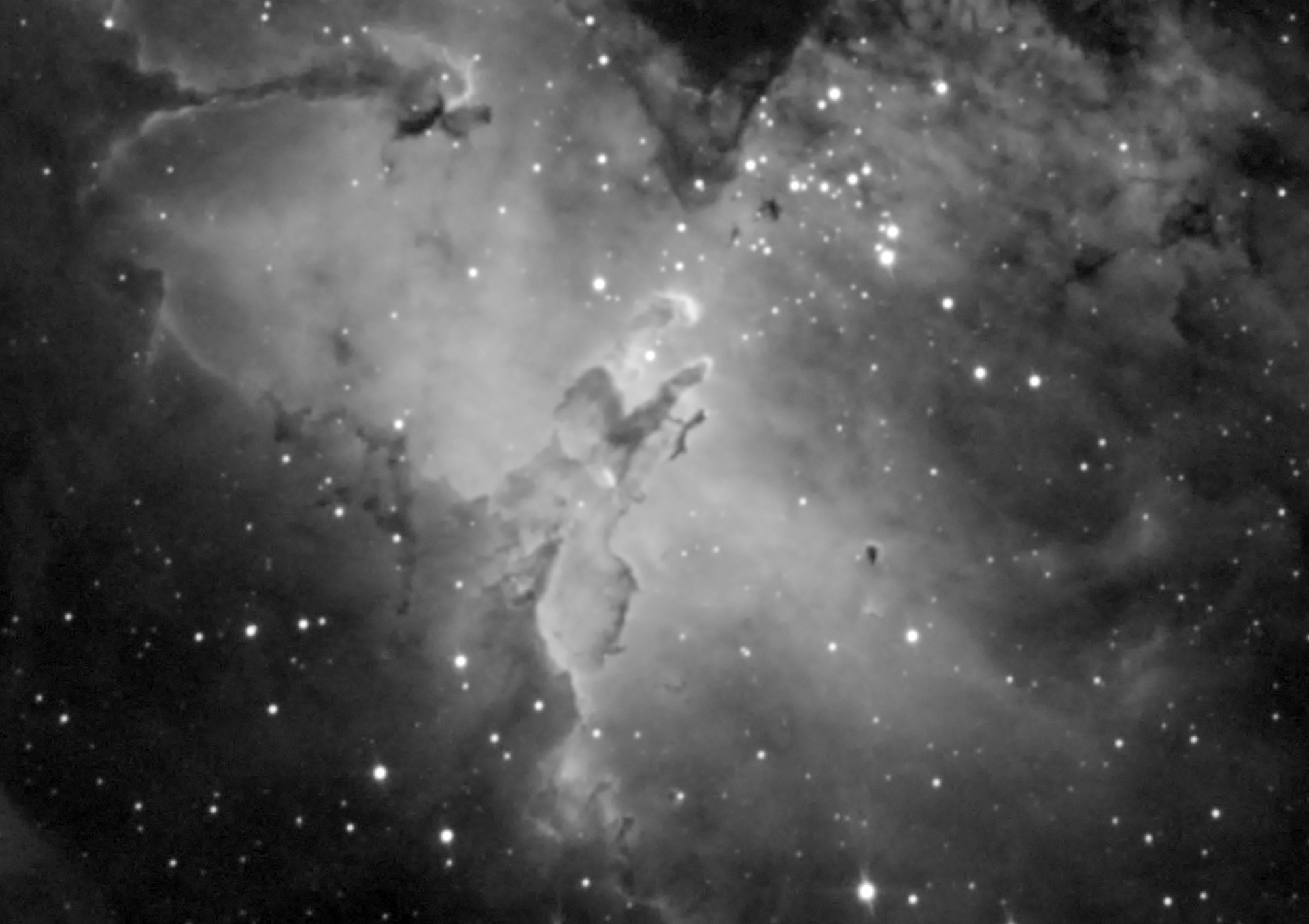
Every astronomer would like to have their very own Hubble Space Telescope, but unfortunately they come with a rather steep price tag. Instead, here's my image of the Pillars of Creation at the heart of the Eagle Nebula, M16, cropped out of an image of the whole nebula. Strictly Messier 16 is the open cluster of stars associated with the nebula rather than the nebulosity itself. Right click and view to see full size.
Image of the Month for June 2020: Messier 57 - Going Deep!
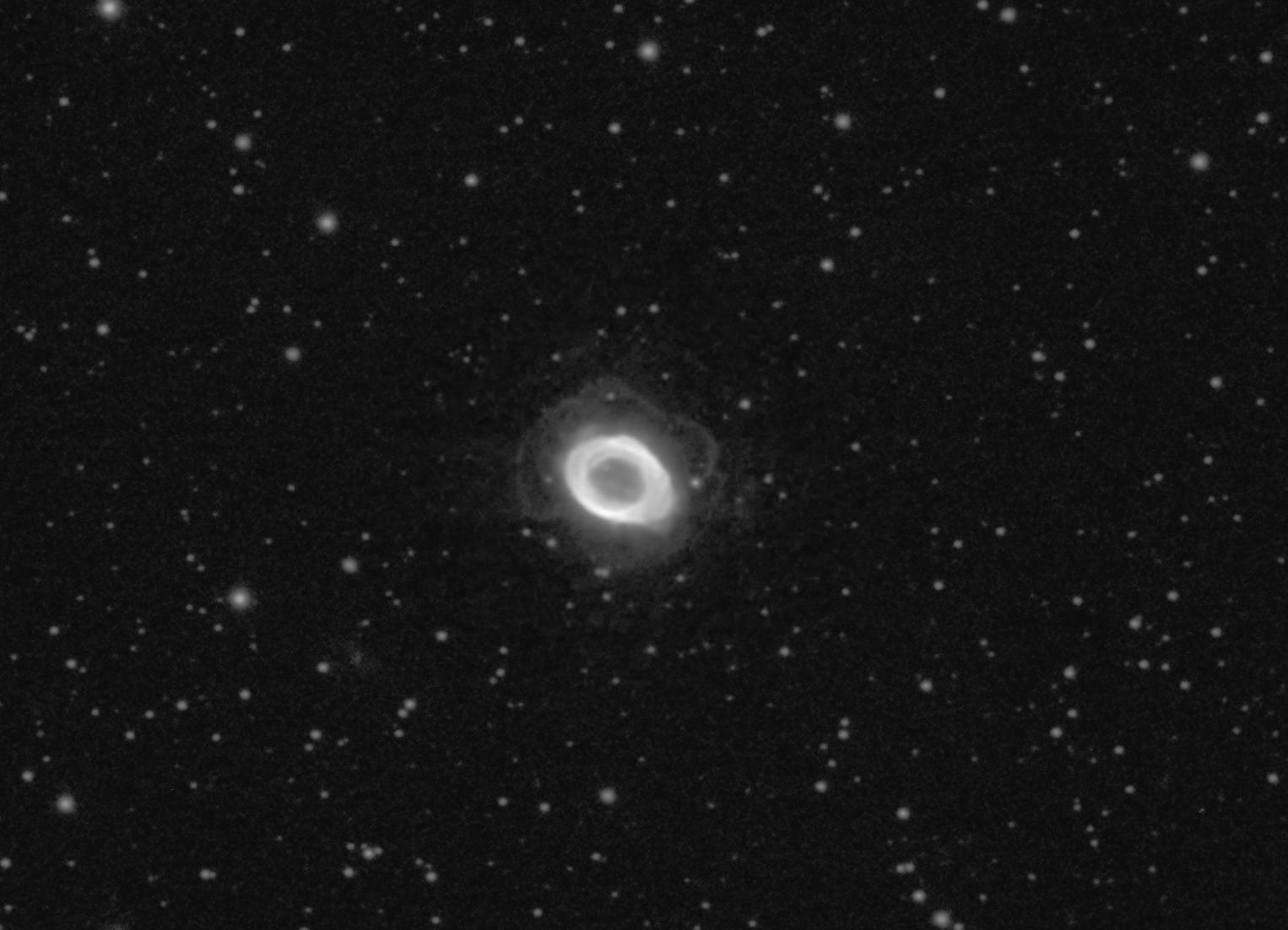
The amazing Ring Nebula has been featured as the image of the month before, but in May 2020 I amassed several hour's worth of narrowband Hydrogen Alpha data using my venerable Skywatcher 150PL. This doesn't pick up the stars very well, but has brought out the multi-lobed outer hydrogen envelope around the 'ring' structure. If you look carefully you can also see signs of a further outermost ring. Getting much deeper than this is going to need much darker autumn skies.
Image of the Month for May 2020: Messier 13

Messier 13 is a bright globular cluster containing thousands and thousands of stars. Globular clusters orbit the galaxy and M13 is one of the brightest and biggest, you can see it as a faint fuzzy star under Hercules' left armpit (if you think of him as facing you). The amazing thing about this image is s the sheer number of very faint stars at the edges of the cluster.
Image of the Month for May 2020: Messier 106
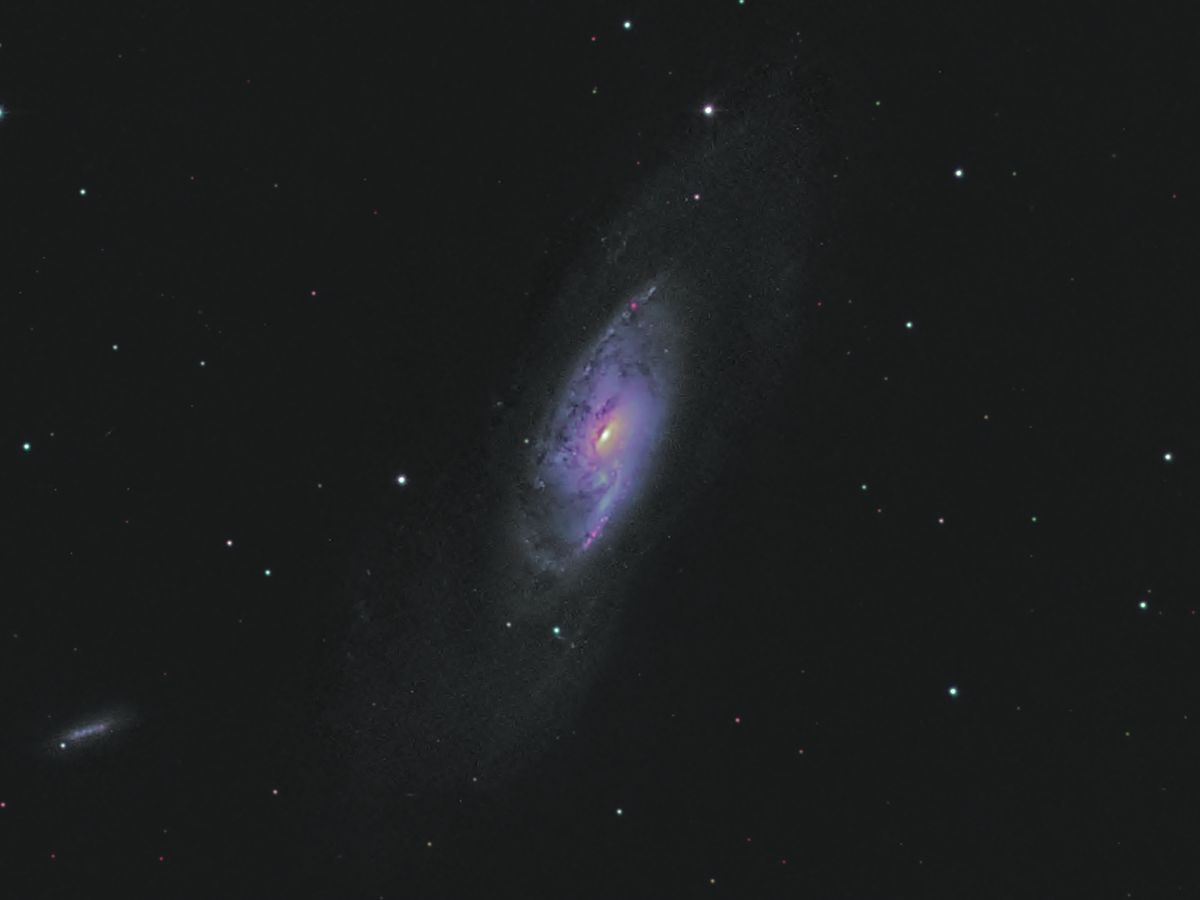
Messier 106 is a spiral galaxy that acts as a giant 'maser' or microwave laser. The thinly spread water molecules that cause this effect, visible only to radio telescopes, can still be detected in visible light images as they give the galaxy its distinctive purple colour.
Image of the Month for April 2020:
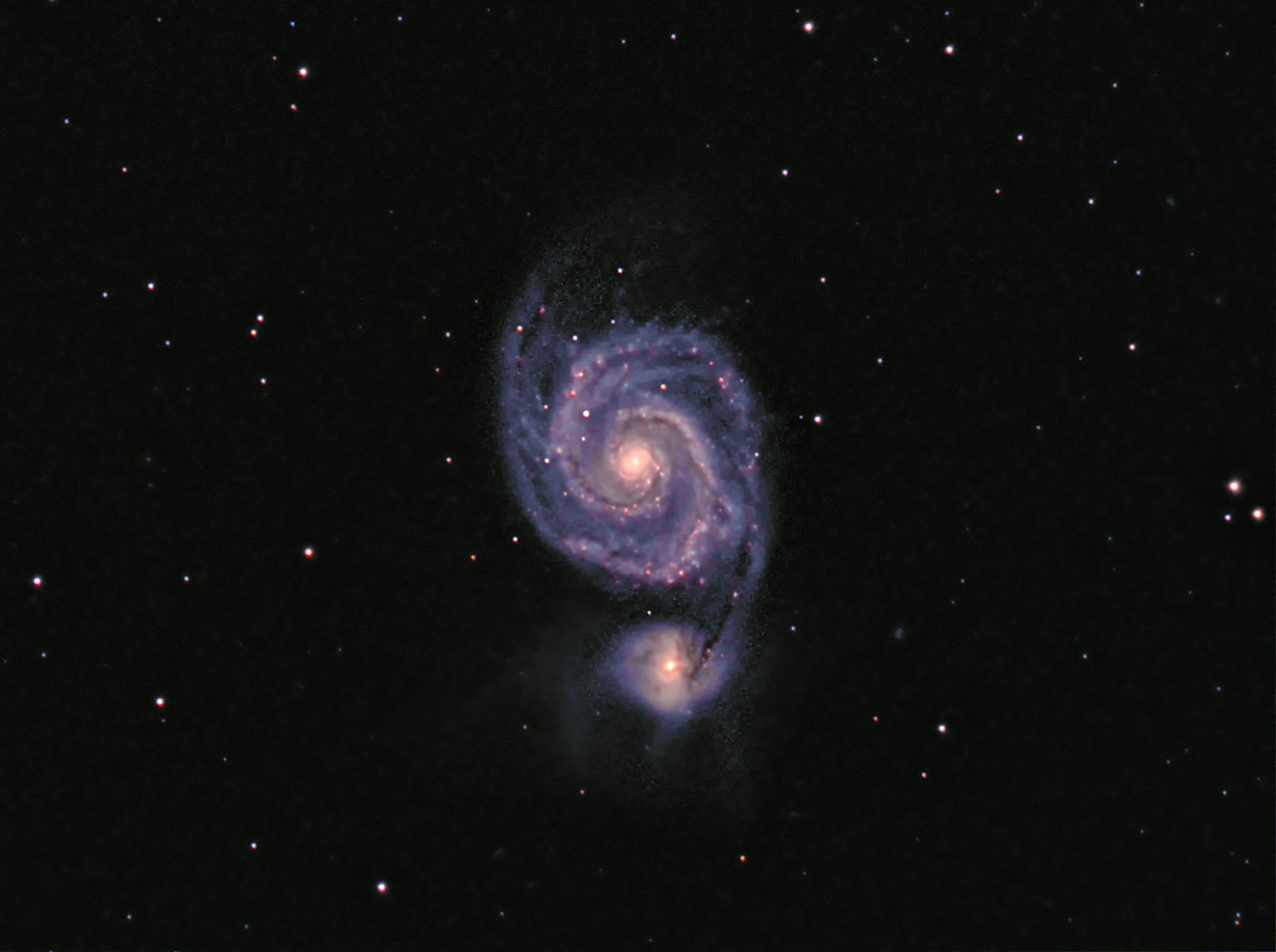
Revisiting M51, the Whirlpool Galaxy. The image is comprised of RGB channels plus a luminance layer and an additional Ha component in the red layer.
Image of the Month for March 2020: The Orion Nebula
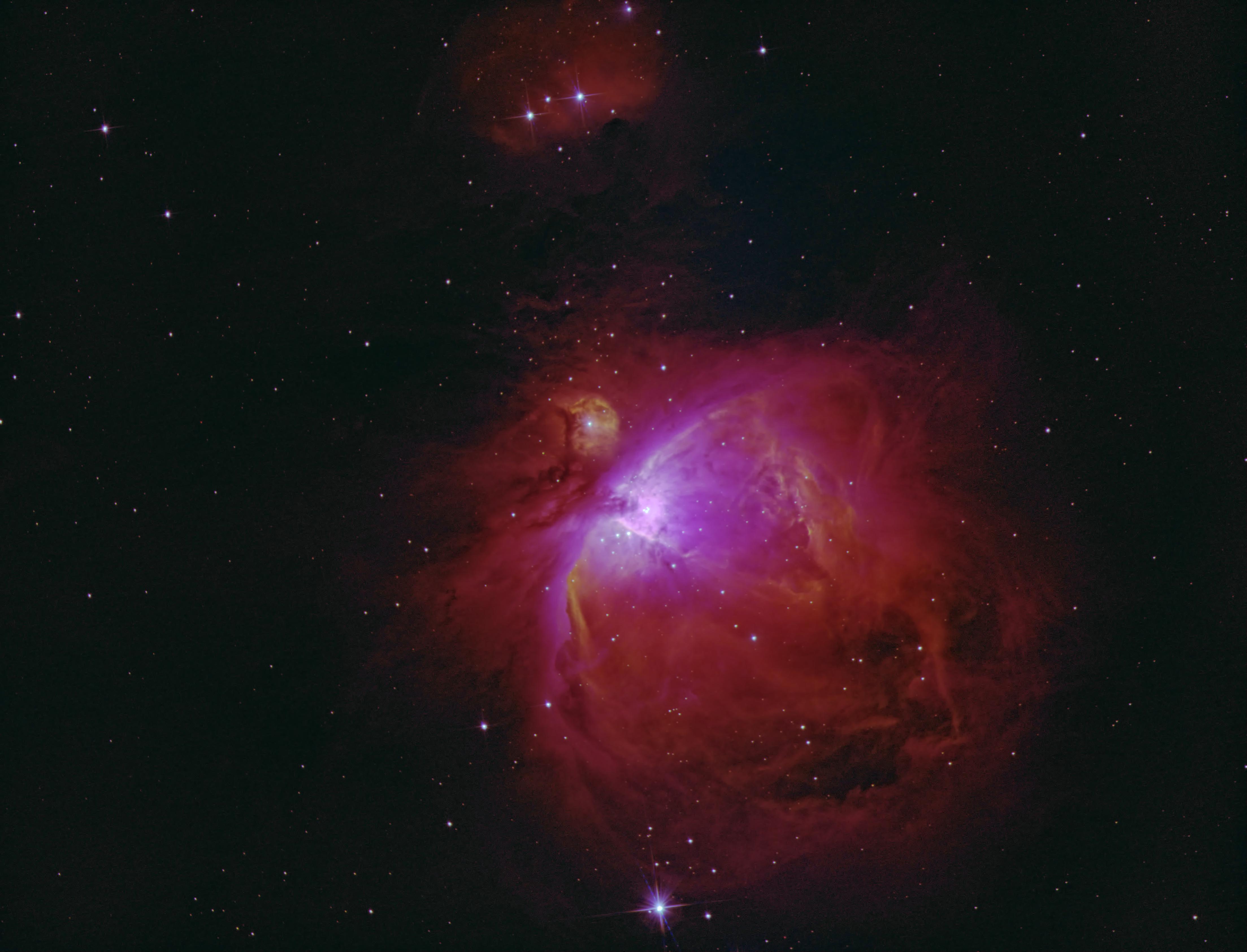
The Orion Nebula, Messier 42. The raw data for the image is Ha, Sii and Oiii. The image maps the channels RGB (the Oiii (blue) signal has been adjusted to remove the magenta cast caused by the (red) Ha component.
Image of the Month for February 2020: The Rosette Nebula
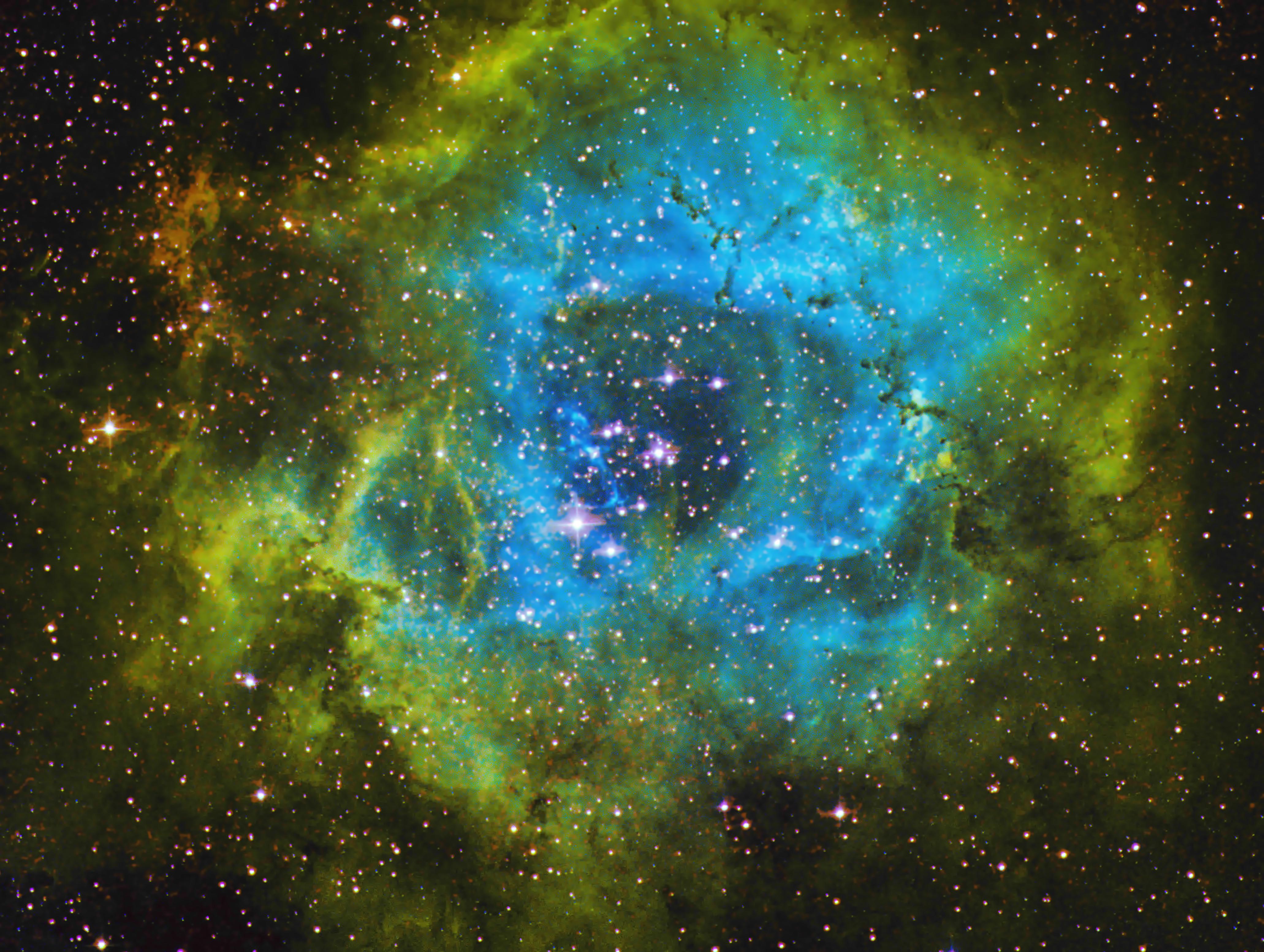
Two different processings of a narrowband image of the Rosette Nebula in Monoceros. The raw data for both images is Ha, Sii and Oiii. The first one maps the channels RGB (the Oiii (blue) signal has been adjusted to remove the magenta cast caused by the (red) Ha component. The Sii areas are golden. The second processing uses the 'Hubble Palette' which is often used for images taken with the Hubble Space Telescope.
Image of the Month for January 2020: The Heart Nebula
Far from perfect, this image is my first attempt at a H-alpha/Oxygen-II image using a mono camera.
- Details
- Category: Images of the Month
2021 : 2020 : 2019 : 2018 : 2017 : 2016 : 2015
Image of the Month for January 2019: Comet 46/p Wirtanen
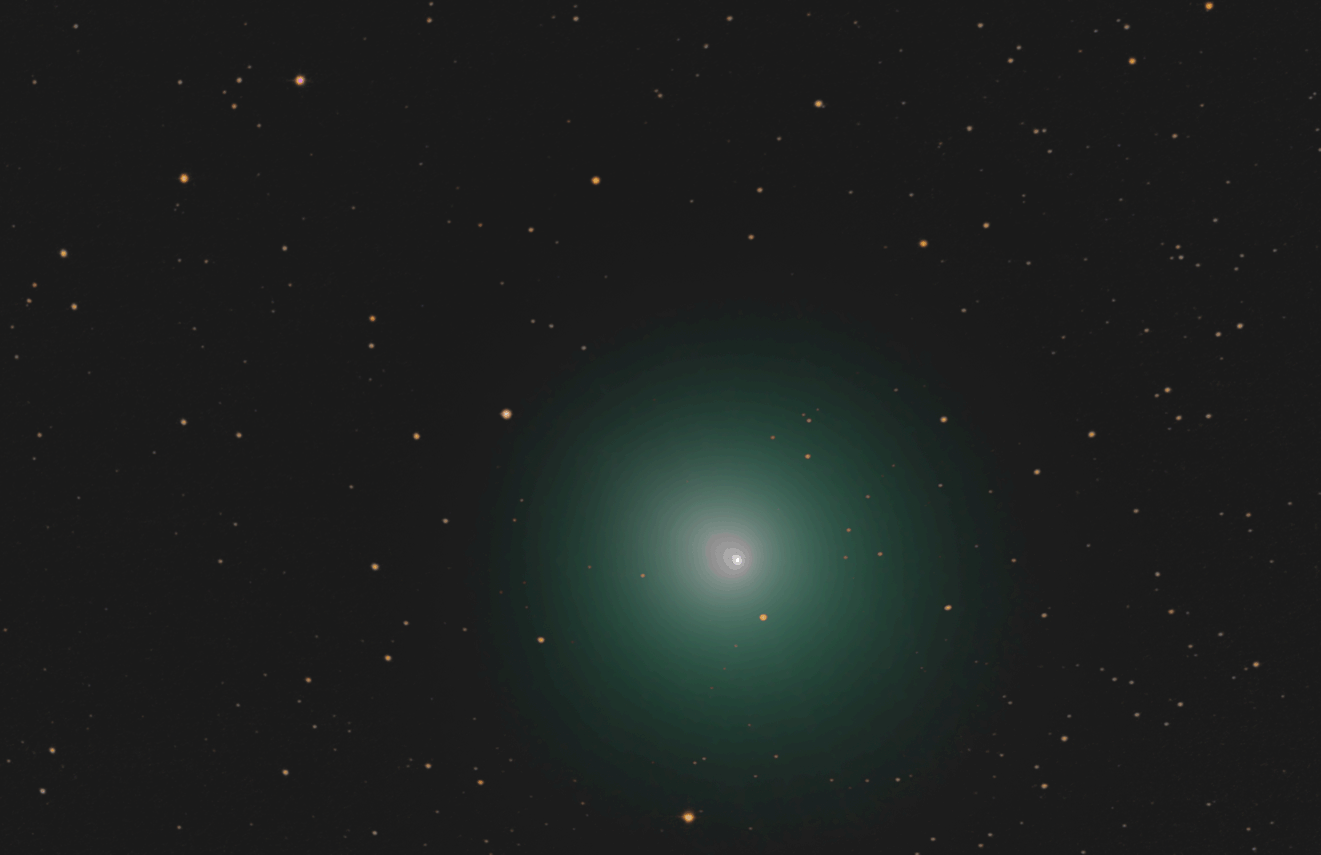
Something a bit different this month, an animation of Comet 46/p Wirtanen taken on the 13 December 2018. Stacked using Deep Sky Stacker. Skywatcher 130P-DS telescope on HEQ5 mount, Canon 45D astro-modded and cooled.
Image of the Month for February 2019: M1, The Crab Nebula
The Crab Nebula, M1, the remains of a supernova recorded as a 'guest star' in 1054 and given its name in 1840 by William Parsons. The object is expanding so fast that differences can be seen in images taken 10 or 20 years apart. Skywatcher 130P-DS telescope on HEQ5 mount, Canon 45D astro-modded and cooled.
Image of the Month for March 2019: The Hickson 44 Galaxy Group
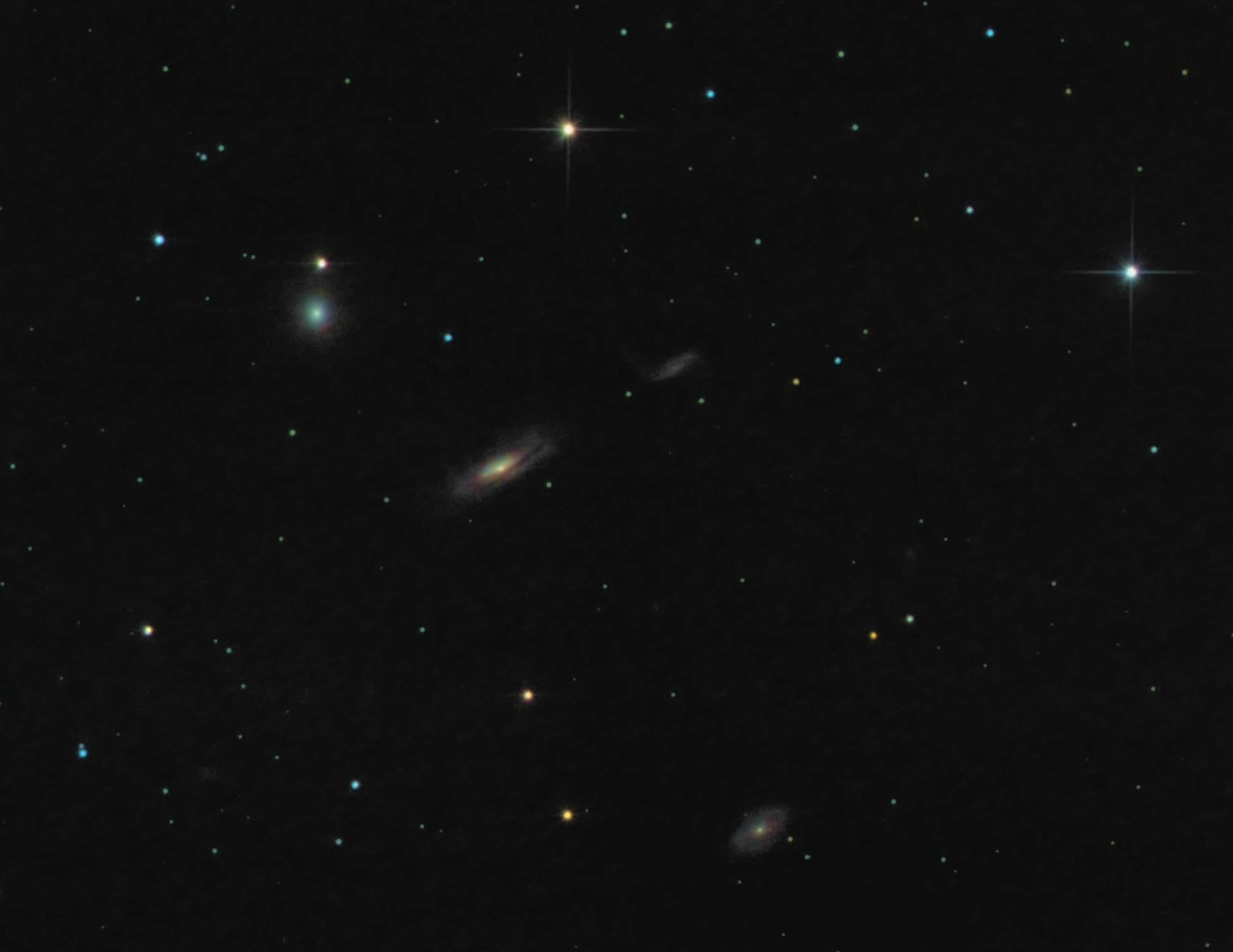
The snappily named and rarely imaged Hickson 44 Galaxy Group is located in the constellation Leo, at the 'back' of the lion's head. It is a small collection of interacting galaxies.
Image of the Month for April 2019: M101, the Pinwheel Galaxy
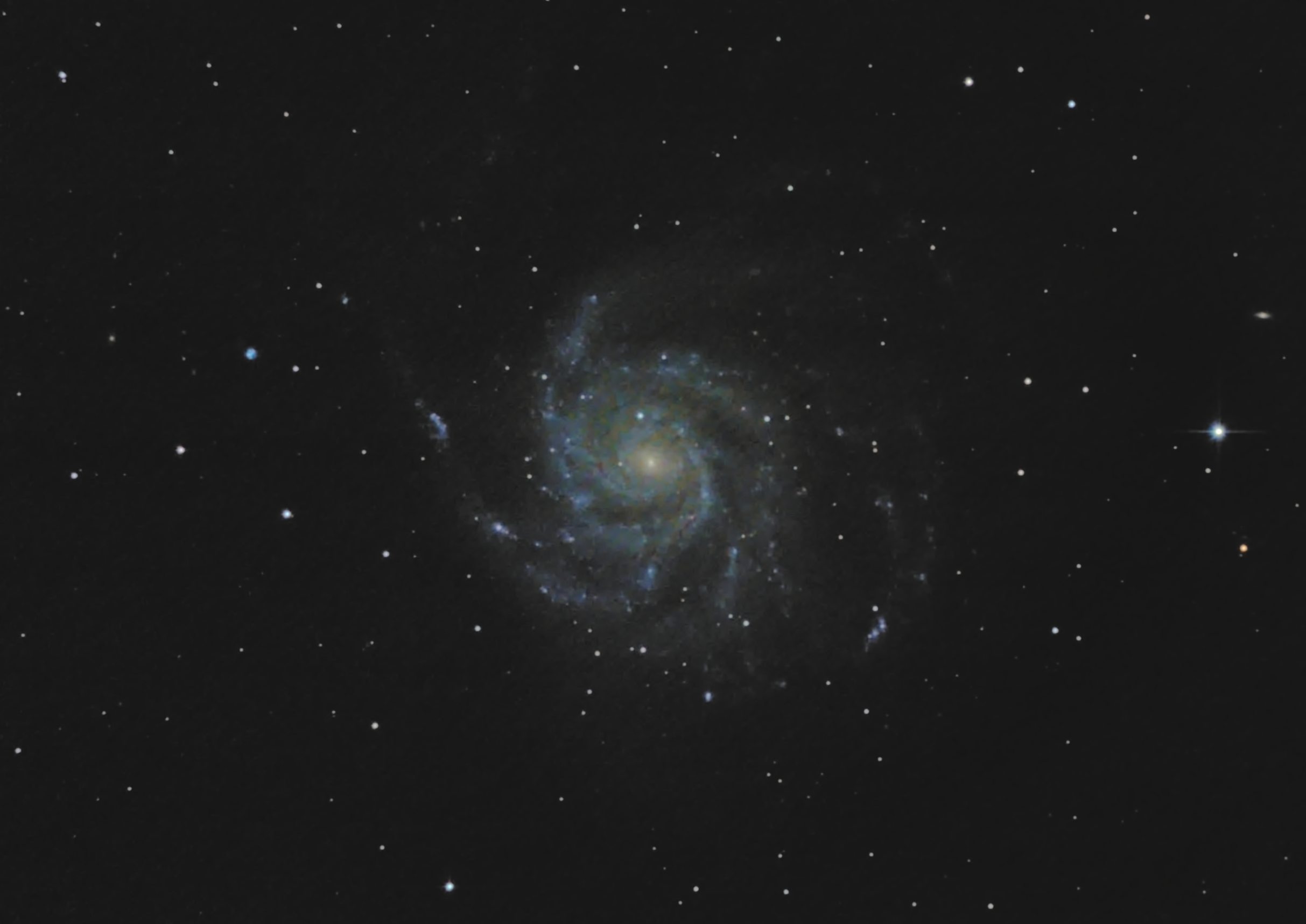
The Pinwheel Galaxy played an important step in our understanding of galaxies as separate 'island universes' beyond our own Milky Way galaxy, when Lord Rosse was the first person to identify its spiral structure.
Image of the Month for May 2019: NGC4631, the Whale Galaxy
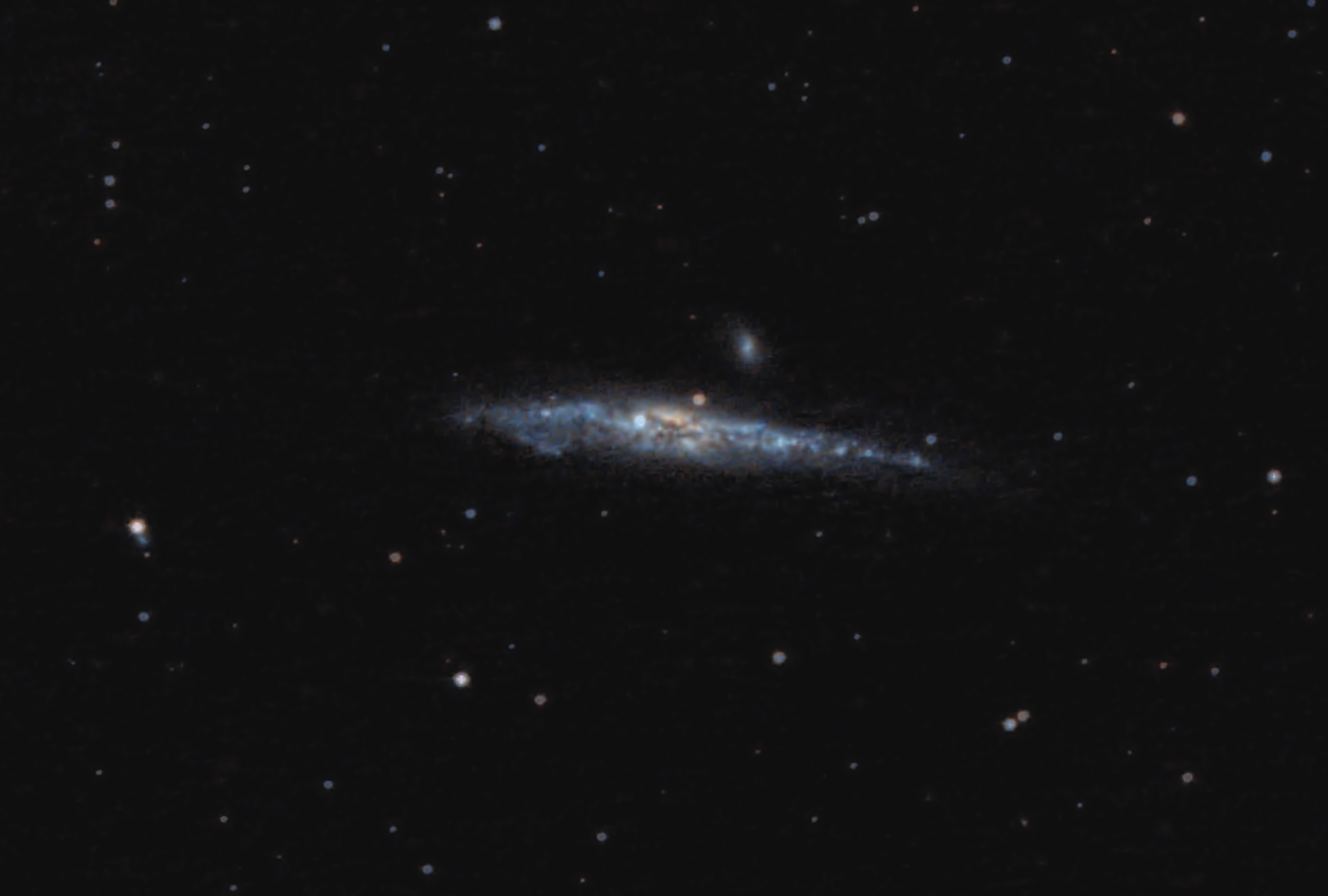
Also known as the Herring Galaxy this is a spiral galaxy, seen almost edge-on with a small companion galaxy. Taken using Skywatcher 130P-DS scope on HEQ-5 mount with a cooled and astro-modded Canon 450D. 63 two-minute exposures.
Image of the Month for June 2019: M13 The Great Globular Cluster in Hercules
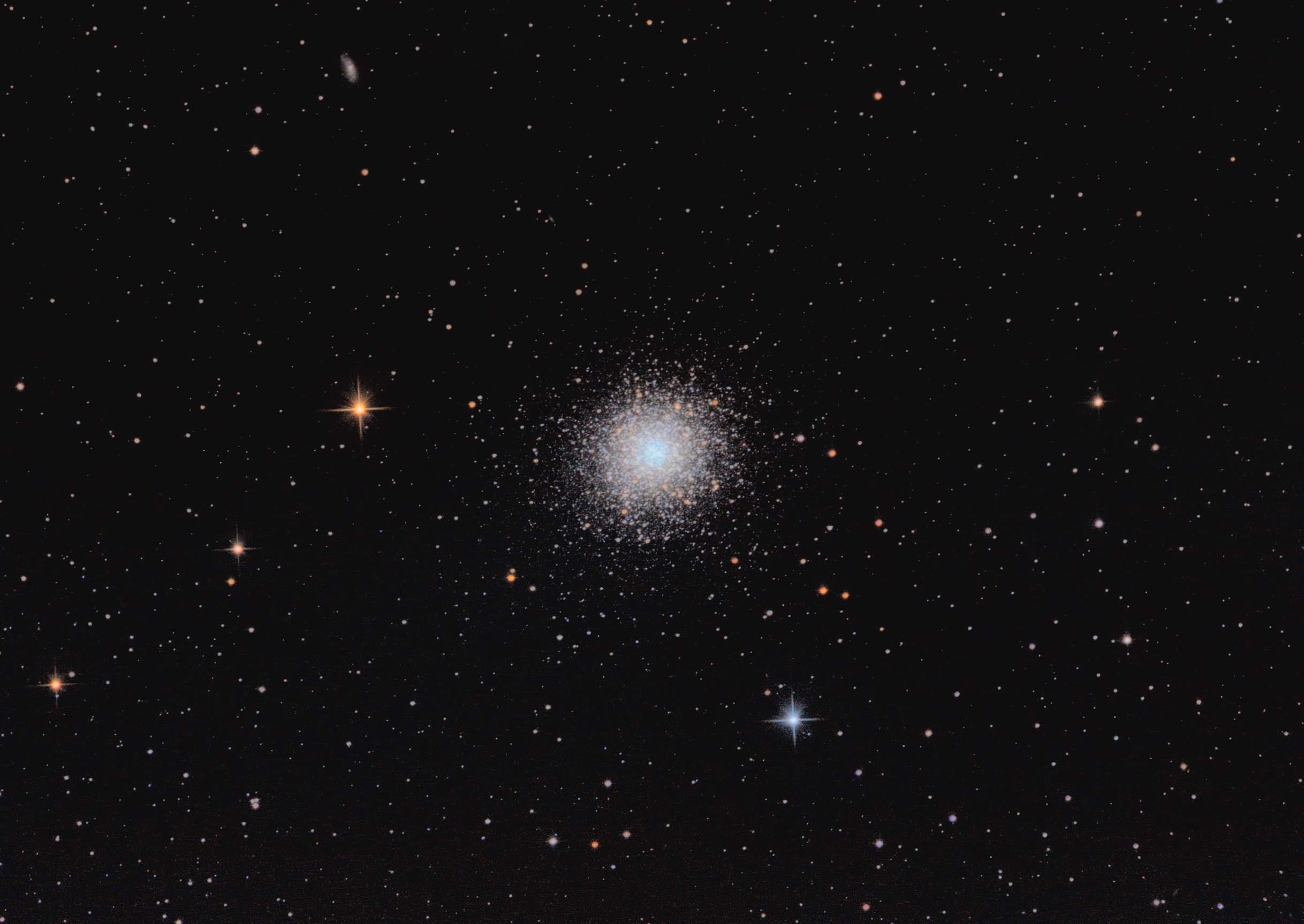
M13 is bright enough to be seen as a small fuzzy patch in dark skies, through a medium sized telescope you can start to see the stars that make it up. Taken using Skywatcher 130P-DS scope on HEQ-5 mount with a cooled and astro-modded Canon 450D. A combination of many 30-second exposures taken in 2018 and about 40 120-second exposures taken in May 2019 has helped in resolving stars to the centre of the cluster.
Image of the Month for July 2019: Jupiter
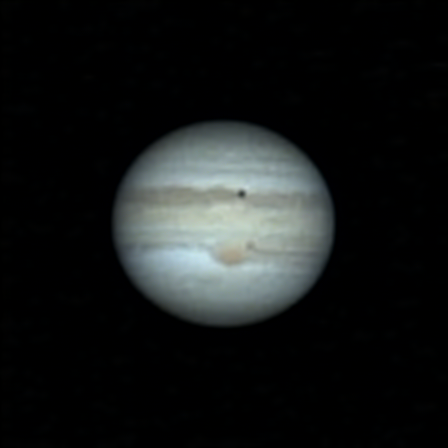
Jupiter is very low down in the sky this year, making imaging a real challenge. In this image from 20 June 2019, the moon Io passes in front of the planet leaving a clear shadow, although the moon itself is a barely visible yellowish patch to the right of the shadow. Below, the Red Spot is unmistakeable, but this 300-year-old storm is shrinking. Will it disappear soon? Taken with a Skywatcher 150PL telescope and ZWO ASI120MC camera and a ZWO Atmospheric Dispersion Corrector, to offset the 'colour smearing' caused by the planet being so low in the sky.
Image of the Month for August 2019: Partial Lunar Eclipse
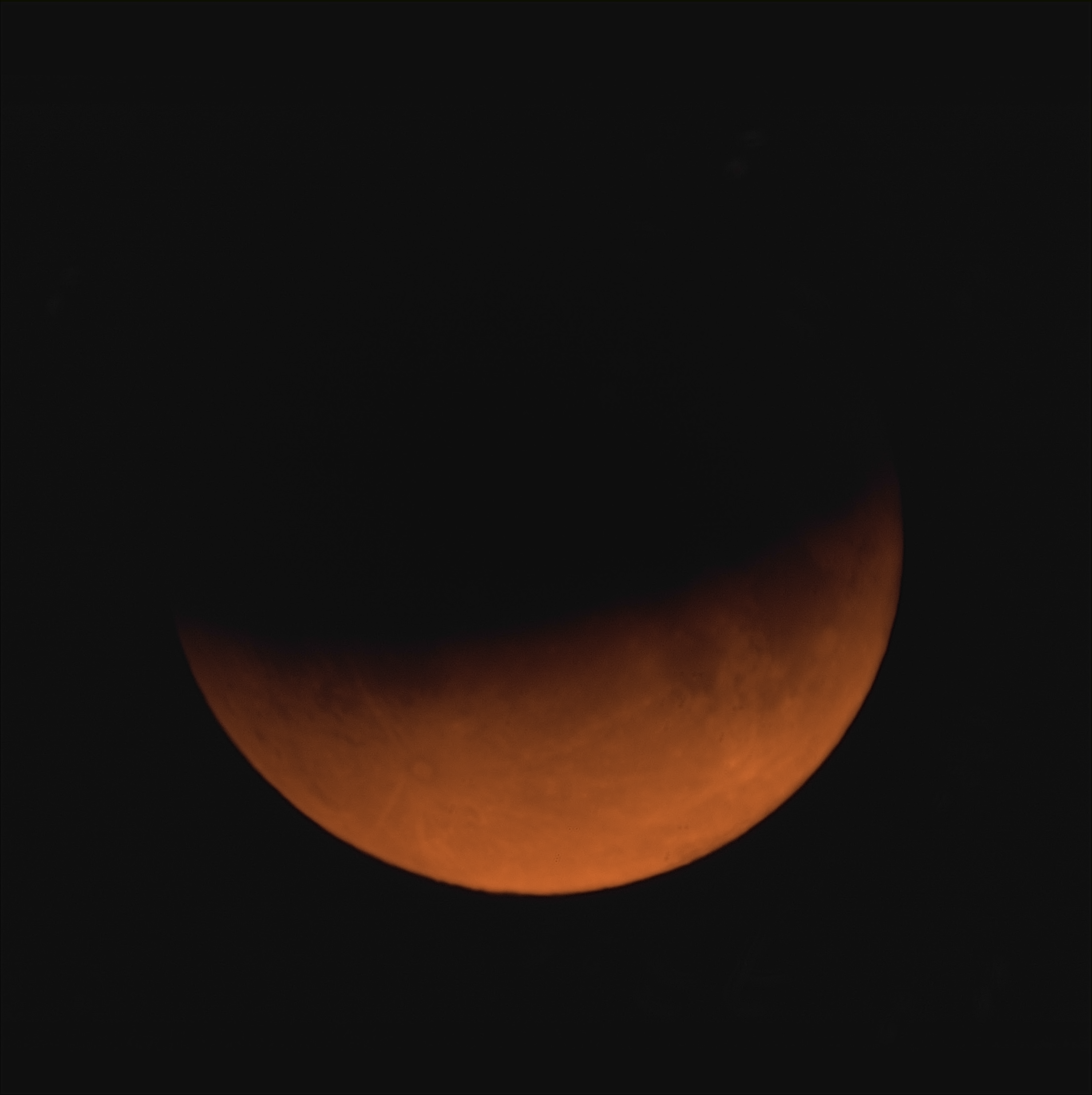
The partial Lunar Eclipse on 16 July 2019 took place on the fiftieth anniversary of the launch of Apollo 11, so gathering with fellow members of Rosliston Astronomy Group was a great way to mark the occasion. Despite early cloud, satellite imagery from online weather websites showed that we would probably be lucky, and the moon appeared from behind cloud about twenty minutes after it rose. We were able to view about an hour and a half of the spectacle, as scattered cloud came and went, before another big bank of cloud moved across, so we saw the point of deepest eclipse. This image is from fairly early on, taken with a Canon D1000 mounted on a Celestron C90 Mak, and stacked from about fifteen images that were clear of cloud.
Image of the Month for September 2019: The Swan Nebula, M17
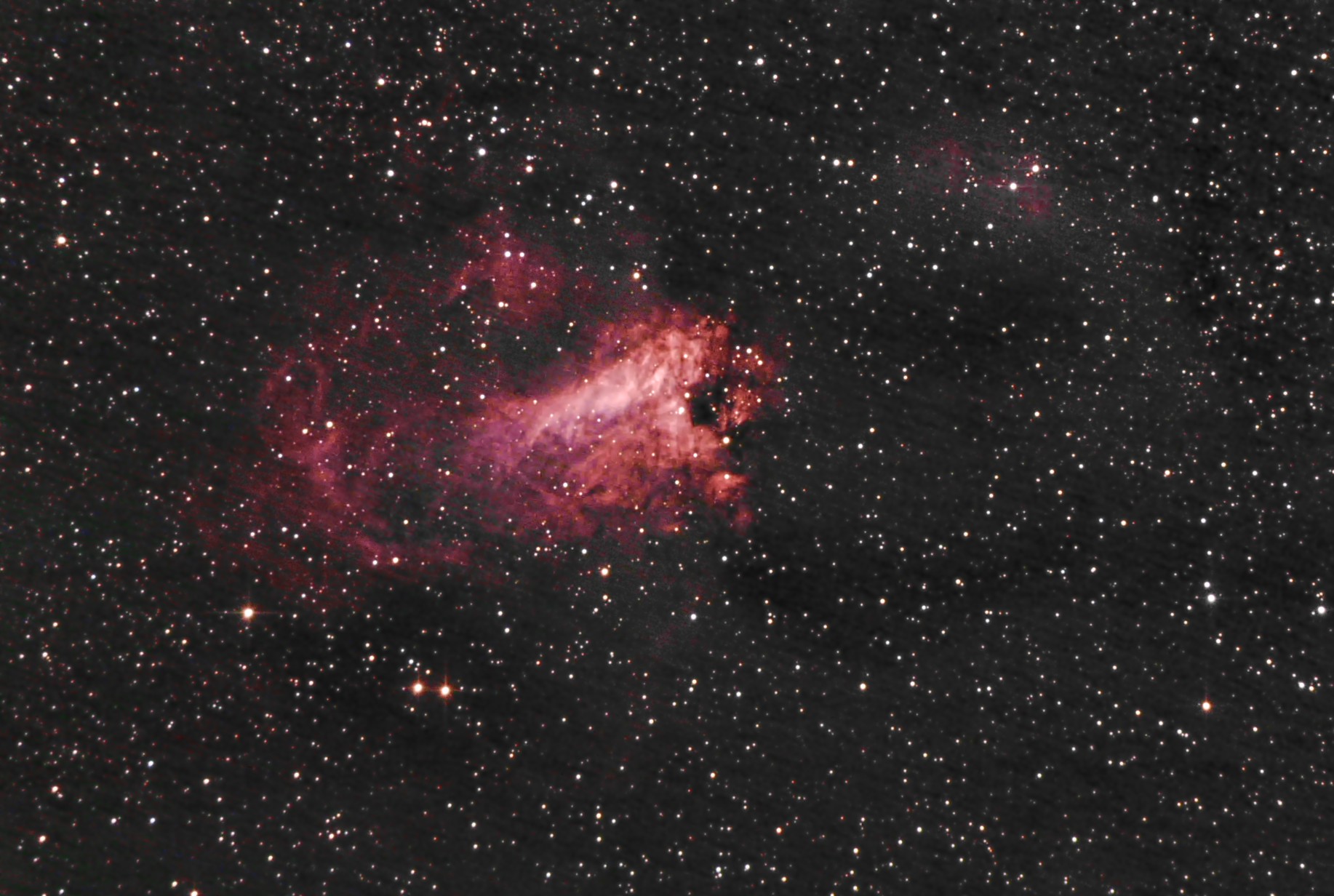
The Swan or Omega Nebula is a rich and complex area of hydrogen-alpha emission nebula in the constellation Sagittarius. This is one of the richest parts of the night sky, as the centre of the Galaxy with its supermassive black hole lies in this direction. It is hard to image this part of the sky well from the UK as everything is close to the horizon, but on 25 August 2019 there were almost perfect conditions combining exceptional transparancy and seeing - in other words the sky was clear of clouds and dust and very steady, a combination that minimises light pollution and the sharpness of image you can achieve.
Image of the Month for October 2019: The Crescent Nebula, NGC6888
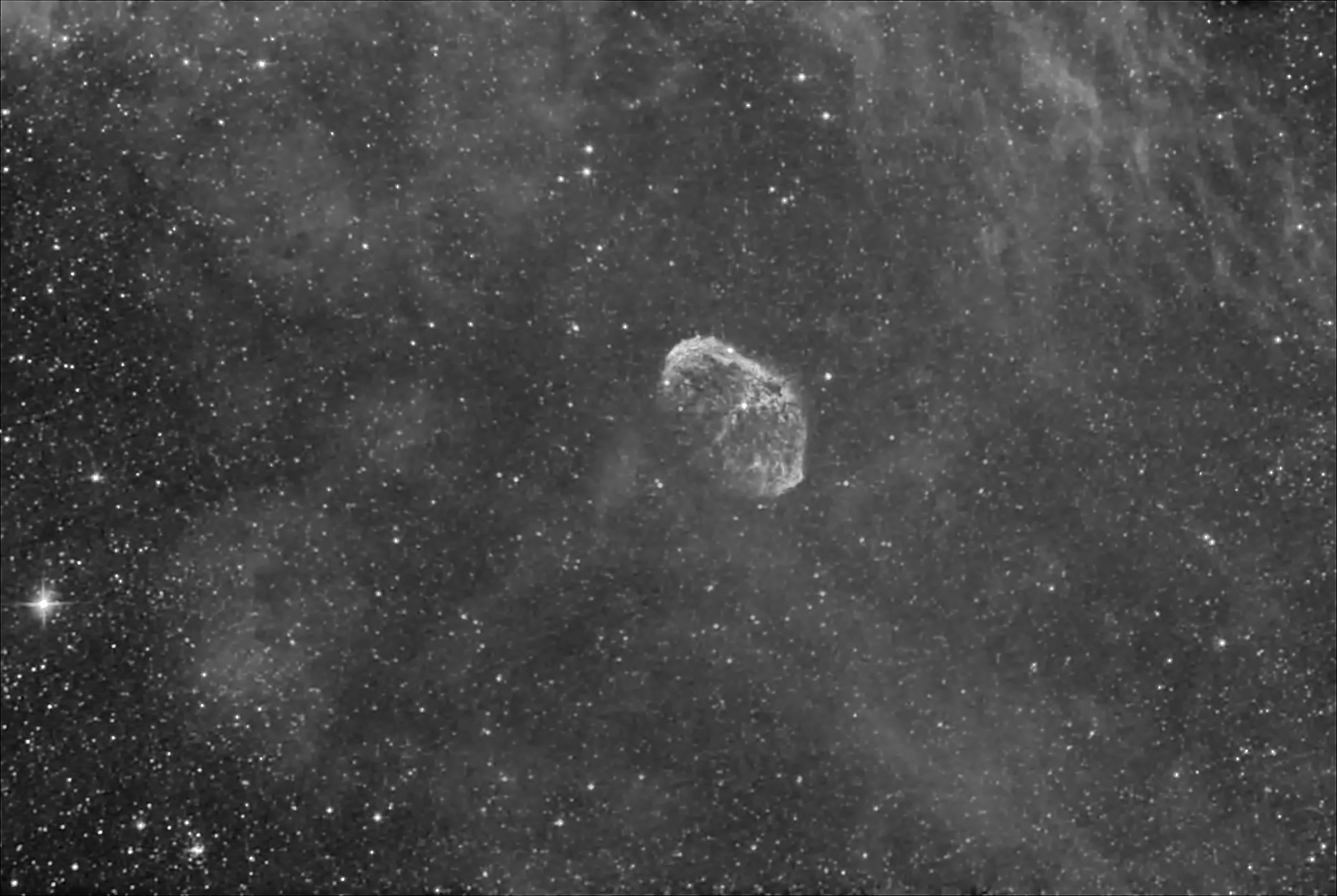
The Crescent Nebula is a complex emission nebula formed by the emissions from Wolf-Rayett star WR136 interacting with gasses it lost in the past, forming multiple shock waves. Although a fairly small target for photography, it lies against fainter but huge emission nebulae in the constellation of Cygnus making it an excellent choice for wide-field photography, especially for narrowband imaging as here, where a Baader 7nm Hydrogen Alpha filter was used.
Image of the Month for November 2019: The Heart and Soul Nebulas
Image of the Month for December 2019: The Flame and Horsehead Nebulas
Perhaps the most famous and familiar nebula to non-astronomers, the Horsehead is a cloud of dark dust silhouetted against the curtain of red emission nebula behind. The Flame Nebula is another bright nebula. This image was taken using an Optolong L-Enhance tri-band nebula filter using a Canon 450D and a 66mm ED telescope.
This well-known pair of nebulas lying between the constellations of Cassiopeia and Perseus are huge clouds of hydrogen. Young stars near their centres have pushed the gas outwards away from them and the 'shock waves' themselves have become nurseries for even younger stars. These two images were taken using an Optolong L-Enhance tri-band nebula filter using a Canon 450D and a 66mm ED telescope. The individual images were stitched together in Photoshop.
- Details
- Category: Images of the Month
2021 : 2020 : 2019 : 2018 : 2017 : 2016 : 2015
Image of the Month for December 2018: Bubble Nebula and Friends

Not a great month for astro imaging, unfortunately. One reasonable night under the moonlight caught the Bubble Nebula and the nearby M52 "Cassiopeia Salt and Pepper Cluster".
Image of the Month for November 2018: Blue Moon
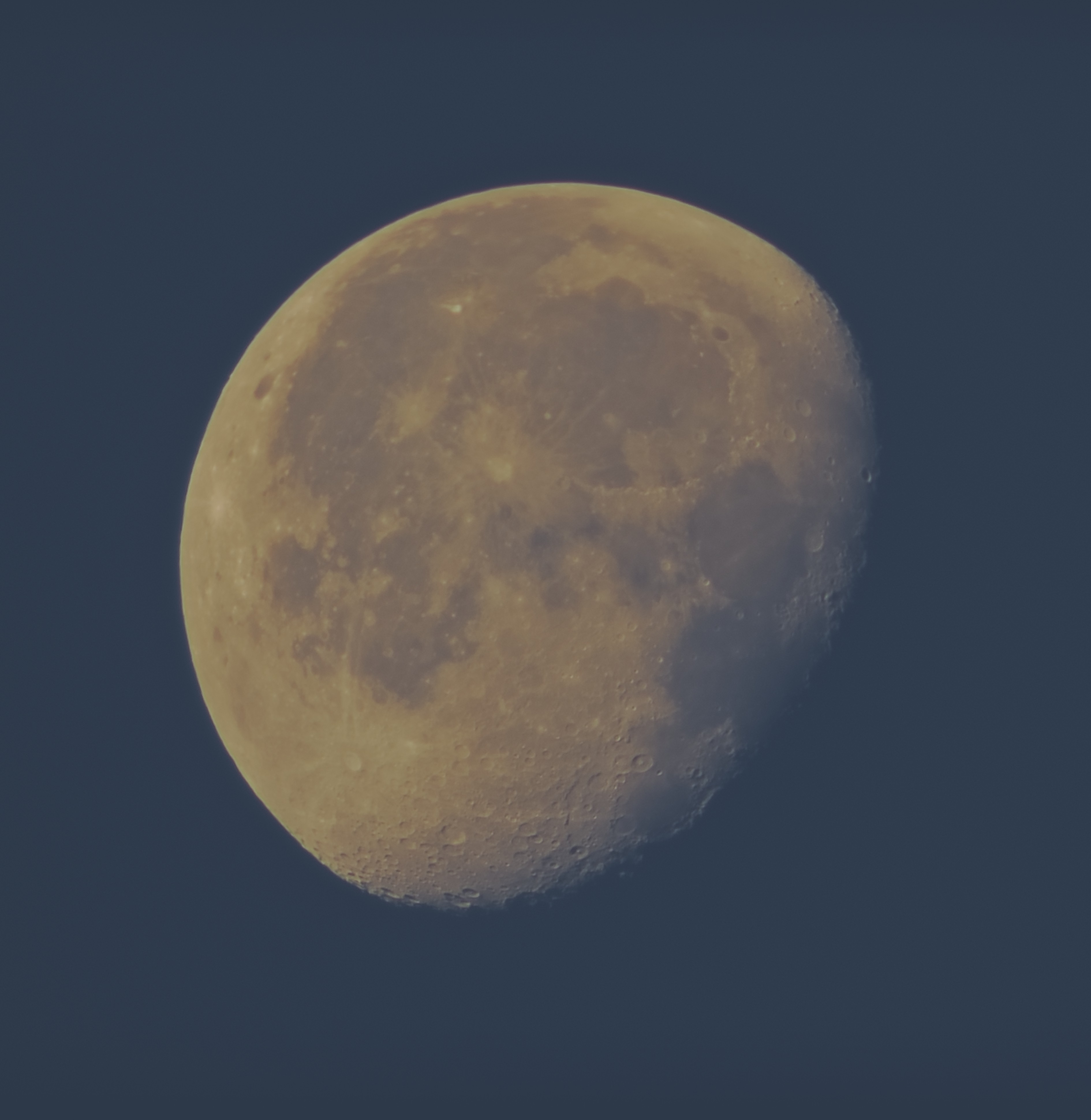
This month a nice straightforward image - or is it? A stack of fifty images of the moon early one morning.
Image of the Month for October 2018: The Garnet Star and the Elephant's Trunk
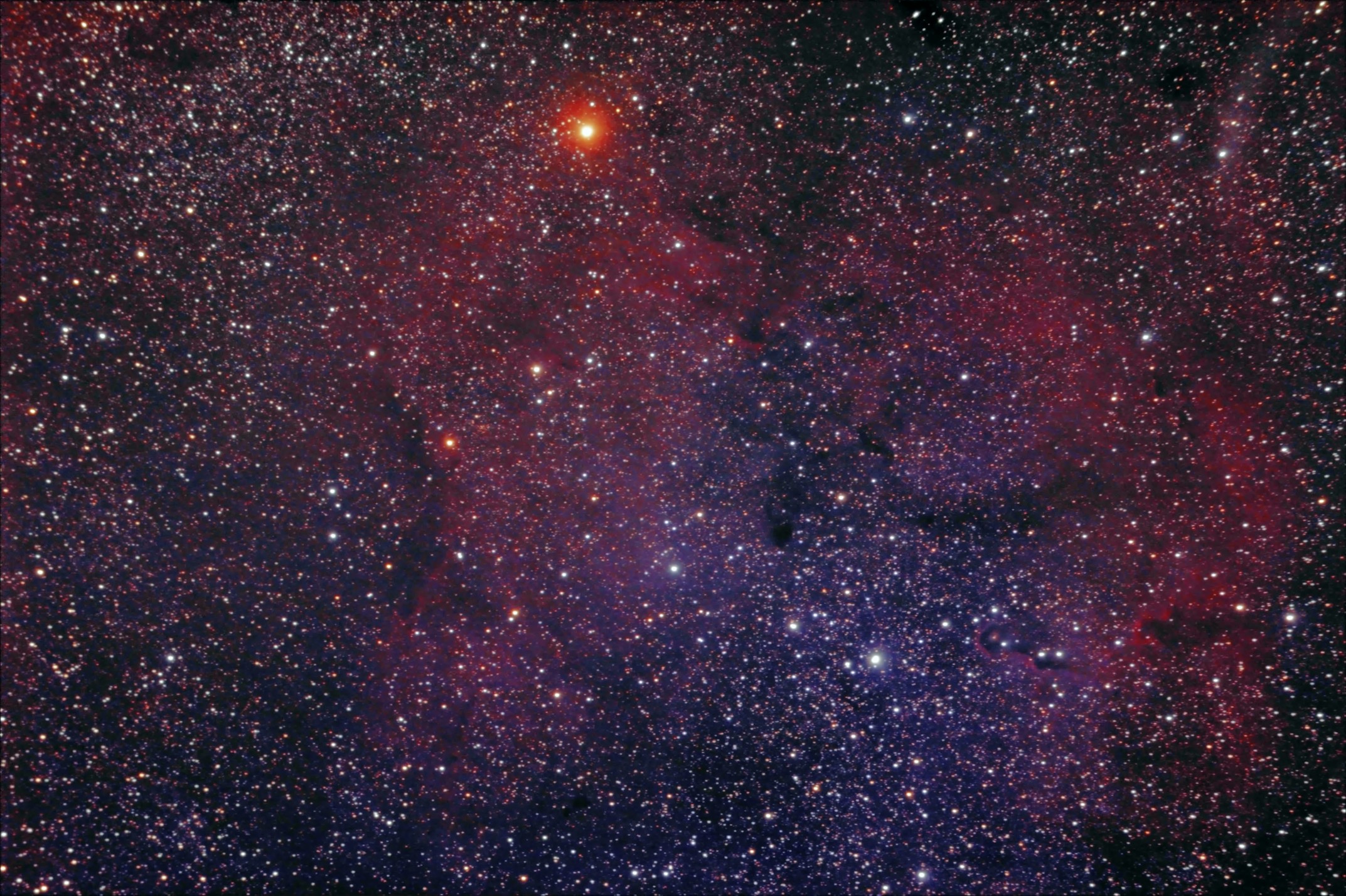
Seriously, who gets to make up all these names? Actually the Garnet Star, Mu Cephei, is possibly the reddest naked eye star in the sky and was described by William Herschel, who stated it has "a very fine deep garnet colour". The Elephant's Trunk, a dark wiggly patch near bottom right, requires more of a stretch of the imagination.
Image of the Month for September 2018: Nebulosity around Sadr in Cygnus
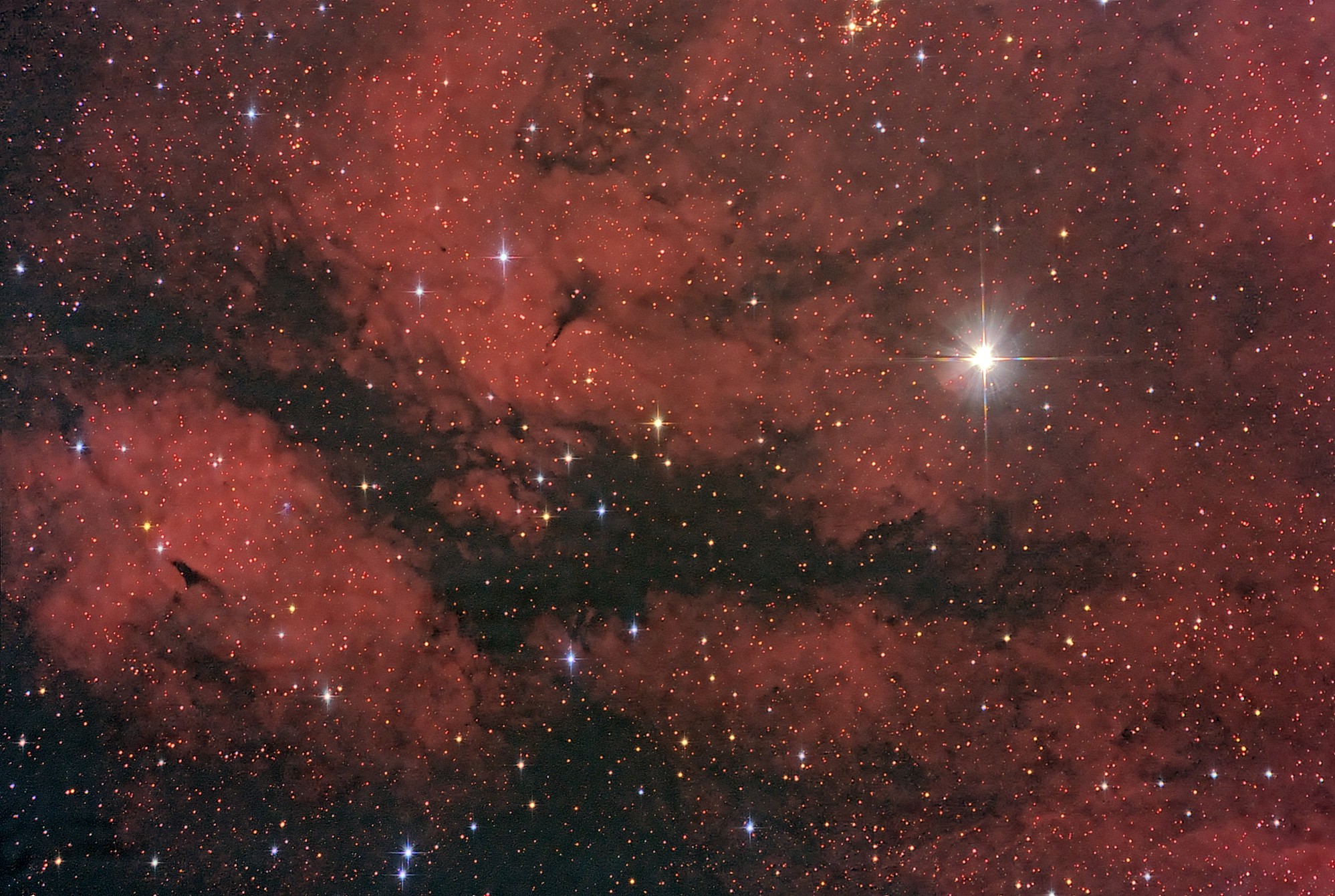
This image combines a one-shot-colour DSLR image taken on 4 August with a narrowband Hydrogen Alpha image taken on 31 August as the red channel..
Image of the Month for August 2018: The Planets - Sweet!
Over the summer I have been imaging these four planets, Venus, Mars, Jupiter and Saturn as they have all been in the favourable positions in the last few months. That said, Mars and Saturn have been very low, making imaging a challenge. A major dust storm has also stripped Mars of much of its detail, despite this being the closest approach it will make to earth for a century or so. Click the image for more detail.
Image of the Month for July 2018: Meteor!
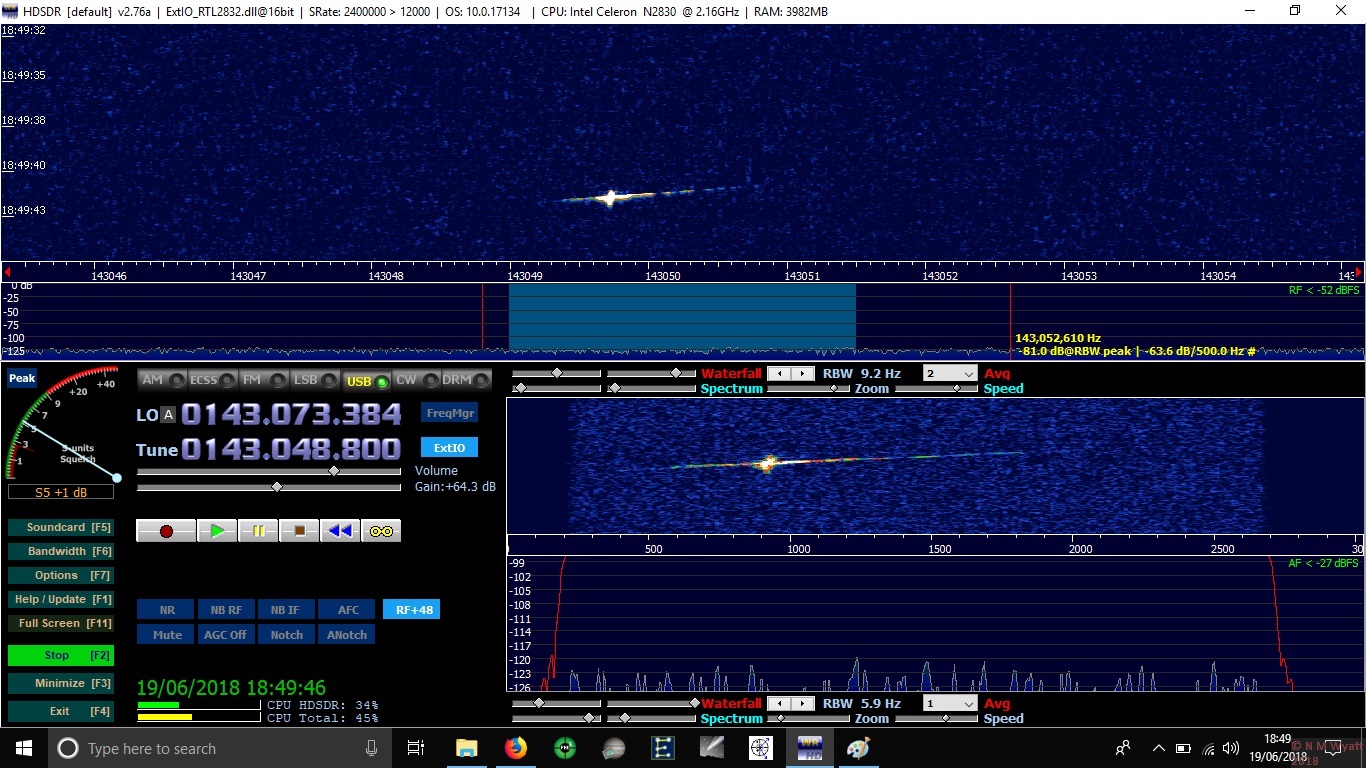
Something rather different this time, a meteor trail detected by picking up the return from the Graves Space Radar in southern France. The horizontal axis is frequency and the vertical is time. The 'blob' is the static trail left behind by the meteor, and the thin trail is the 'head' of the meteor moving across the sky and dropping in frequency due to doppler shift. This was probably an 'Arieted' meteor coming in low from west.
Image of the Month for June 2018: Io transiting Jupiter
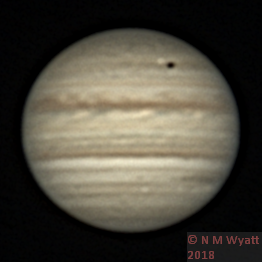
The moon Io pases in front of Jupiter, casting its shadows on the clouds below, on 5 May 2018.
Image of the Month for May 2018: Markarian's Chain
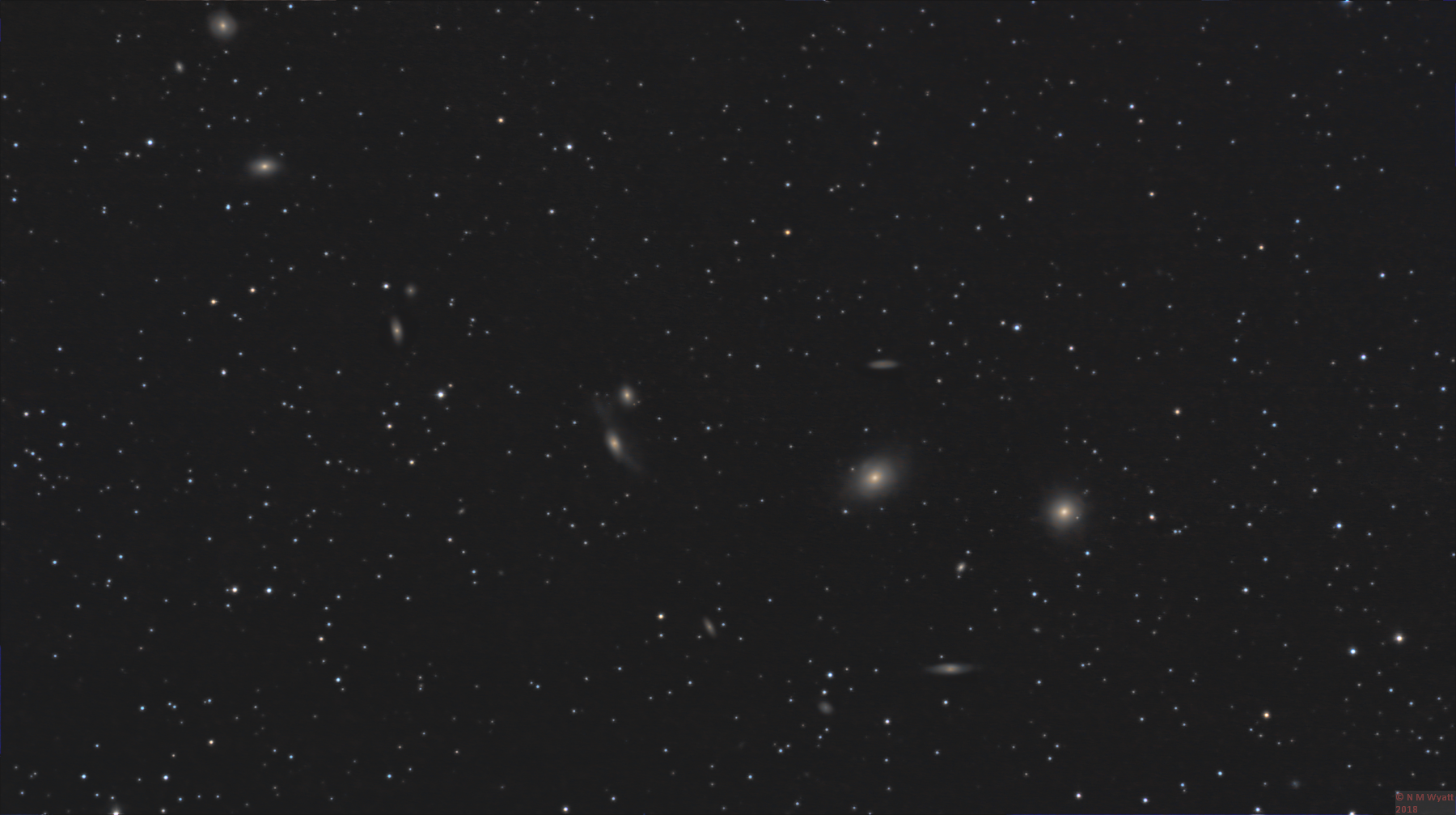
Revisiting the subject of an earlier image of the month, Markarian's Chain, with much more natural colour and greater detail, delivered by a combination of cooling, guiding and longer total exposure.
Image of the Month for April 2018: The Lunar X and V in Colour
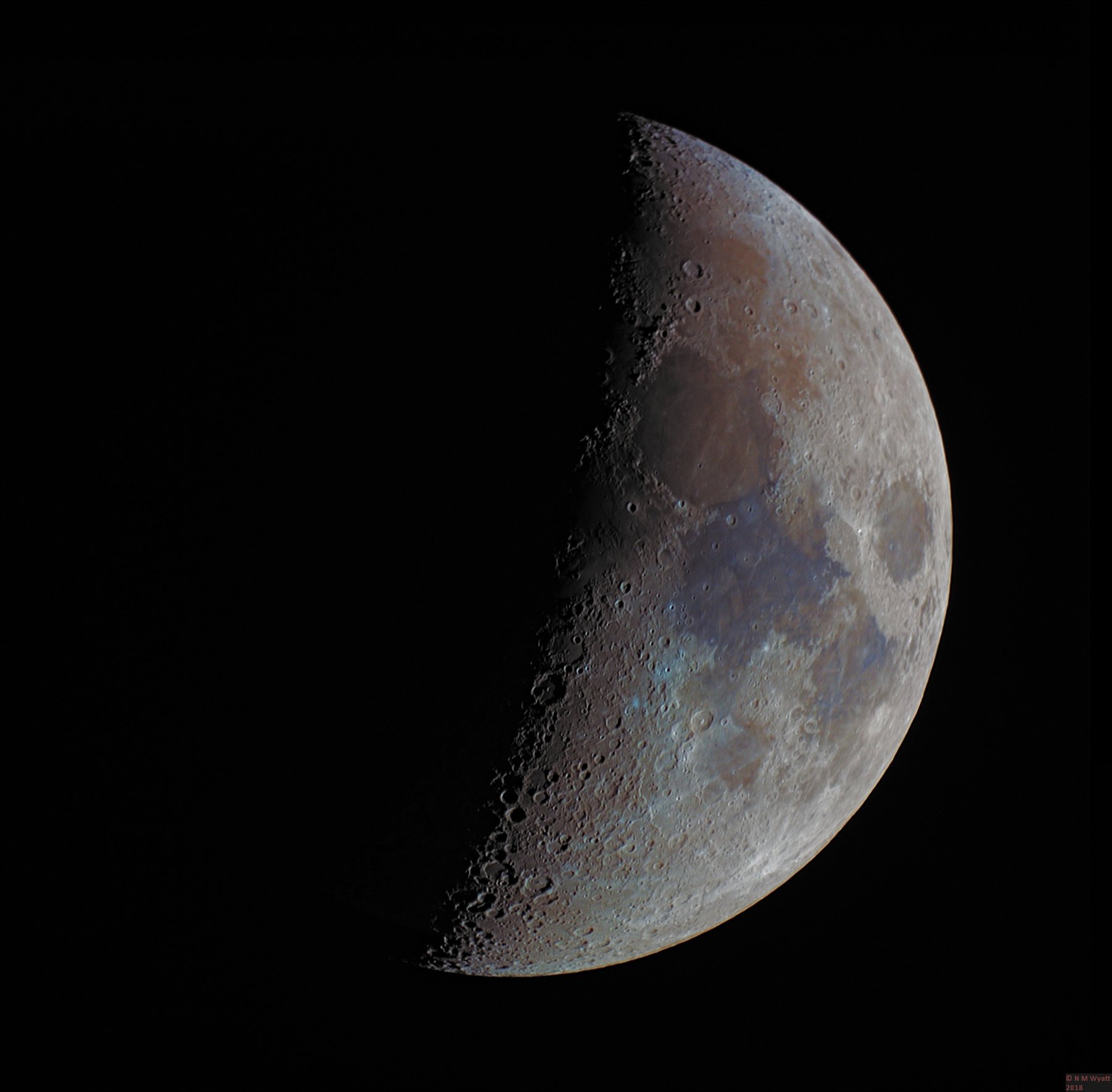
In February it was almost perfect observing conditions for the two well-known ‘lunarisms’ the ‘X’ and ‘V’. These are both effects caused by crater rims/ridges that reach up above the lunar shadow. They can both be seen along the lower part of the lunar terminator (the line between light and shadow).
I used my astro-modded and cooled Canon 450D (although the cooling was switched off) with a Celestron C90 Maksutov on a hybrid bresser/skywatcher EQ mount. Despite being a small scope this gives a near ideal match of resolution with sensor so works well for the bright moon, with the advantage that distortion due to poor seeing is minimised compared to my larger newtonian.
98 RAW frames were pre-processed in PIPP using AHD debayering and preserving the colour information to give centred and cropped 16-bit TIFFs.
These were stacked in Autostakkert3! using rather large (200 pixel) boxes. 60% of frames were stacked. The resulting image was duplicated. One was processed as a ‘conventional’ mono image with a relatively light hand – adjustment of curves to reduce the contrast between the rim and terminator, noise reduction was unnecessary, followed by Lucy-Richardson deconvolution. As the image was already sharp a combination of a small kernel with stronger than usual deconvolution was successful and did not create artefacts, notably no ringing was created along the rim, often a problem with deconvolution.
The second image was also adjusted to reduce contrast and using a temporary high-saturation layer the colour balance was adjusted, the main requirement being reducing the red content to compensate for the astro-modification of the camera. The high saturation layer was then removed. Cycles of a soft light + luminance layers process to gently increase saturation were applied – this approach is less likely to ‘blow out’ colours and keeps them more faithful than simply increasing saturation.
The mono version of the image was then applied over the colour one as a luminance layer and merged down.
I am very pleased with the final image as it captures one of the classic moments in the moon’s monthly phases and faithfully demonstrates the faint colours of the lunar surface without over exaggerating them.
Image of the Month for March 2018: The Horsehead and Flame Nebulas in Ha
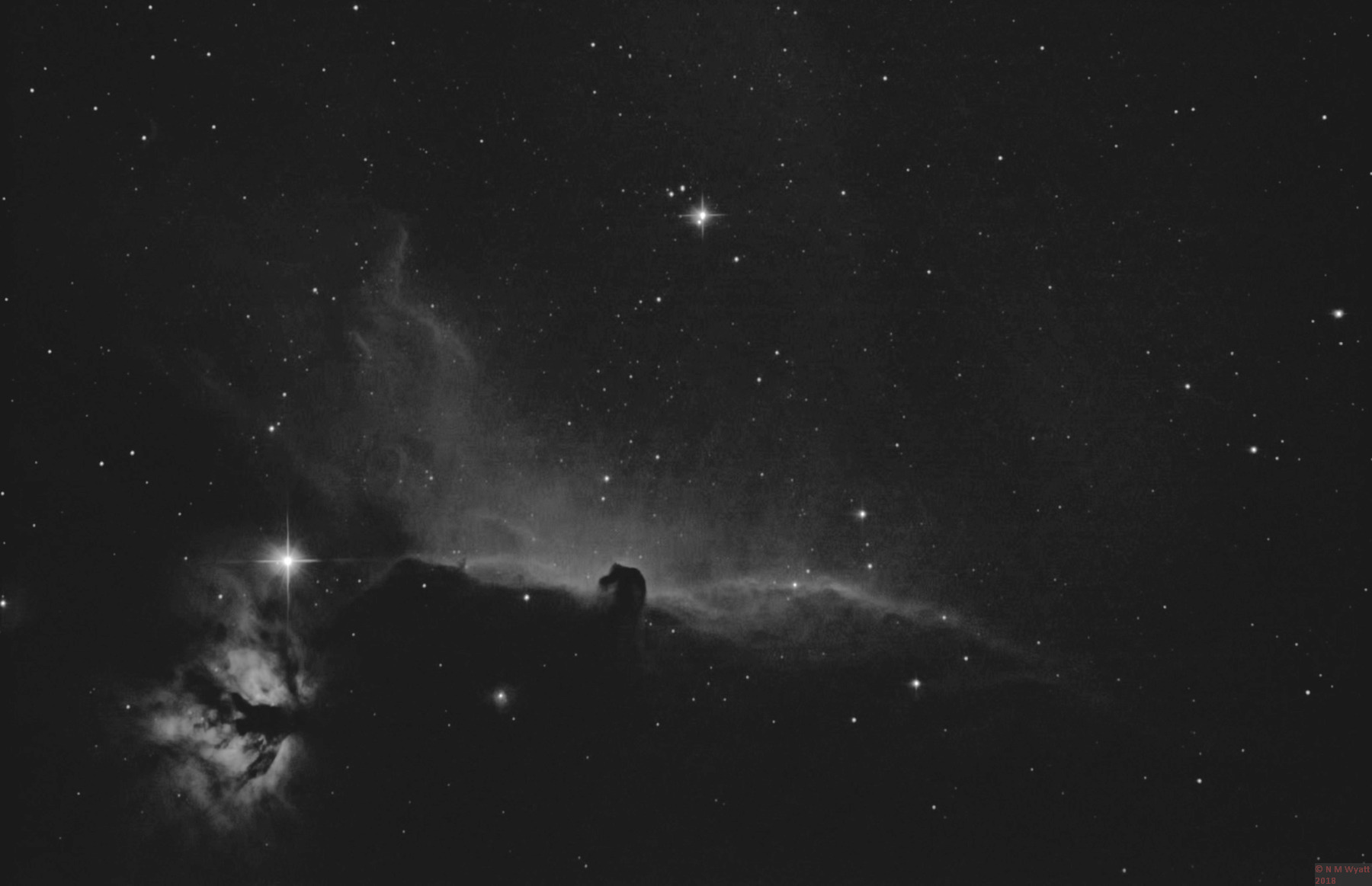
This is a 7nm hydrogen alpha narrowband image taken using a cooled and astromodified Canon 450D with a special Baader filter.
Image of the Month for February 2018: The Rosette Nebula
Revisiting one of the most remarkable objects in the sky, blending a 7nm hydrogen alpha narrowband image with a one-shot colour image, both taken with the modified and cooled Canon 450D. Using the Ha layer reduces the stars (small ones disappear) and highlights the nebula which is composed of hot hydrogen.
Image of the Month for January 2018: The California Nebula
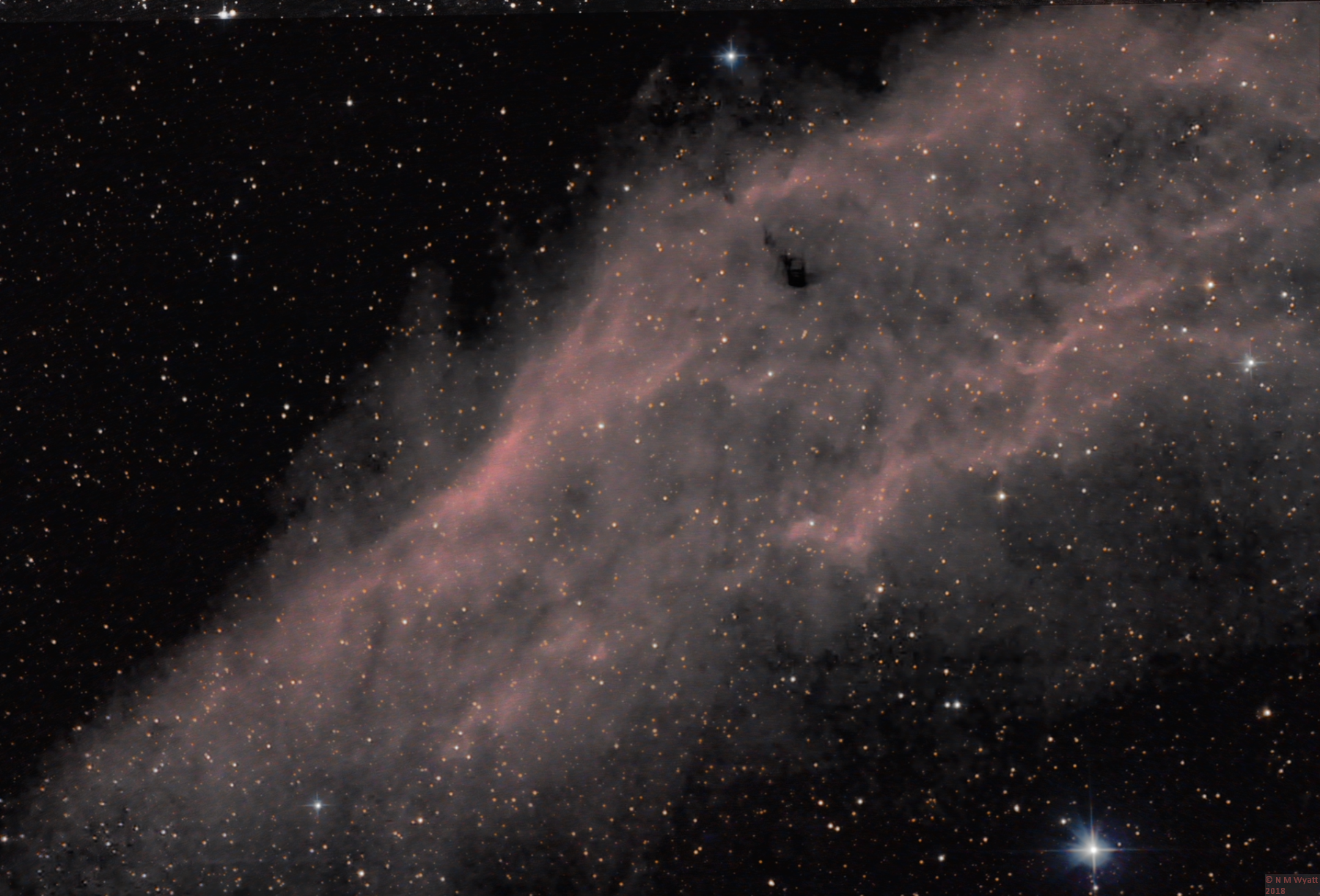
The California Nebula, a narrowband Ha image combined with a one-shot colour image.
- Details
- Category: Images of the Month
2021 : 2020 : 2019 : 2018 : 2017 : 2016 : 2015
December 2015 - The Orion Nebula, M42
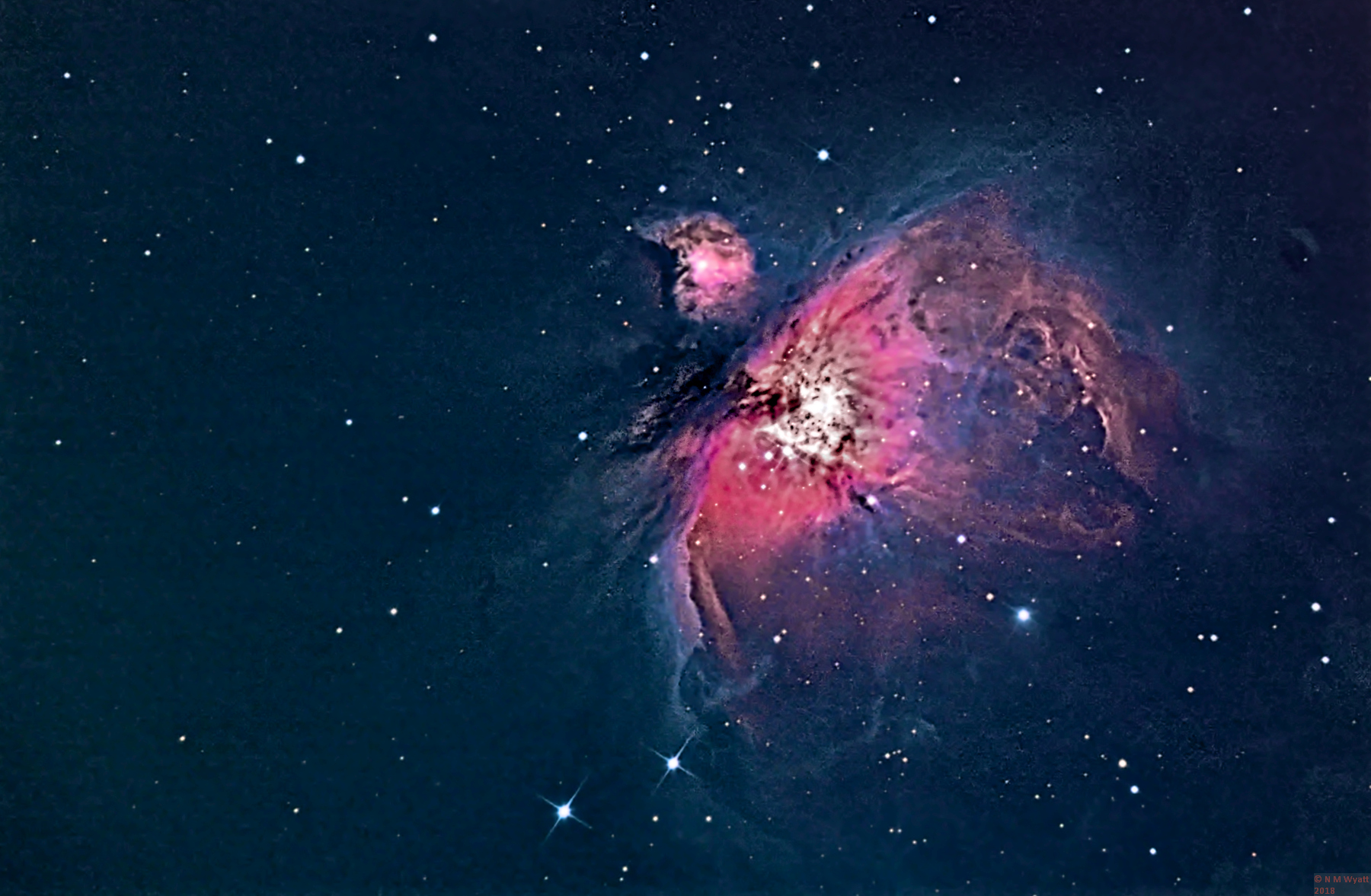
November 2015 - The Andromeda Galaxy, M31
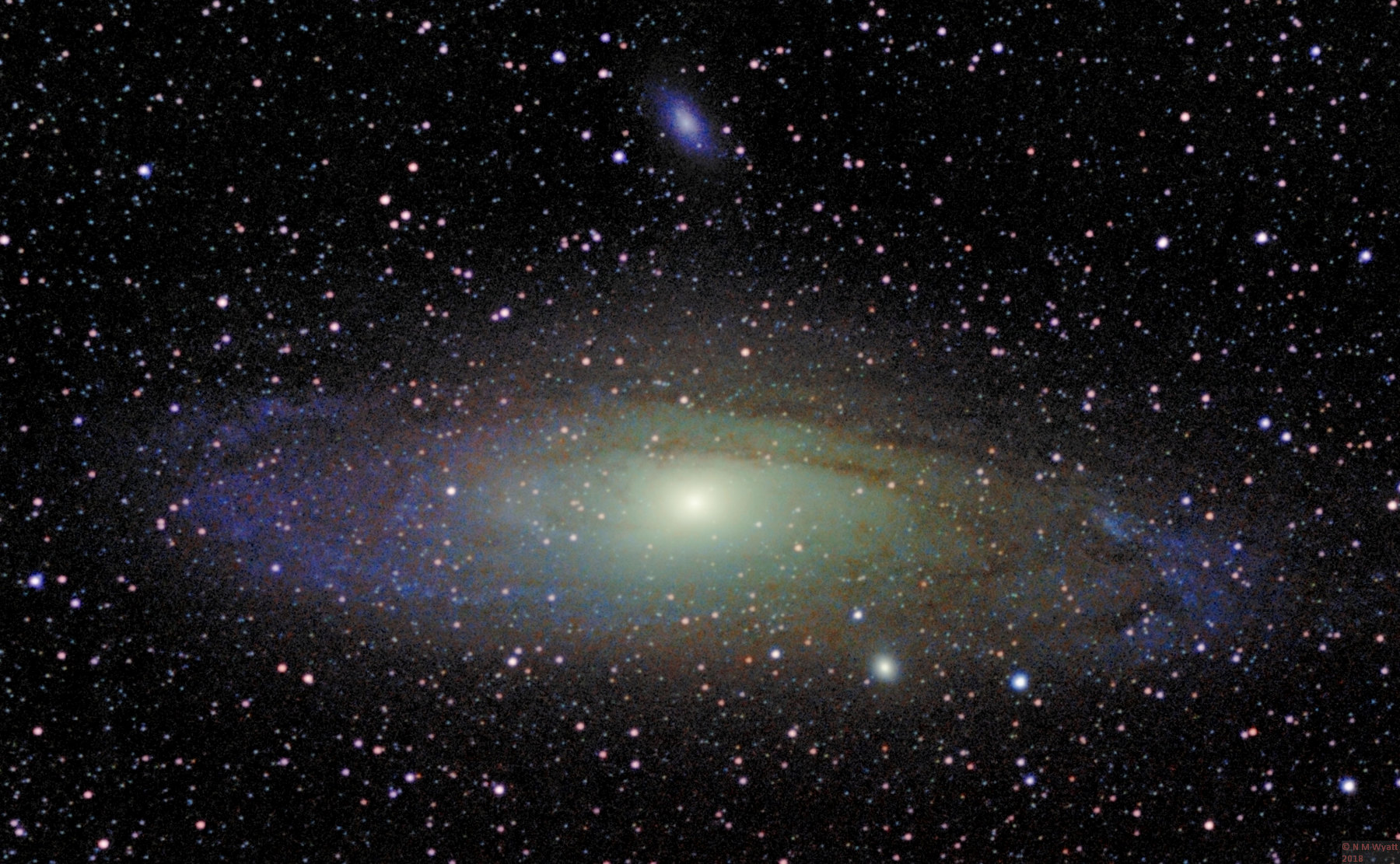
October 2015 - The Pelican Nebula
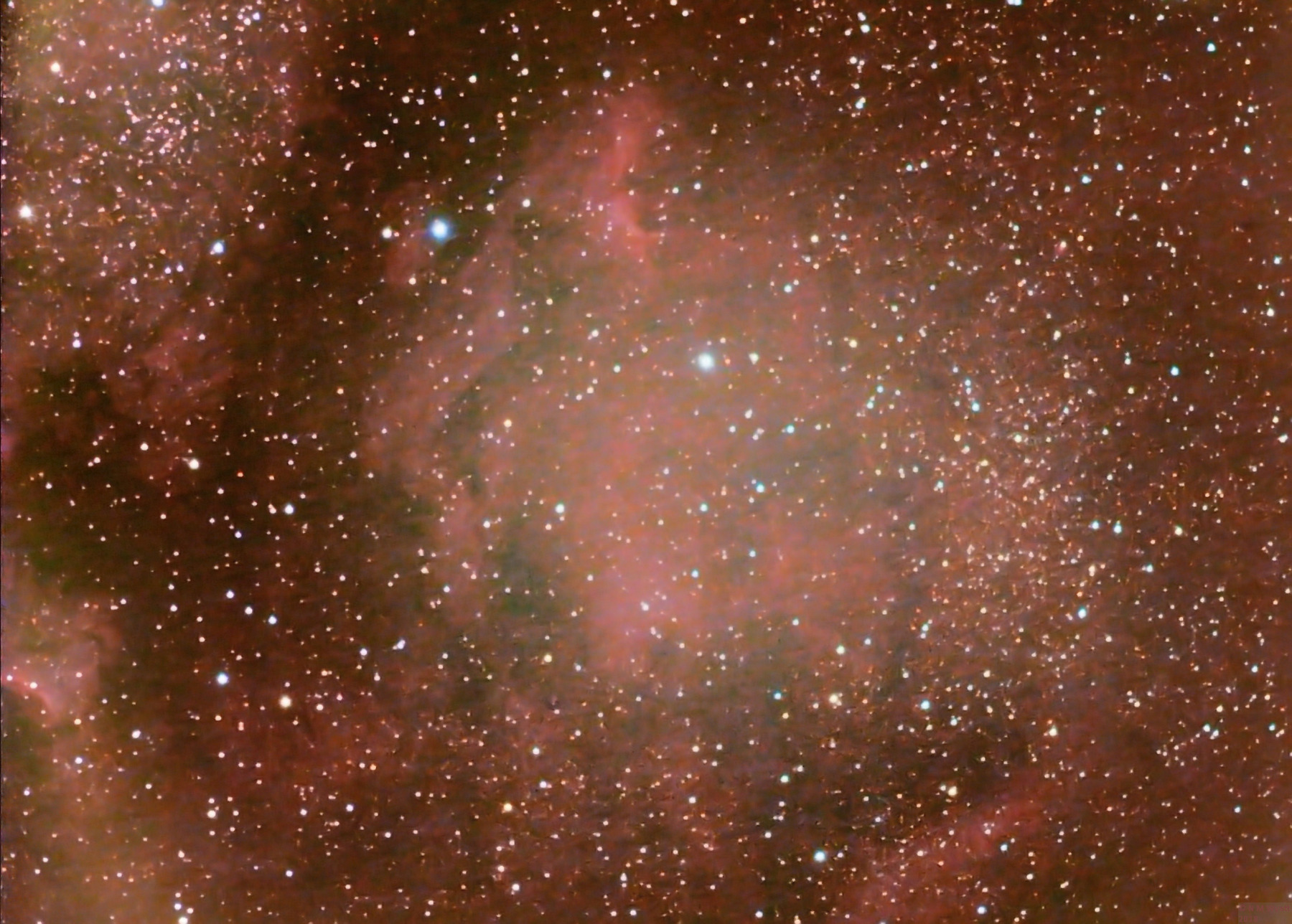
September 2015 - Lunar Eclipse and the Stars
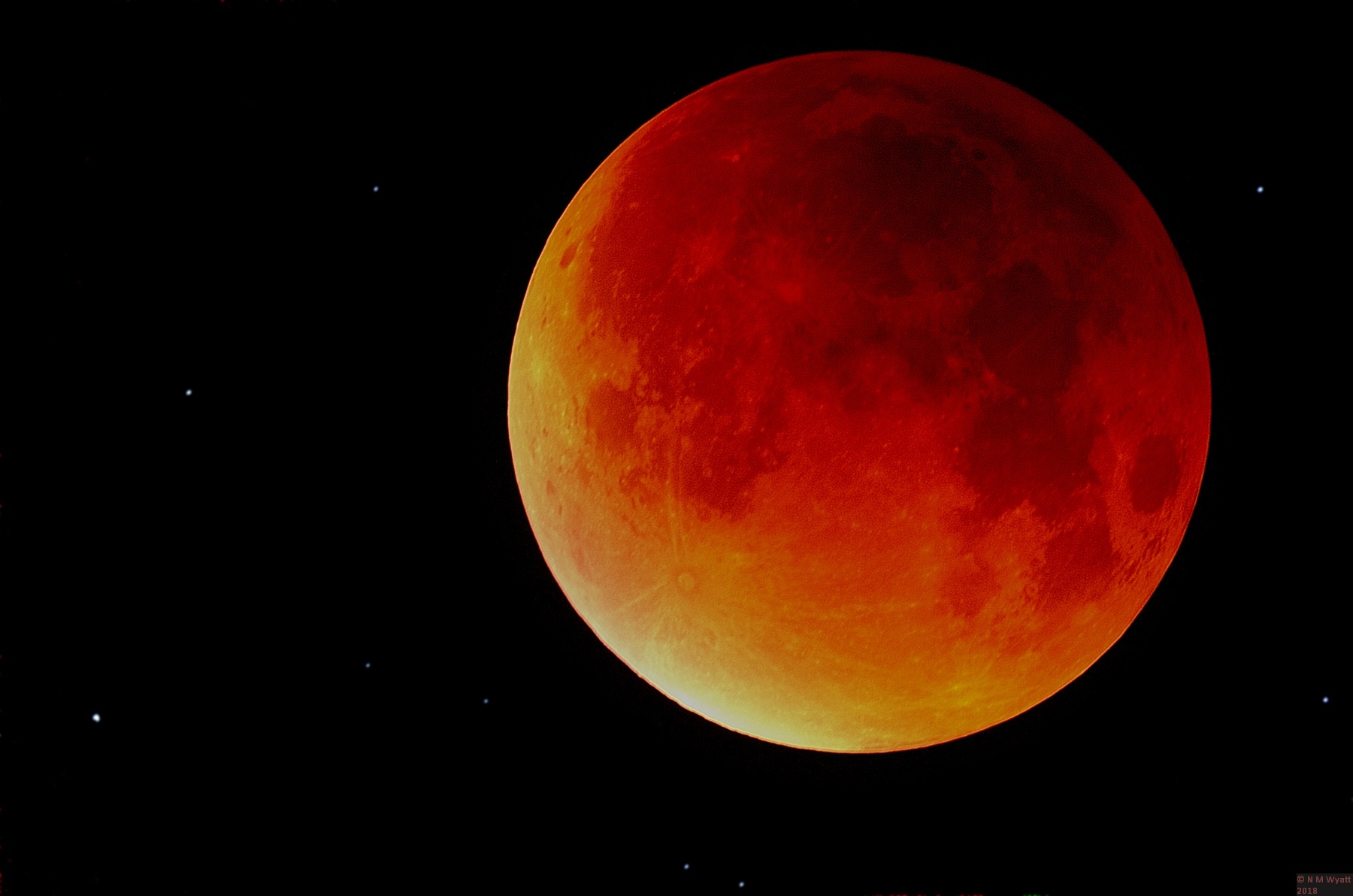
August 2015 - Sunspots
July 2015 - M57 The Ring Nebula
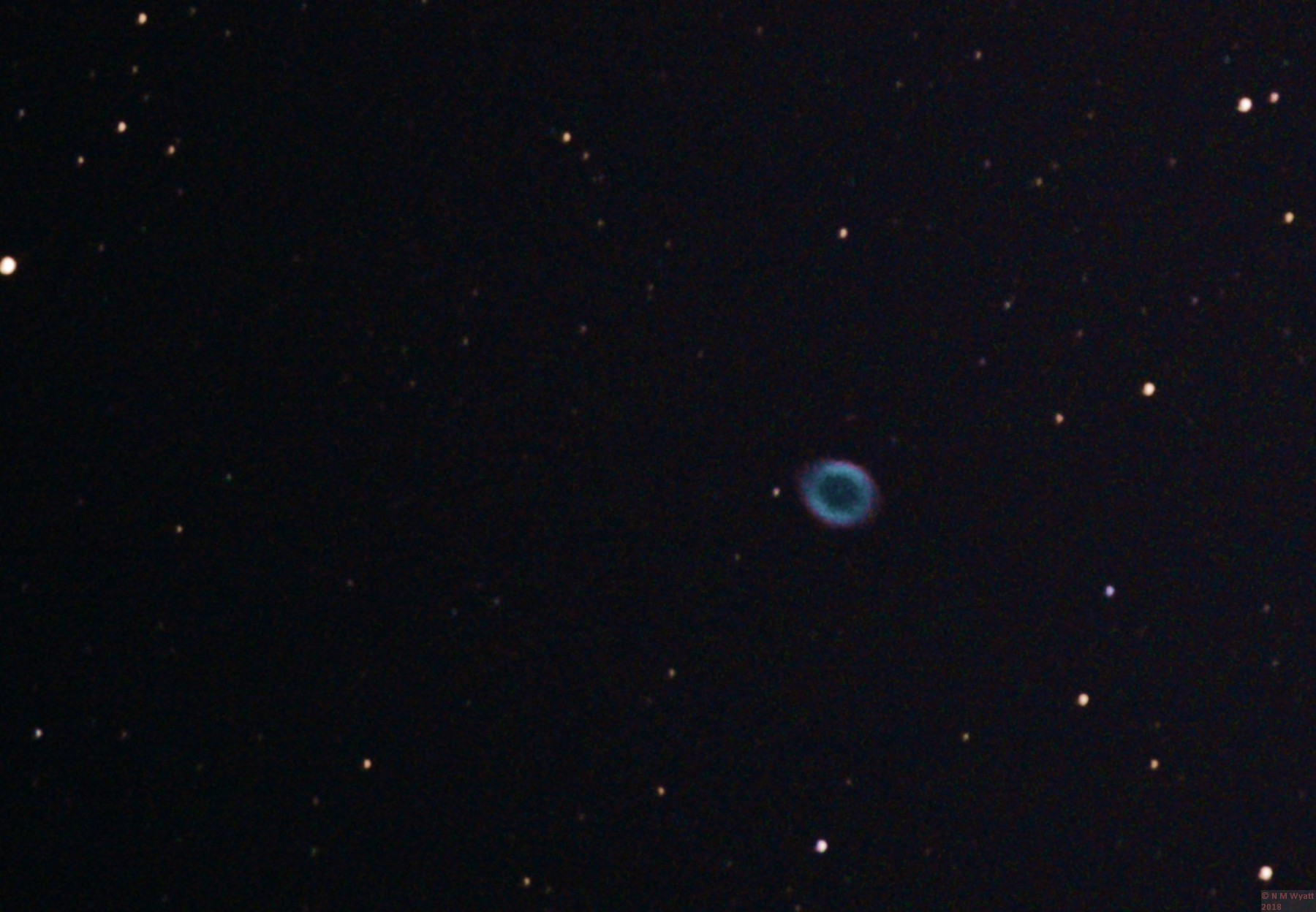
June 2015 - The Plough
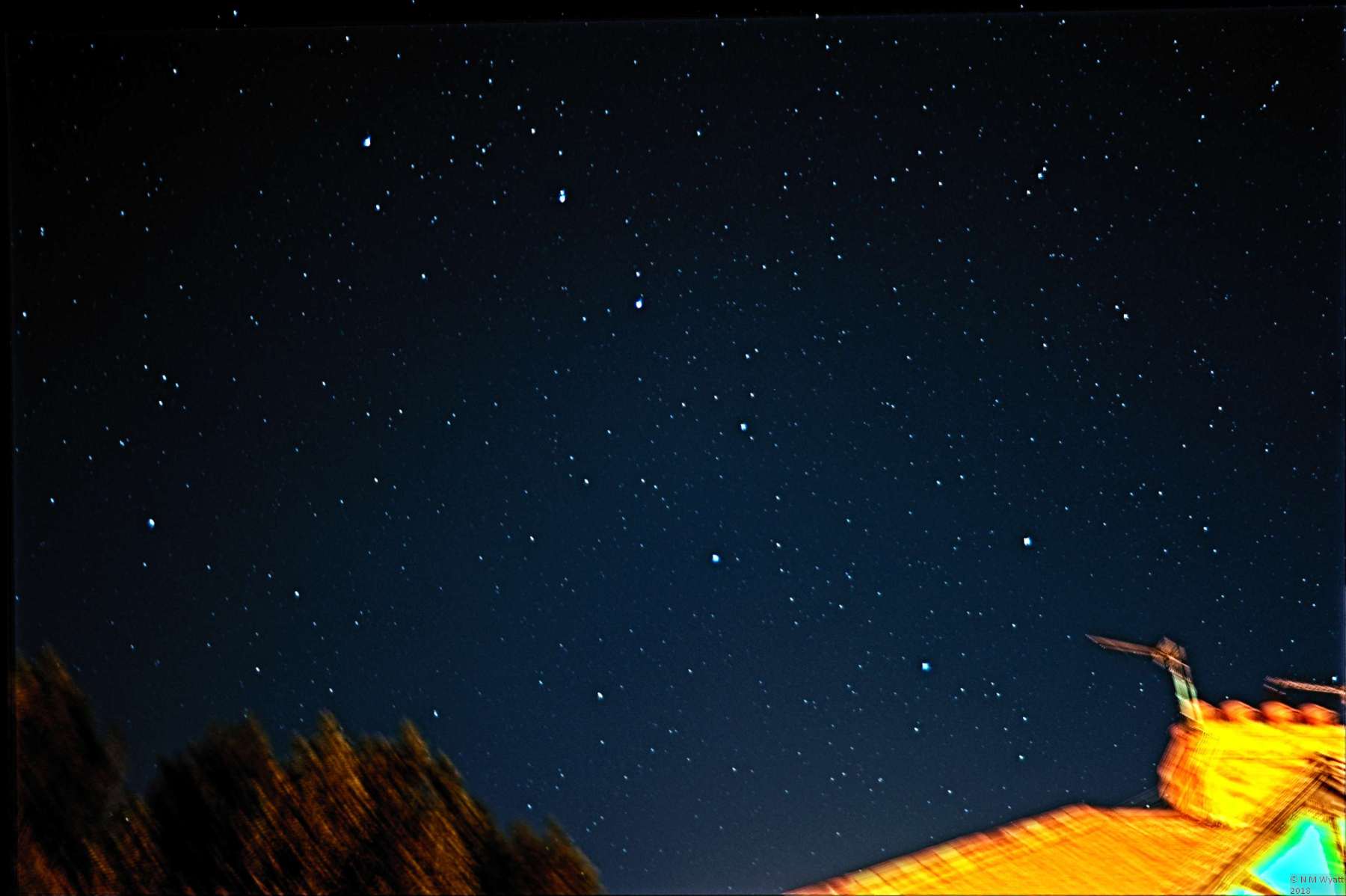
May 2015 - Saturn
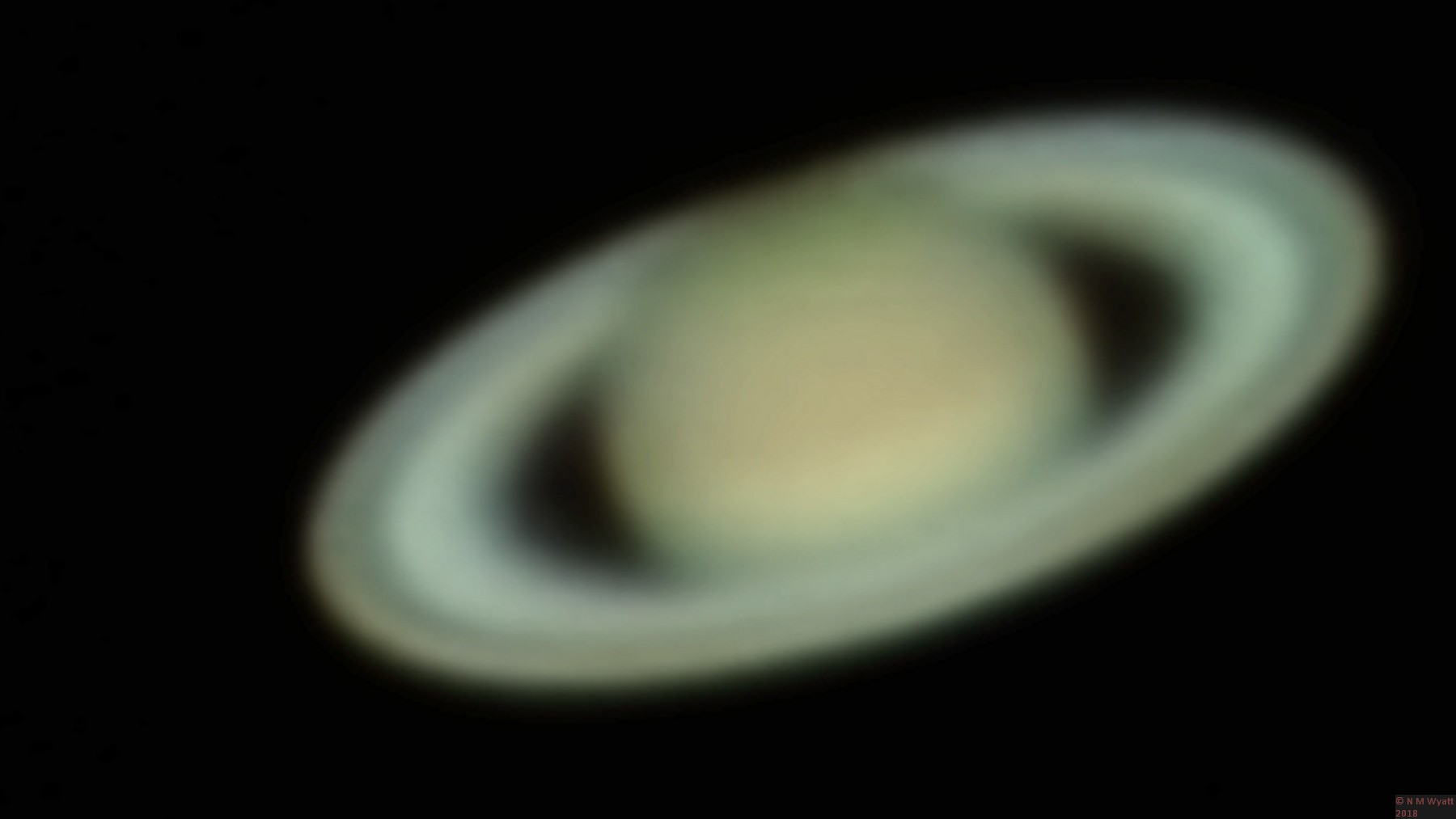
April 2015 - Venus
March 2015 - Solar Eclipse
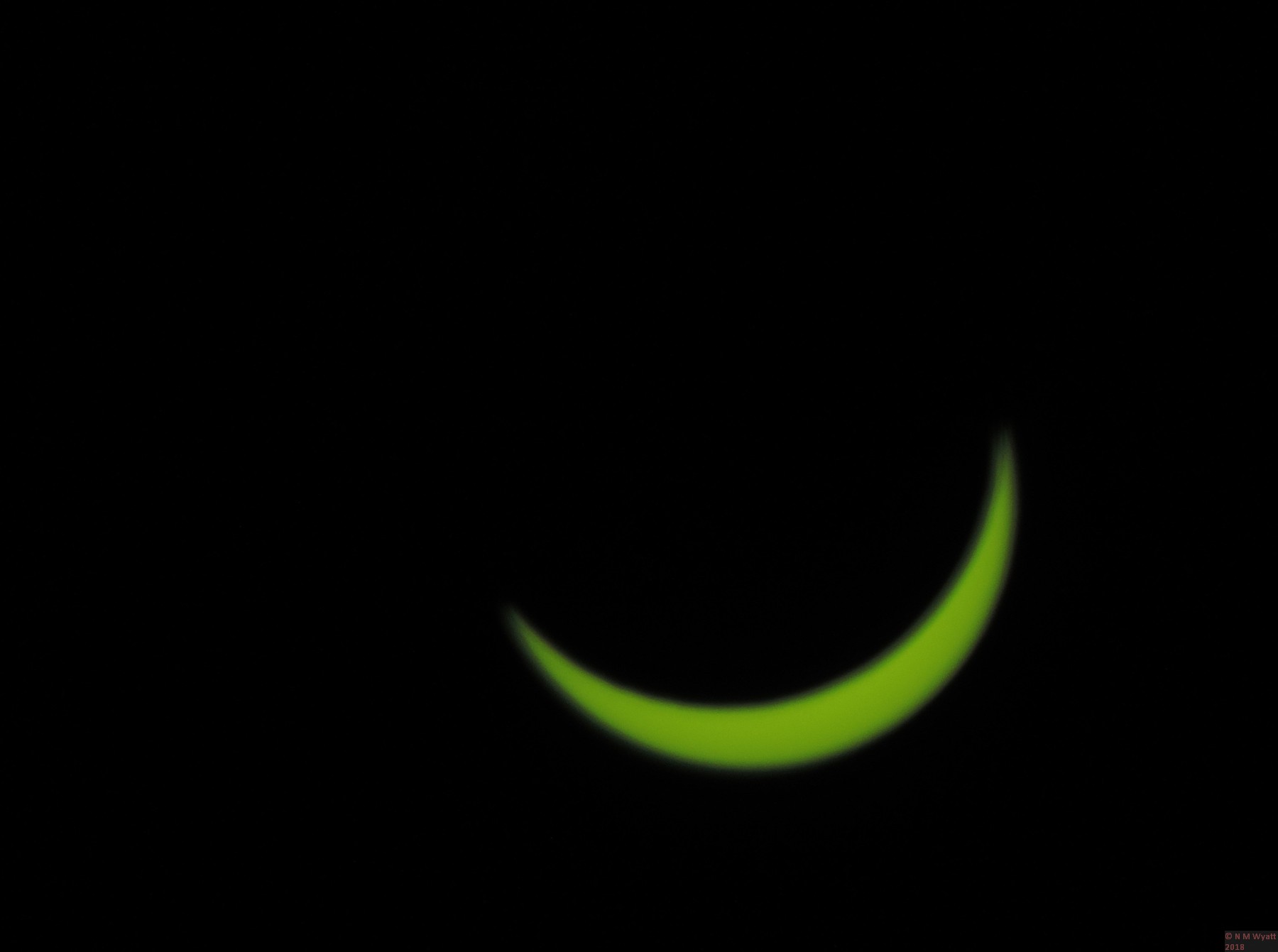
December 2014 - Lunar Halo
October 2014 - In the Night Garden
September 2014 - Oscar, Night Cat
August 2014 - Moon in a blue sky, single frame
June 2014 - The Solar System with a bridge camrea
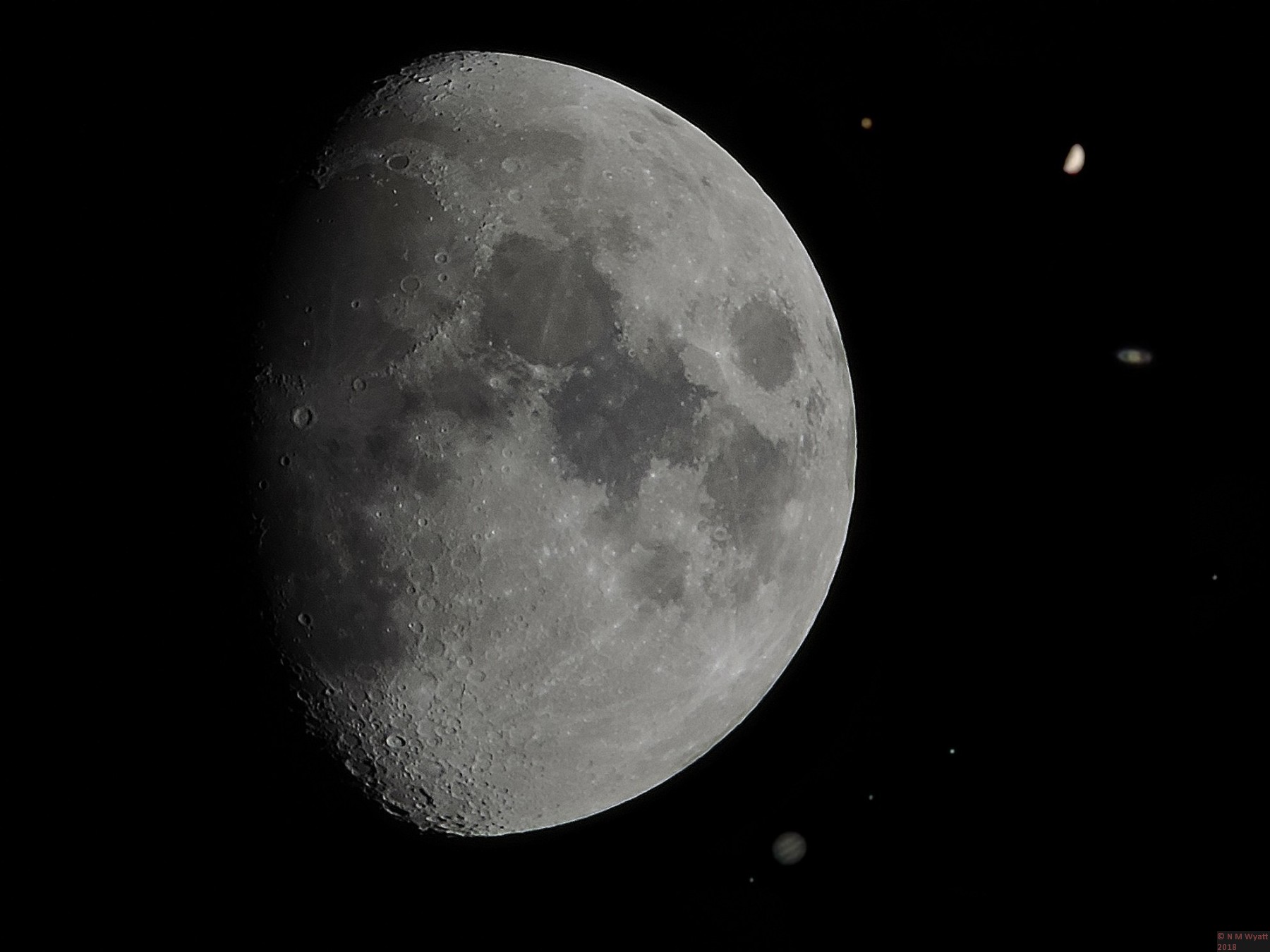
April 2014 - Mars with a bridge camera and stacking
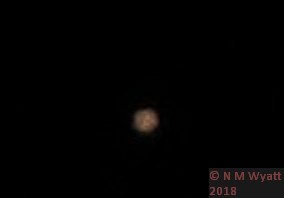
March 2014 - Saturn, with a bridge camera and stacking
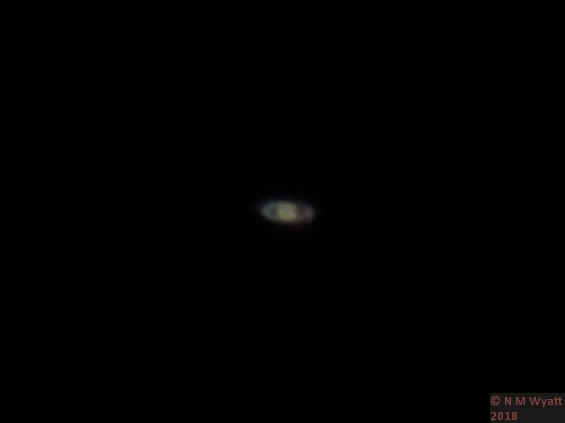
February 2014 - The Moon from Skye
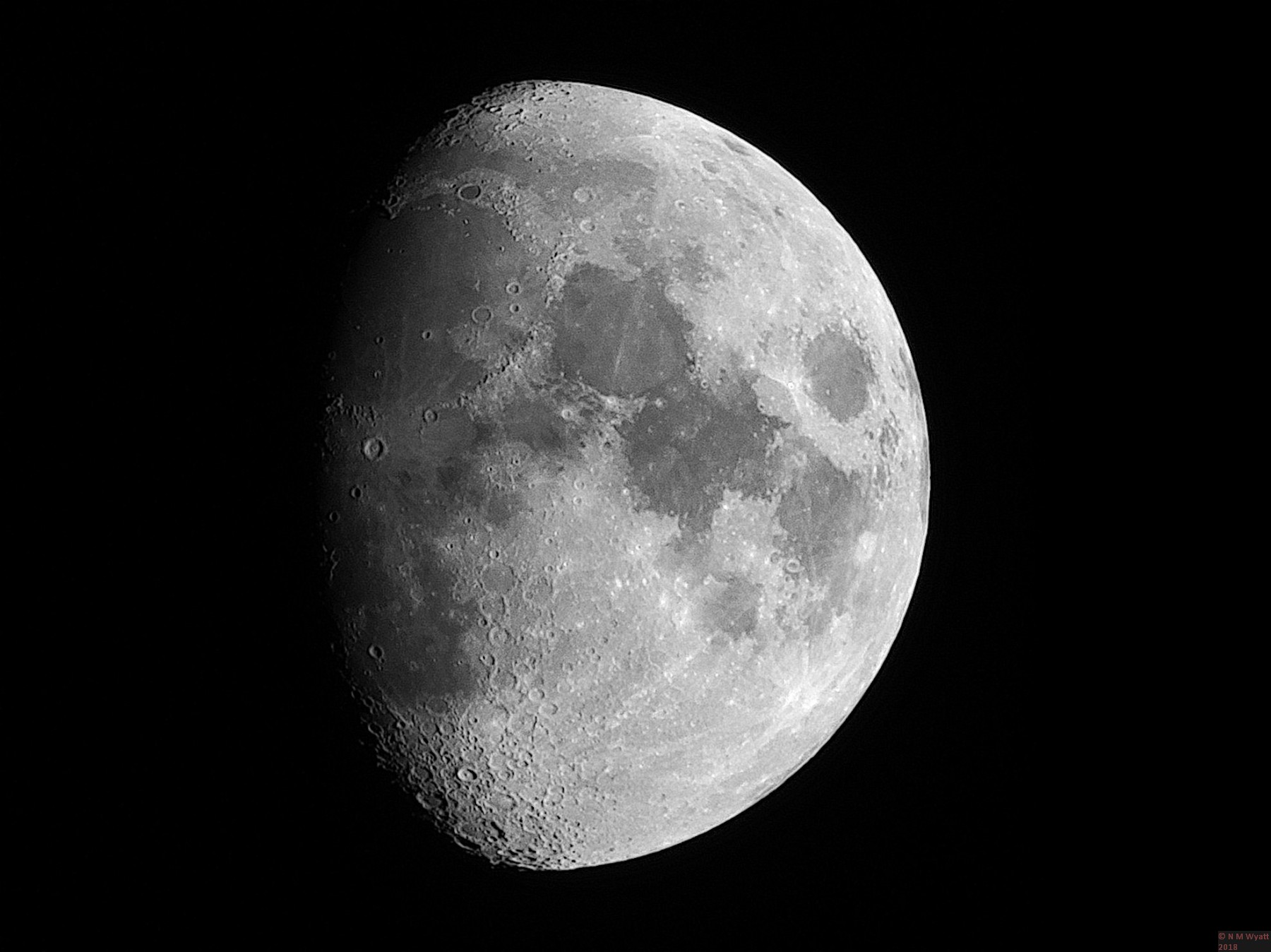
- Details
- Category: Images of the Month
Page 1 of 2


